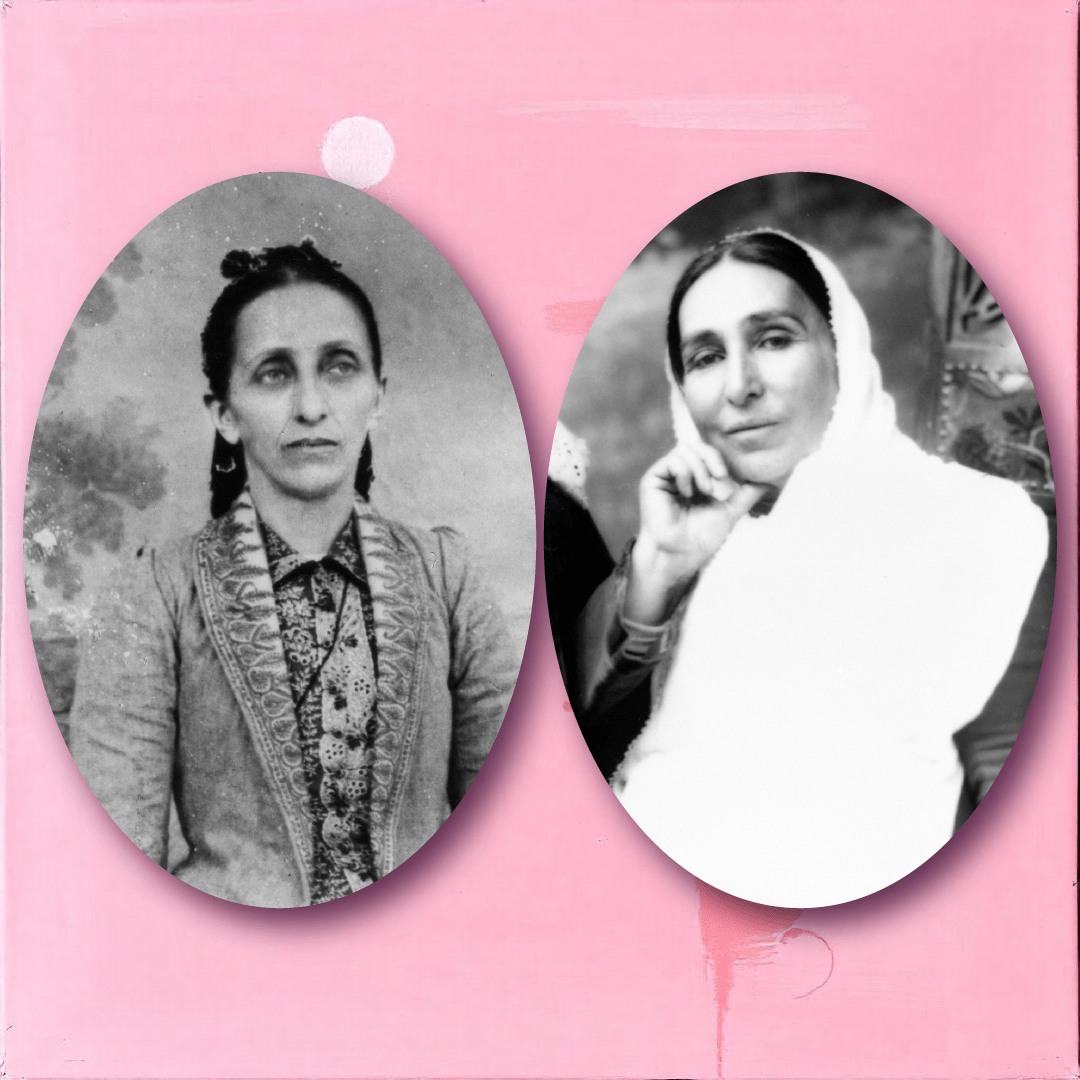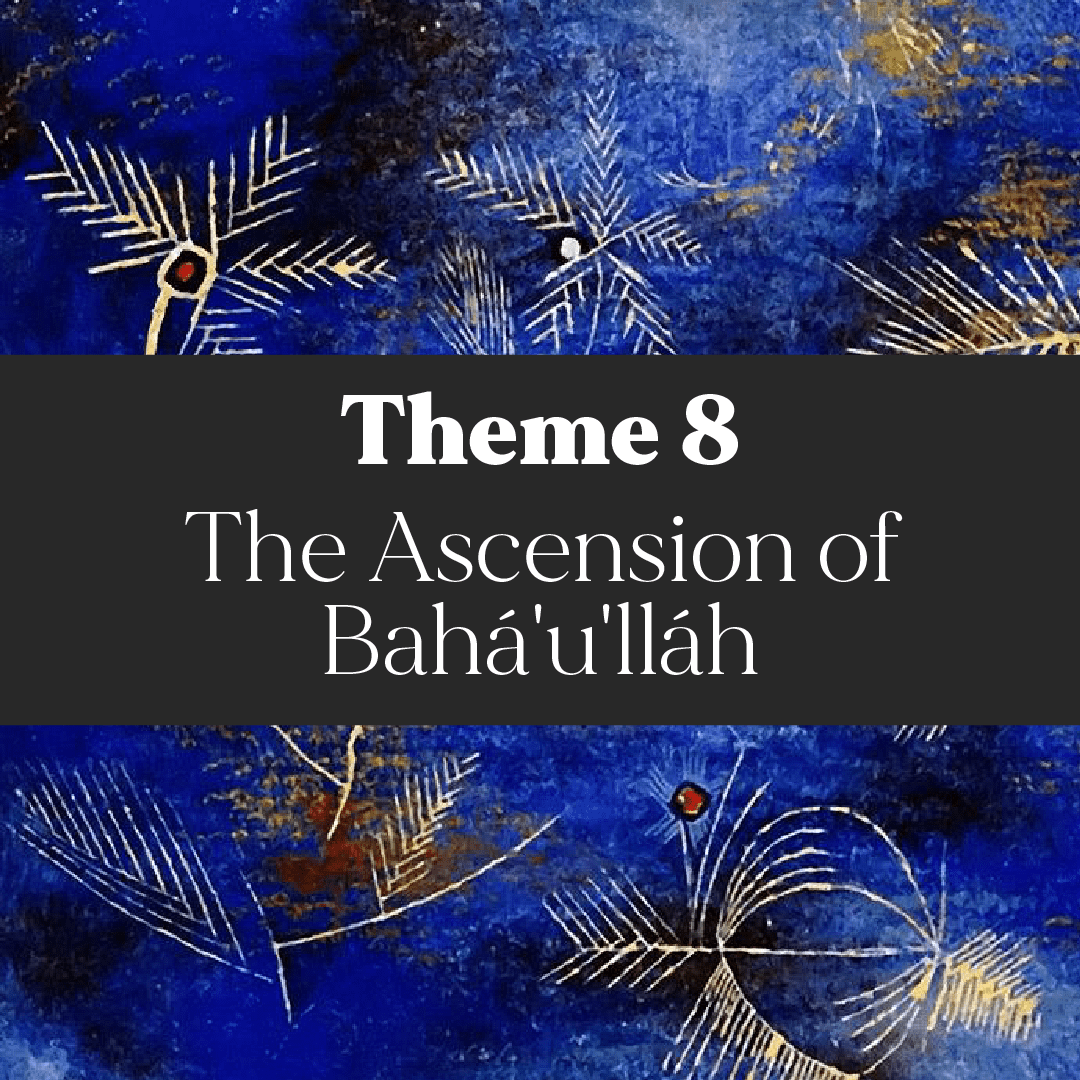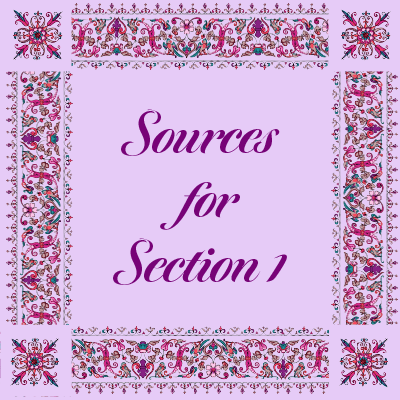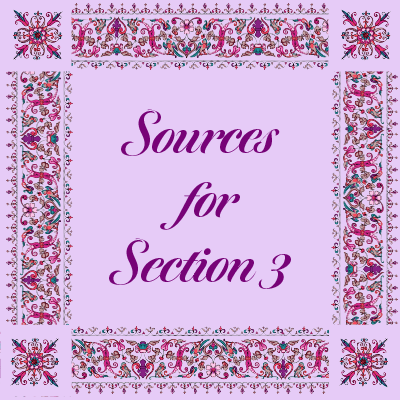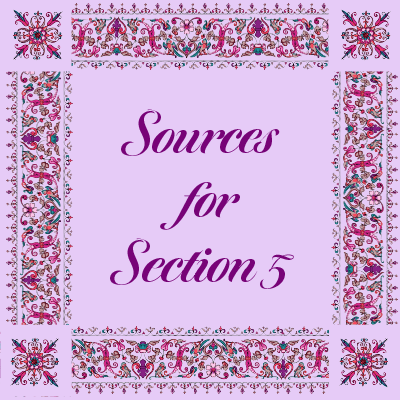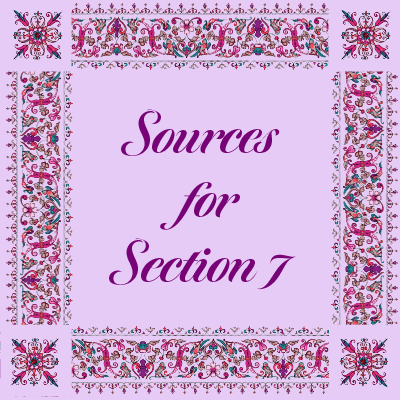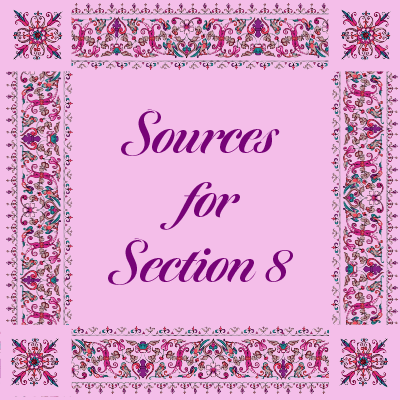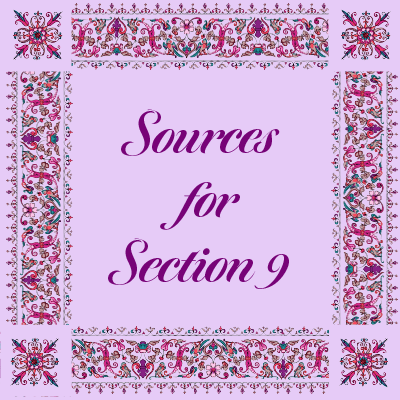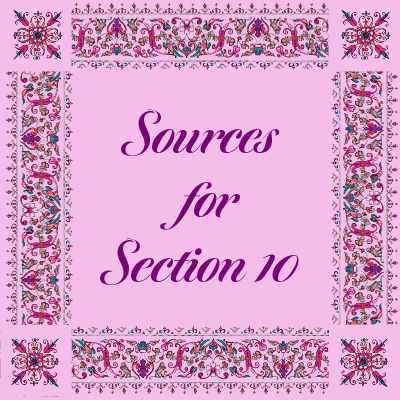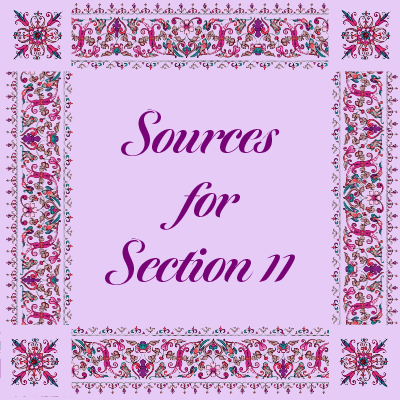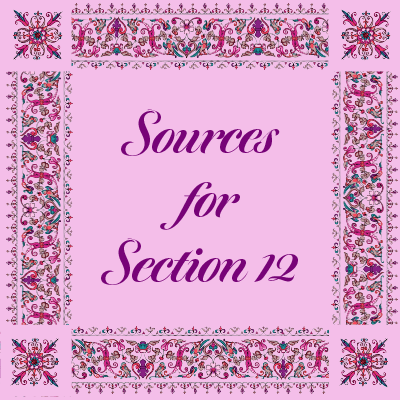
Written and illustrated by Violetta Zein
This part covers the passing of the Greatest Holy Leaf at the age of 86 in 1932.
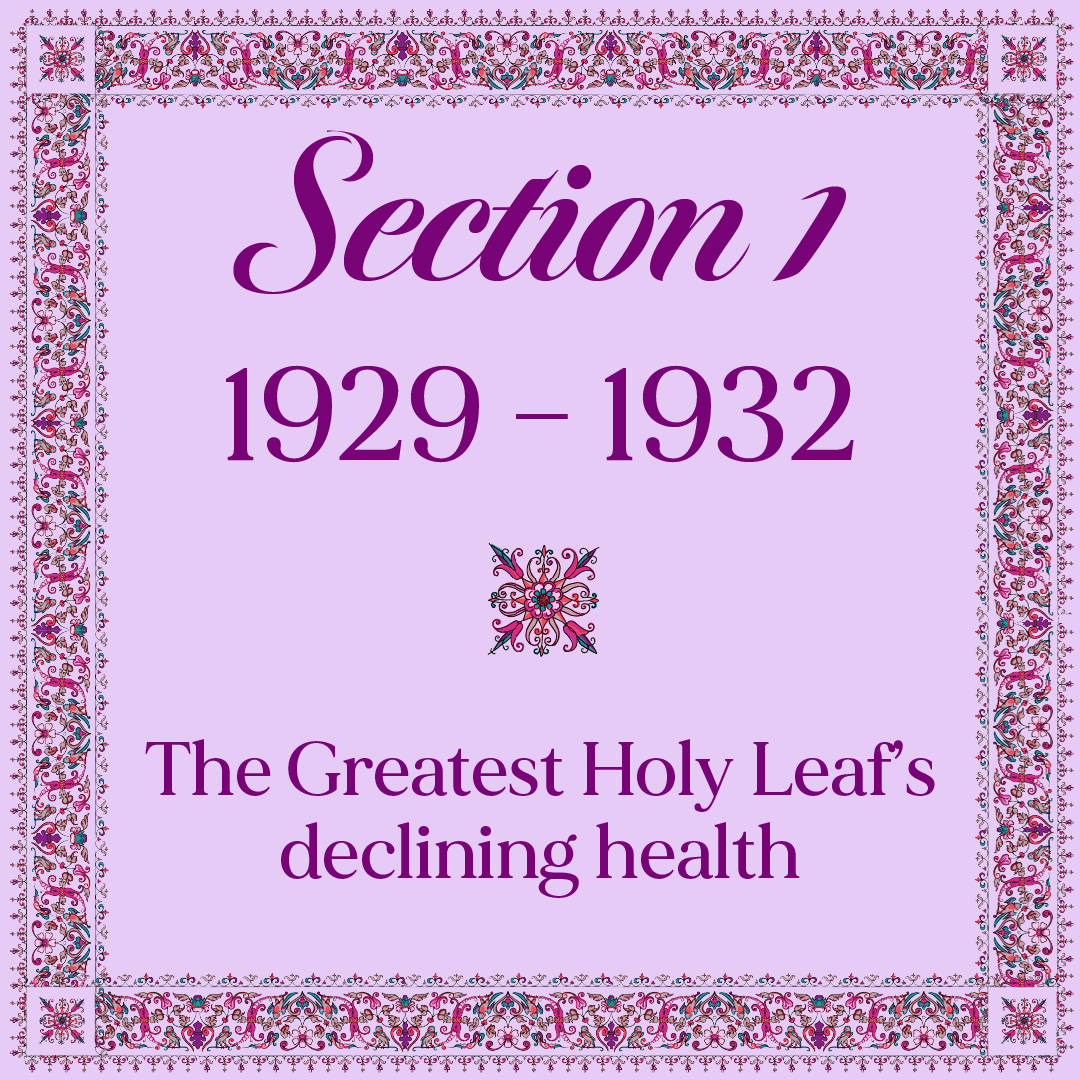
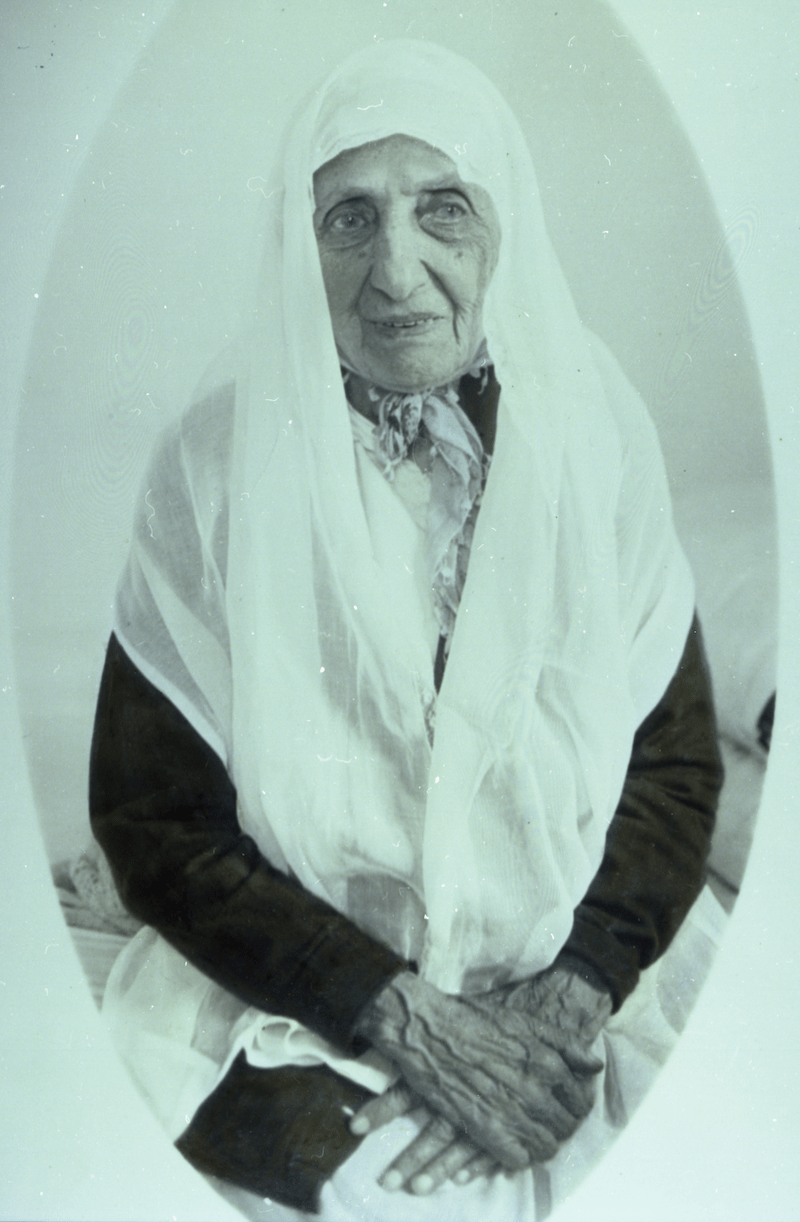
This is the last photograph ever taken of the Greatest Holy Leaf by Effie Baker. It was first published in The Bahá'í World Volume 5 (1932-1934) on page 170. This extraordinary quality print in color, where you can see the blue eyes of the Greatest Holy Leaf and light blue on the scarf around her neck is courtesy of the United States National Bahá'í Archives.
For at least three years prior to her passing, Shoghi Effendi was keenly aware that his pillar and sole support, his beloved great-aunt, the Greatest Holy Leaf was approaching the last years of her earthly life. Bahíyyih Khánum was increasingly frail, her eyesight was failing, her strength was declining, and she had been asked by doctors to stay confined to her bed.
The Guardian’s awareness of this is evident in two letters he sent to the Bahá'ís of the United States and Canada in 1929 and three years later, in 1932.
On 25 October 1929, the Guardian explained to the Bahá'ís of North America that one of the Greatest Holy Leaf’s last earthly wishes was the restarting of the work of the Mother Temple of the West:
Neither do I need to expatiate upon the hopes and fears of the Greatest Holy Leaf, now in the evening of her life, with deepening shadows caused by failing eye-sight and declining strength swiftly gathering about her, yearning to hear as the one remaining solace in her swiftly ebbing life the news of the resumption of work on an Edifice, the glories of which she has, from the lips of ‘Abdu’l Bahá, Himself, learned to admire.
The Guardian explained to the American Bahá'í community that seizing the last months left in 1929 to continue the work on the House of Worship should be done for three main reasons: the inspiration and comfort it would bring to the persecuted Bahá'ís in Persia, the undeniable proof of the status of the Bahá'í Faith in the eyes of the world, and last but not least, the realization of the Greatest Holy Leaf’s dearest wish.

Mark Rothko-inspired AI illustration generated by Pikaso AI.
Exactly two years, four months and 25 days later, the Guardian wrote The Golden Age of the Cause of Bahá'u'lláh, and directly conveyed the Greatest Holy Leaf’s plea, a call from the heart of the sister of 'Abdu'l-Bahá, just four months before her passing:
And in this fervent plea, my voice is once more reinforced by the passionate, and perhaps, the last, entreaty, of the Greatest Holy Leaf, whose spirit, now hovering on the edge of the Great Beyond, longs to carry on its flight to the Abhá Kingdom, and into the presence of a Divine, an almighty Father, an assurance of the joyous consummation of an enterprise, the progress of which has so greatly brightened the closing days of her earthly life.
Although the Guardian was intellectually aware of the approaching end of Bahíyyih Khánum’s life, her death would still come to him as a severe blow.
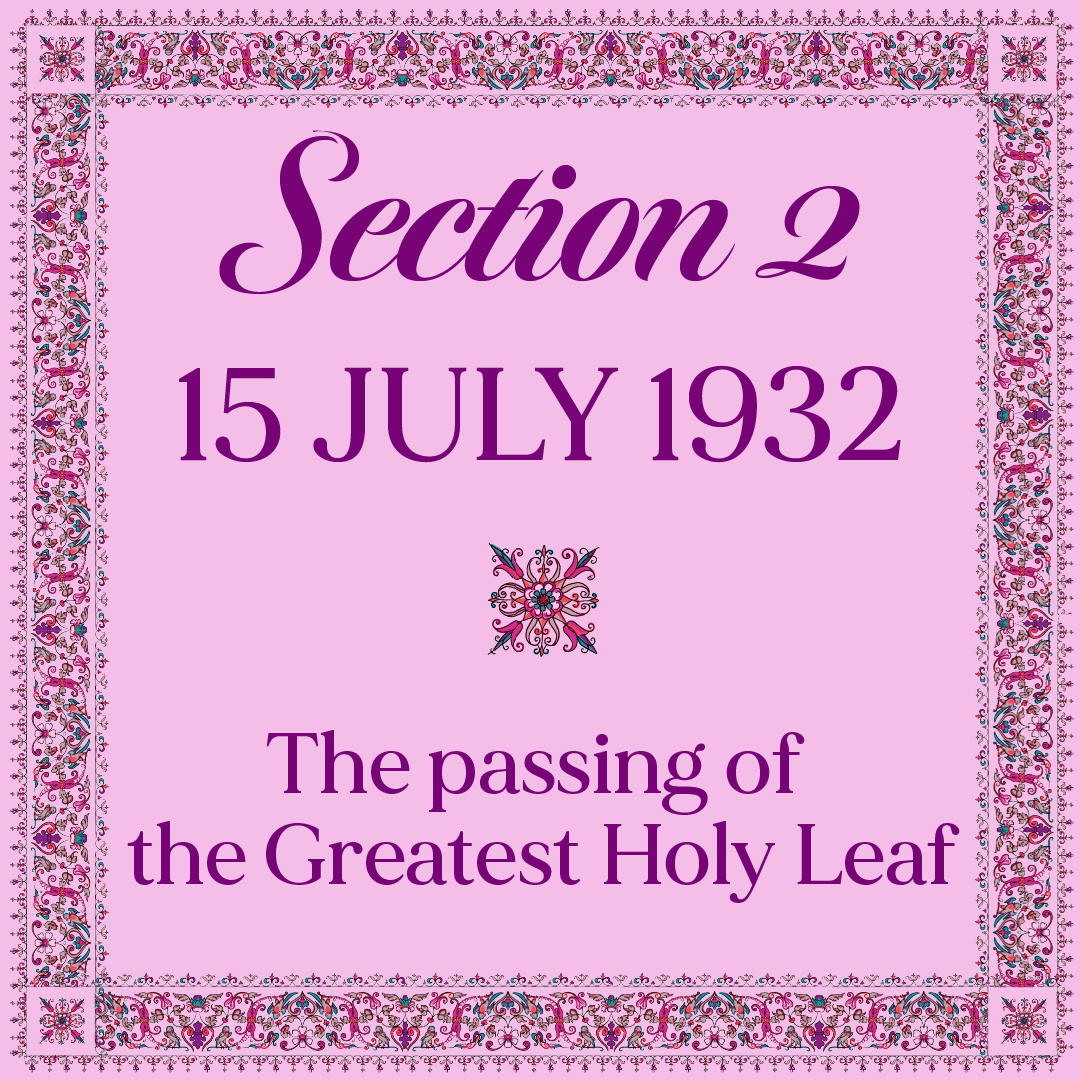
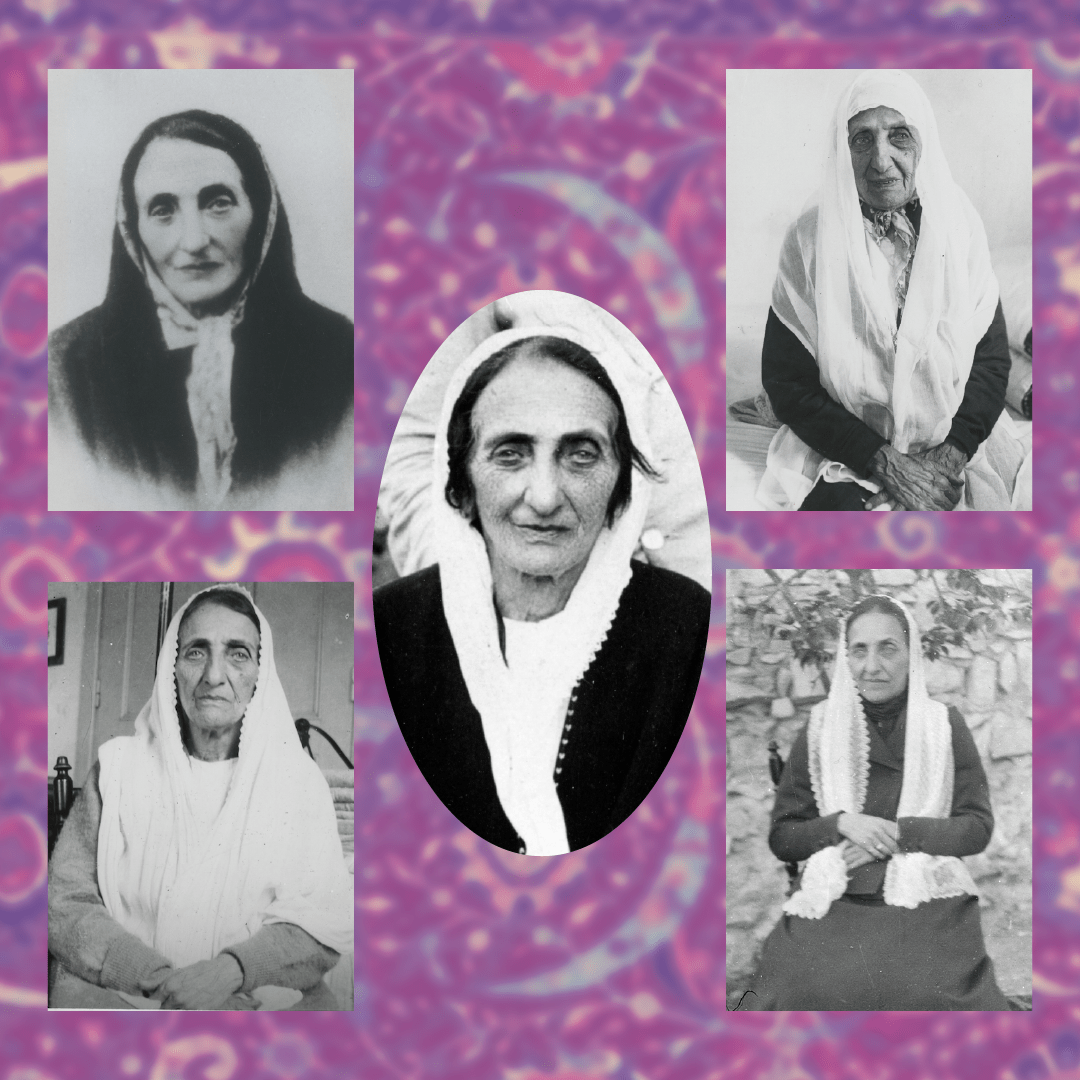
Collage of photographs of the Greatest Holy Leaf.
In the last days of hear saintly earthly life, Bahíyyih Khánum became extremely weak. She was 86 years old, and had lived through eight decades of intense suffering. Her body was extremely frail, she suffered from illnesses discomfort.
By this point in her life, Bahíyyih Khánum was most of the time confined to her room, but that did not change the fact that her soul was radiant and she remained, until the end, a source of joy and inspiration to anyone who had the privilege of entering her presence.
An extraordinary fact about the Greatest Holy Leaf is that 8 decades of suffering, though they left a deep mark on her physical body, never affected her joyful, hopeful, and happy soul. Until the very end, he did what she loved most to do: make people happy.
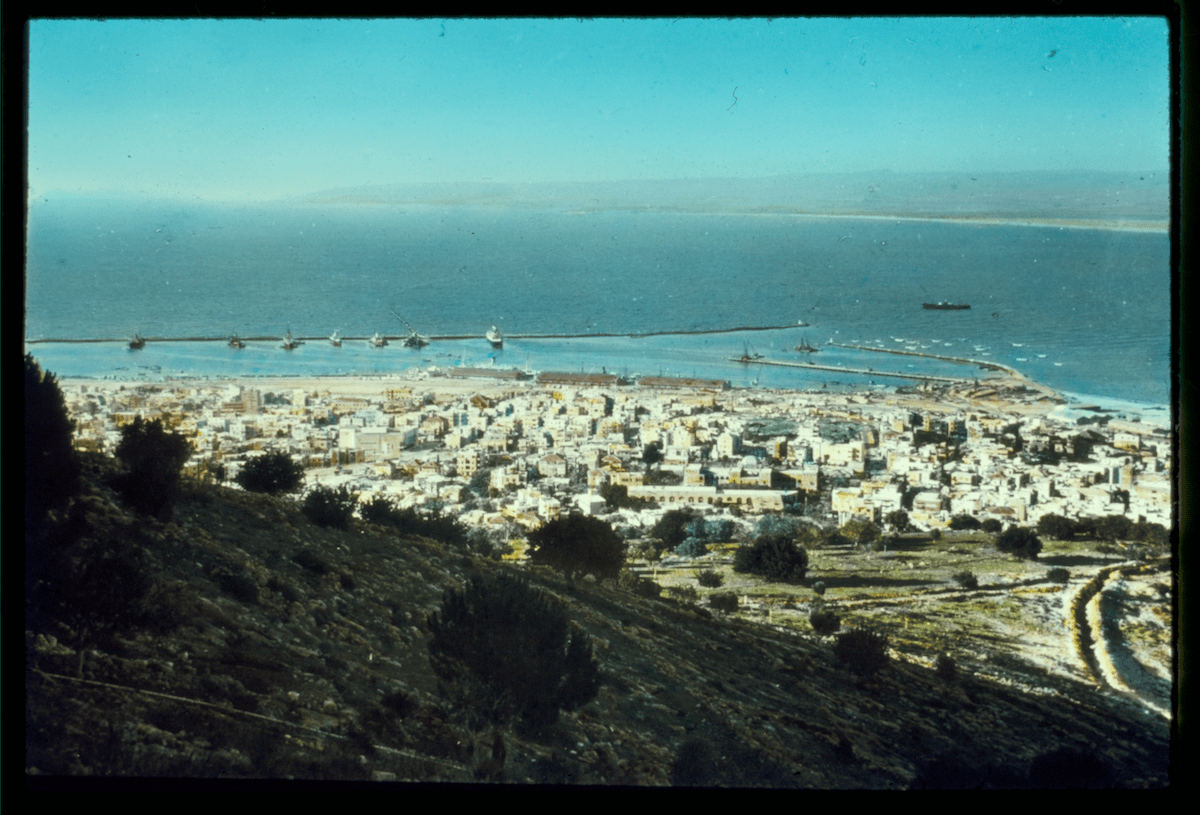
Along the Mediterranean coast, southward. Haifa from Mt. Carmel showing the harbor. Source: Library of Congress.
Marjorie Morten recounts that one day in the last year of the Greatest Holy Leaf’s life, she went one summer day to the mountain with the children of her family and sat watching them at their picnic.
For the entire family, the bounty of being with the Greatest Holy Leaf made the entire outing feel like a festival.
And when the family came down in the evening, the Greatest Holy Leaf thanked them for her delight in their play and for the happiness their happiness had given her.
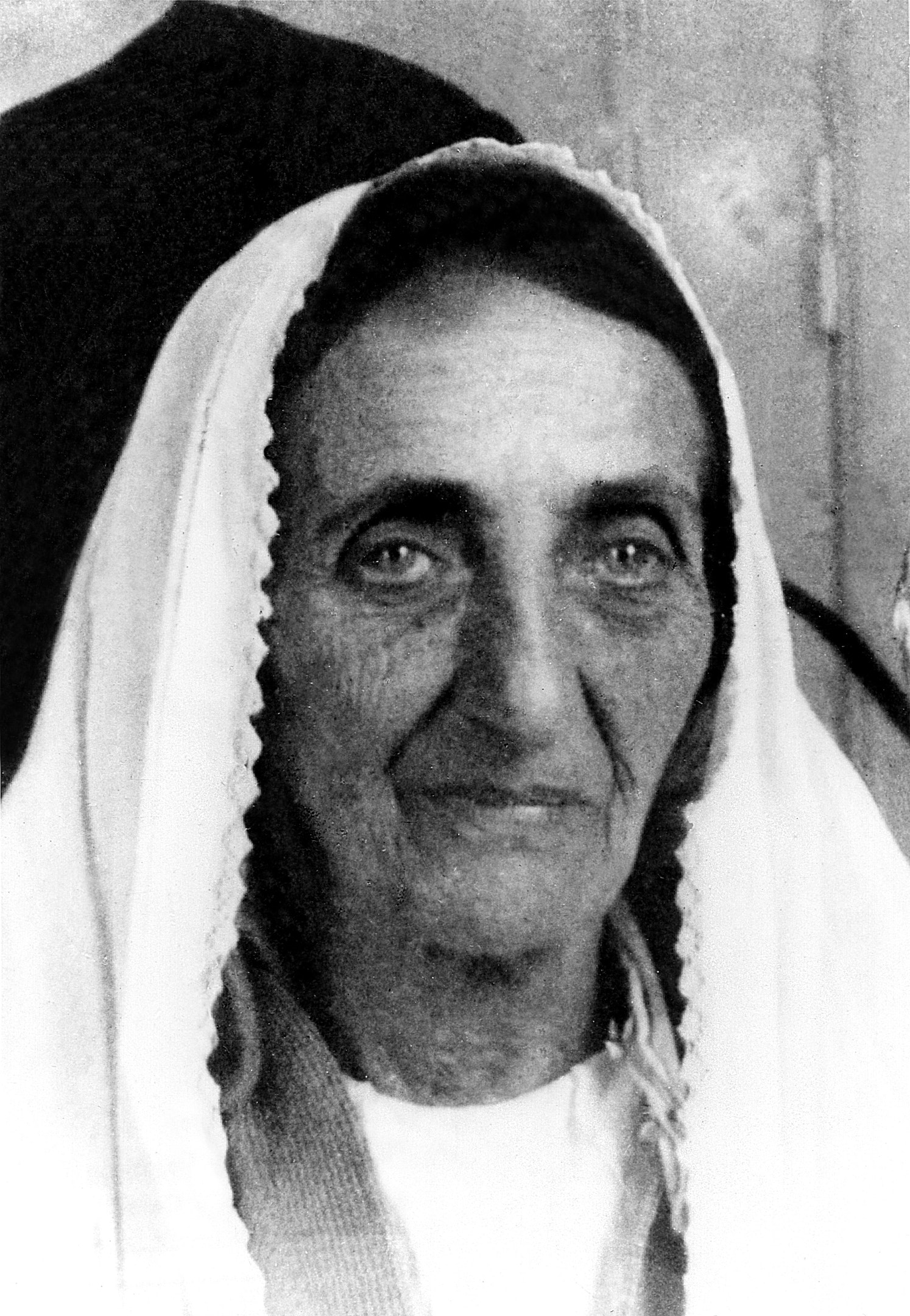
Greatest Holy Leaf, Bahíyyih Khánum—daughter of Bahá'u'lláh and Ásíyih Khánum and sister of 'Abdu'l-Bahá—close to the end of her life. Source: Bahá'í Media Bank, © Bahá'í
The American Bahá'í pilgrim Marjorie Morton left testimony about the Greatest Holy Leaf at the close of her life. According to her, the closer the Greatest Holy Leaf came to the end of her life, the more intensely her spirit shone:
And when she came to die her failing faculties threw into sharper and intenser relief the nature of her heart and spirit. It was as if she first let slip away the mechanical devices of the mind and the transient sense perceptions while holding fast to the end the essential elements of her being, unclouded by extremity of bodily weakness and pain.
Still her smile spoke strength, serenity, tenderness and the love that is both recognition and bestowal.
And so she left for remembrance a last clear record of the pattern of her life.
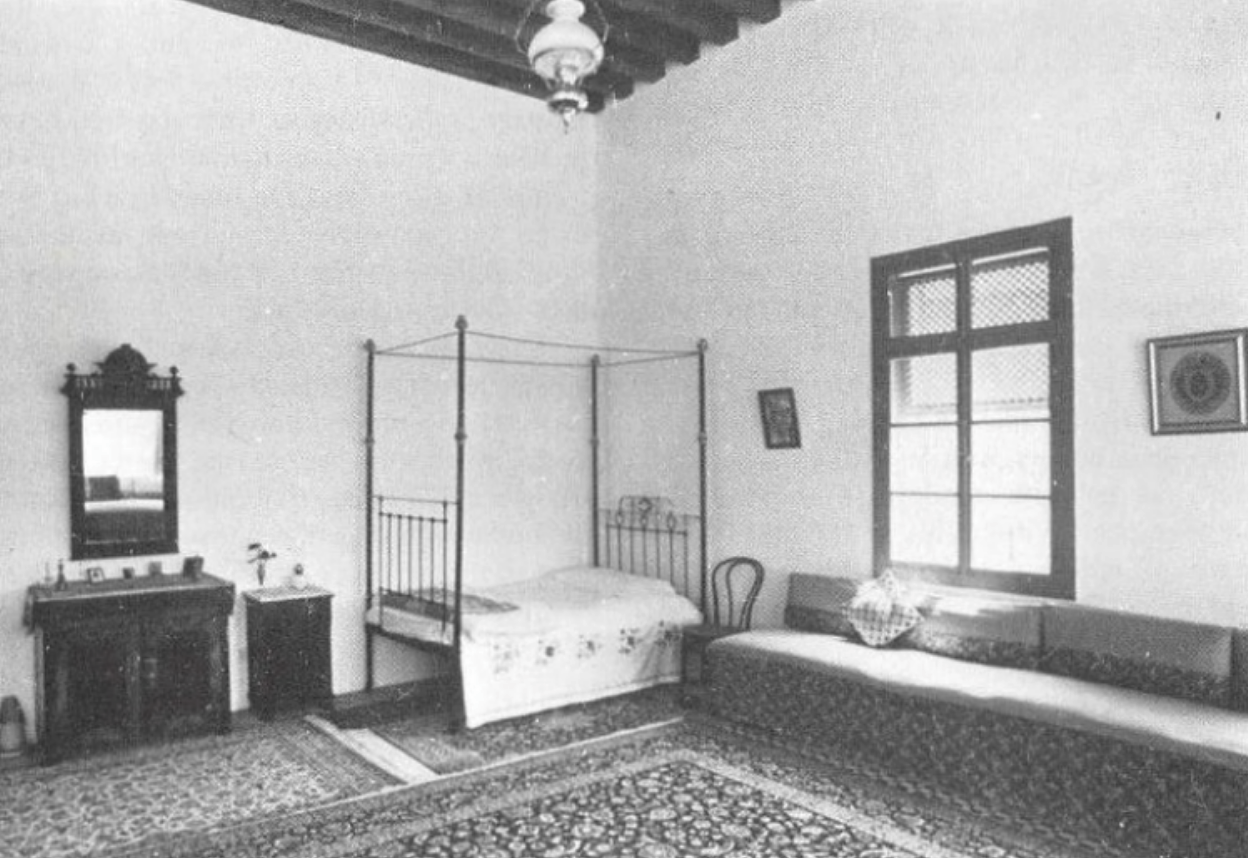
The Greatest Holy Leaf passed away in her room. As there are no photos available online of the room she lived in for 22 years in the Master’s House at 7 Haparsim, from 1910 to 1932. This is a photograph of the Greatest Holy Leaf’s room in the house of 'Abdu'lláh Pashá, where she lived immediately before moving to Haifa. The Greatest Holy Leaf lived in the House of 'Abdu'lláh Pashá from 1896 to 1910. Source: The Bahá'í World Volume 18, page 95.
Then, in her already-weakened state, the Greatest Holy Leaf contracted bronchitis—an inflammation of the airways in the lungs generally caused by an infection.
Bahíyyih Khánum’s niece, and the mother of Shoghi Effendi, Ḍíyá‘íyyih Khánum, took charge and appointed six women to look after the Greatest Holy Leaf, providing care for her around the clock: three of the daughters of 'Abdu'l-Bahá—Ḍíyá‘íyyih Khánum, Rúḥá Khánum, and Munavvar Khánum—another woman named Ṭayyibi Khánum, Laqá'íyyih Khánum, Bahíyyih Khánum’s lady-in-waiting, and the mother of ‘Alí Nakhjávání, Fáṭimih Khánum.
Each woman appointed to this duty rotated in six four-hour shifts, covering the 24 hours of each day.
Arrangements were made for babysitters to watch over Laqá'íyyih Khánum’s children while she cared for the Greatest Holy Leaf at night.
On the night of the Greatest Holy Leaf’s passing, the daughters of 'Abdu'l-Bahá, the grandchildren and members of the Holy Family were gathered around her bed, and they stayed by her side as she breathed her last breath.
The Greatest Holy Leaf passed away at the age of 86 on 15 July 1932, in Haifa, in the house of the Master, at one in the morning.
The Greatest Holy Leaf left this world in the same place and at the same time of night as her adored older brother 'Abdu'l-Bahá.
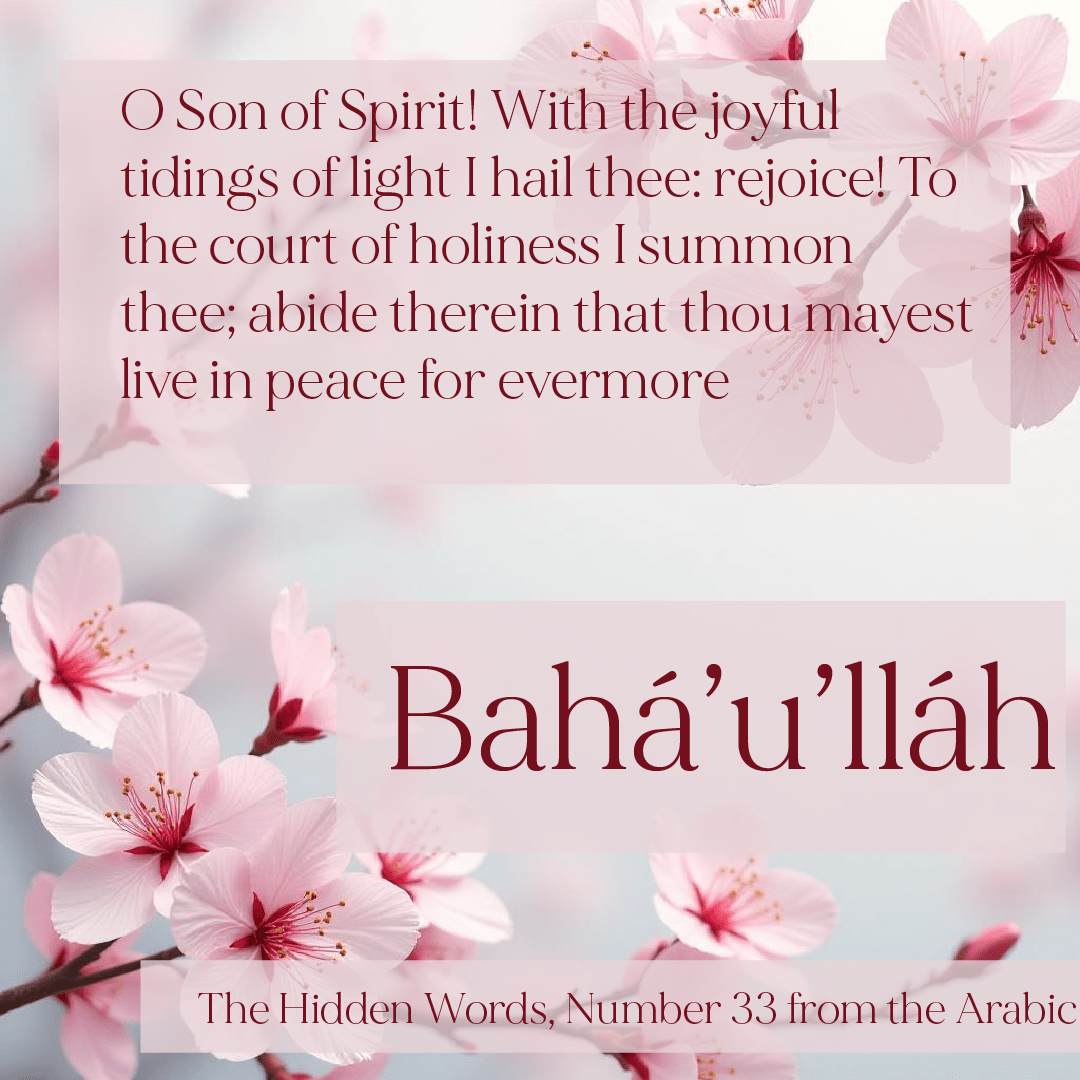
Background AI illustration of cherry blossoms generated by Pikaso AI.
When the Greatest Holy Leaf passed away an announcement was printed in Haifa on 15 July 1932 and distributed to everyone concerned, Bahá’ís and others, in Haifa, ‘Akká and Jerusalem.
At the top of the announcement was a Hidden Word by Bahá'u'lláh, number 33 from the Arabic:
O Son Of Spirit! With the joyful tidings of light I hail thee: rejoice! To the court of holiness I summon thee, abide therein that thou mayest live in peace for evermore. Bahá’u’lláh.
The announcement briefly stated:
The family of the late Sir ‘Abdu’l-Bahá ‘Abbás announces with profound sorrow the death of Bahíyyih Khánum, sister of the late Sir ‘Abdu’l-Bahá ‘Abbás, who passed away peacefully at 1 AM on the morning of July 15.
The funeral procession from her home in the Persian Colony is at 4:30 PM. Saturday, July 15th.
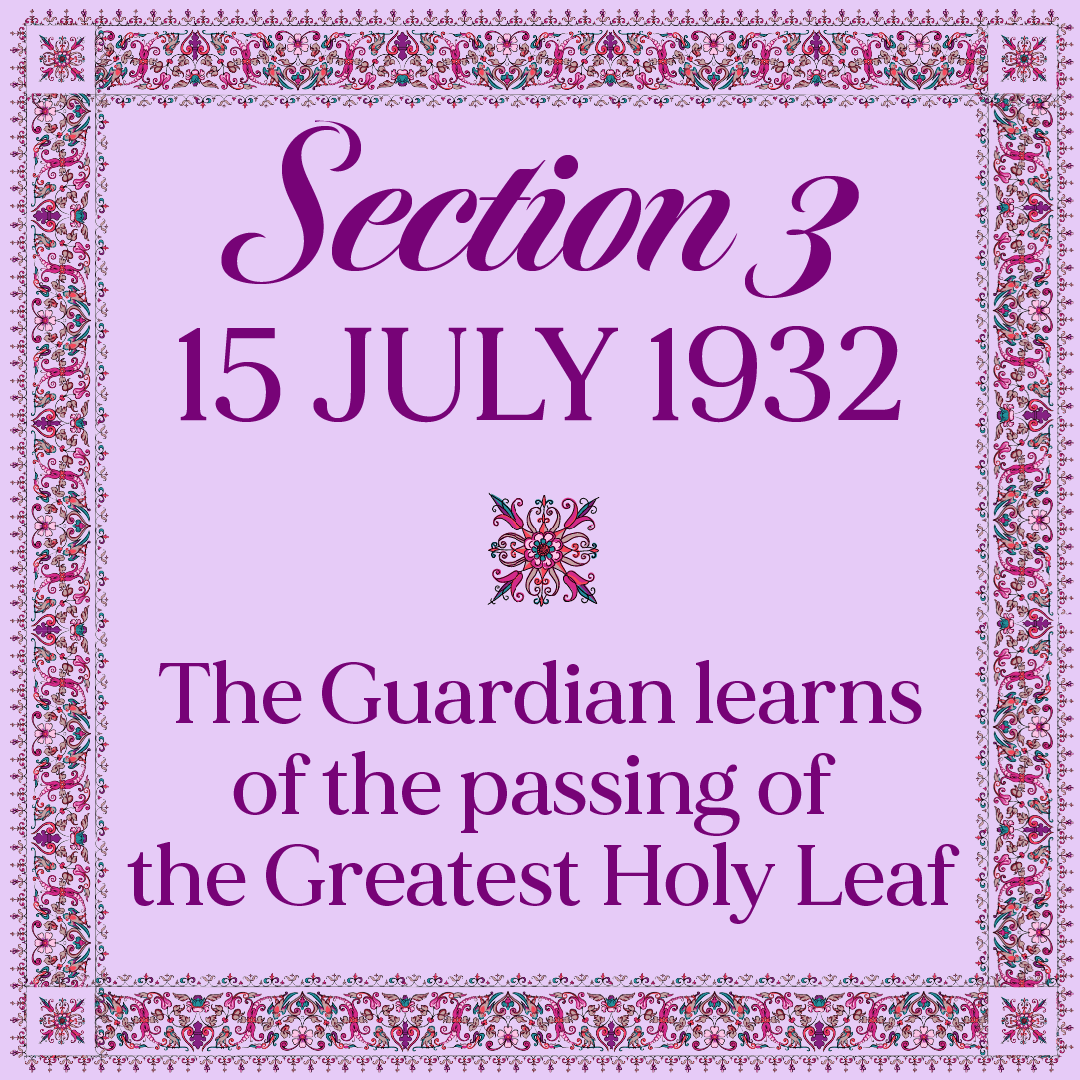

Shoghi Effendi and the Greatest Holy Leaf between 1918 and 1920. Source: Bahaimedia.
Shoghi Effendi had left the Holy Land sometime in May 1932 for his annual rest and recuperation in Interlaken, Switzerland.
Before leaving, however, the Guardian had left instructions regarding the spot on Mount Carmel where Bahíyyih Khánum was to be buried if she died while he was away.
It was there, in the heart of Europe, two months after his arrival in the sheltering shadow of his beloved mountains, that he received the second most devastating news ‘of his life, after the news of 'Abdu'l-Bahá’s Ascension: his lifelong refuge, the person he loved the most next to 'Abdu'l-Bahá, the Greatest Holy Leaf, was no longer.
No matter the Guardian’s awareness of his great-aunt’s frailty, her death, to him, was “tragic in its suddenness.”
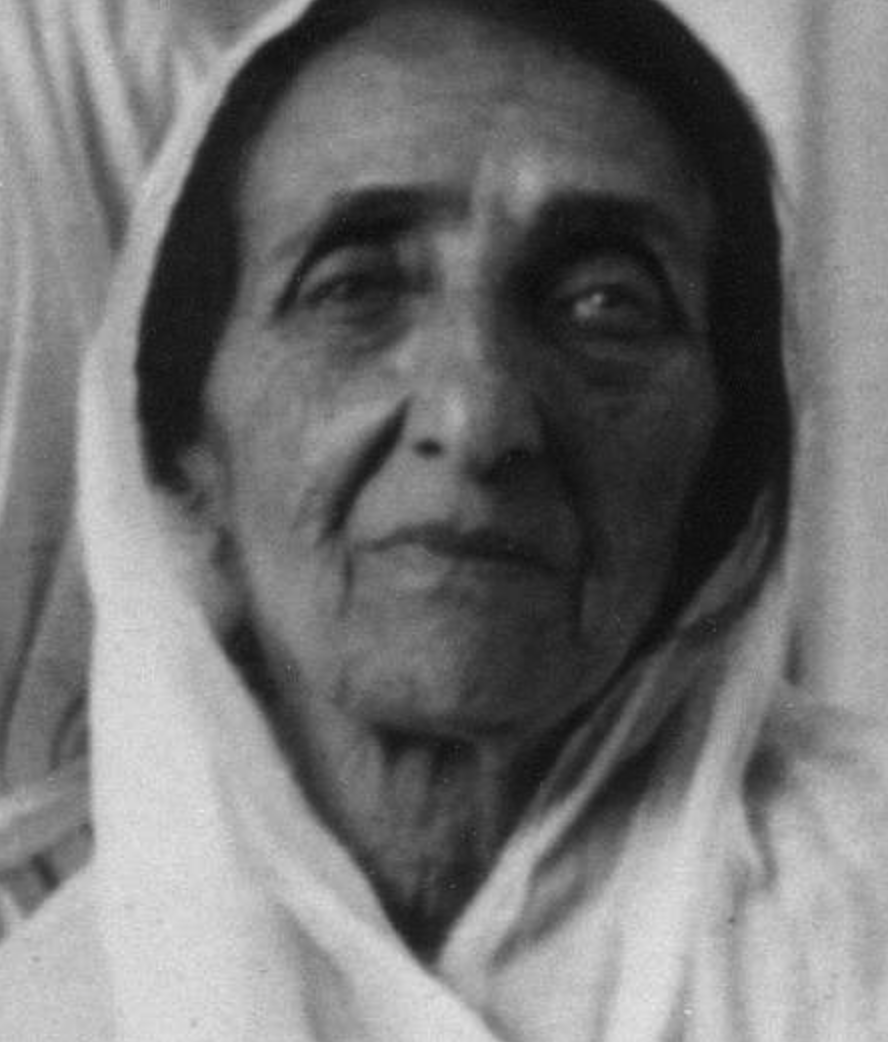
A portrait of the Greatest Holy Leaf. Source: Bahá'í Biblio.
In a tragic twist of fate, Shoghi Effendi, was absent from the Holy Land during the passing and the funeral of the two centers of his life: his Grandfather 'Abdu'l-Bahá and his great-aunt Bahíyyih Khánum.
Shoghi Effendi never truly recovered from not having been able to see 'Abdu'l-Bahá one last time before His Ascension on 28 November 1921. He was in England at the time, studying at Oxford University, and the shock of 'Abdu'l-Bahá’s sudden death left deep emotional marks on him for the rest of his life.
Now, 11 years later, fate struck again.
Shoghi Effendi was in Switzerland in the summer of 1932, and so he was absent from Haifa when the Greatest Holy Leaf, the pillar of his life for the first decade of his Guardianship, left this world.
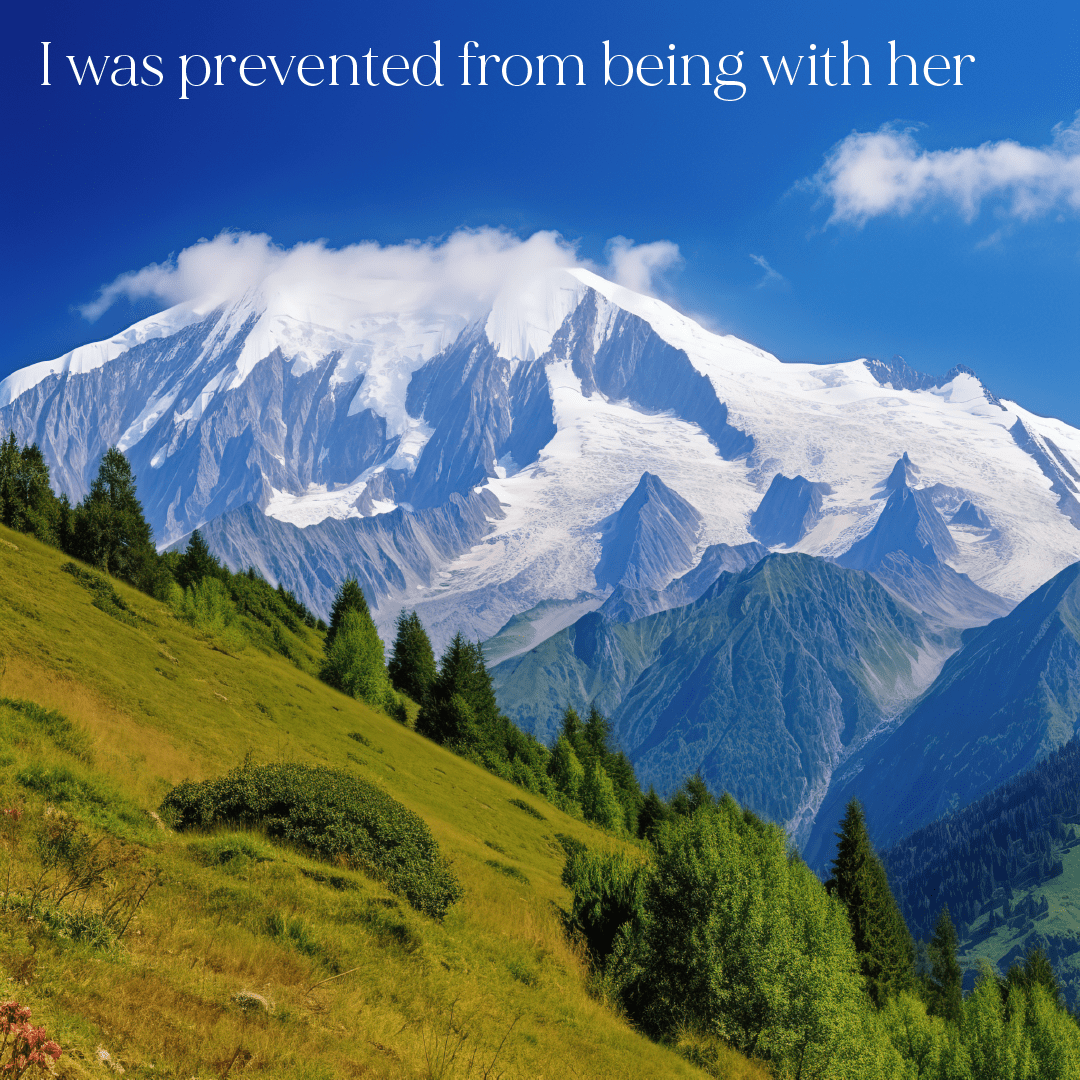
Background photo from Freepik Premium.
In a heart-breaking letter, Shoghi Effendi confided:
Alas, that I was prevented from being with her at the close of her earthly days, at that moment when she ascended to her Lord, her Master, and when her delicate body was placed in the tomb. Not mine that honour, that high privilege, for I was far away, deprived, bereft, excluded.
The Guardian would miss the Greatest Holy Leaf’s presence for the rest of his days, but he would always remember her in tributes, in dedications, in his letters, and by surrounding himself with memories of her.
For 15 years, he would wear a simple heart-shaped Bahá'í ring which the Greatest Holy Leaf had given him, engraved with the symbol of the Greatest Name on his ring finger. This would be the ring he would later place on Mary Maxwell’s ring finger when they became engaged.
The Greatest Holy Leaf would be present in the Guardian’s thoughts and acts until the end of his life.

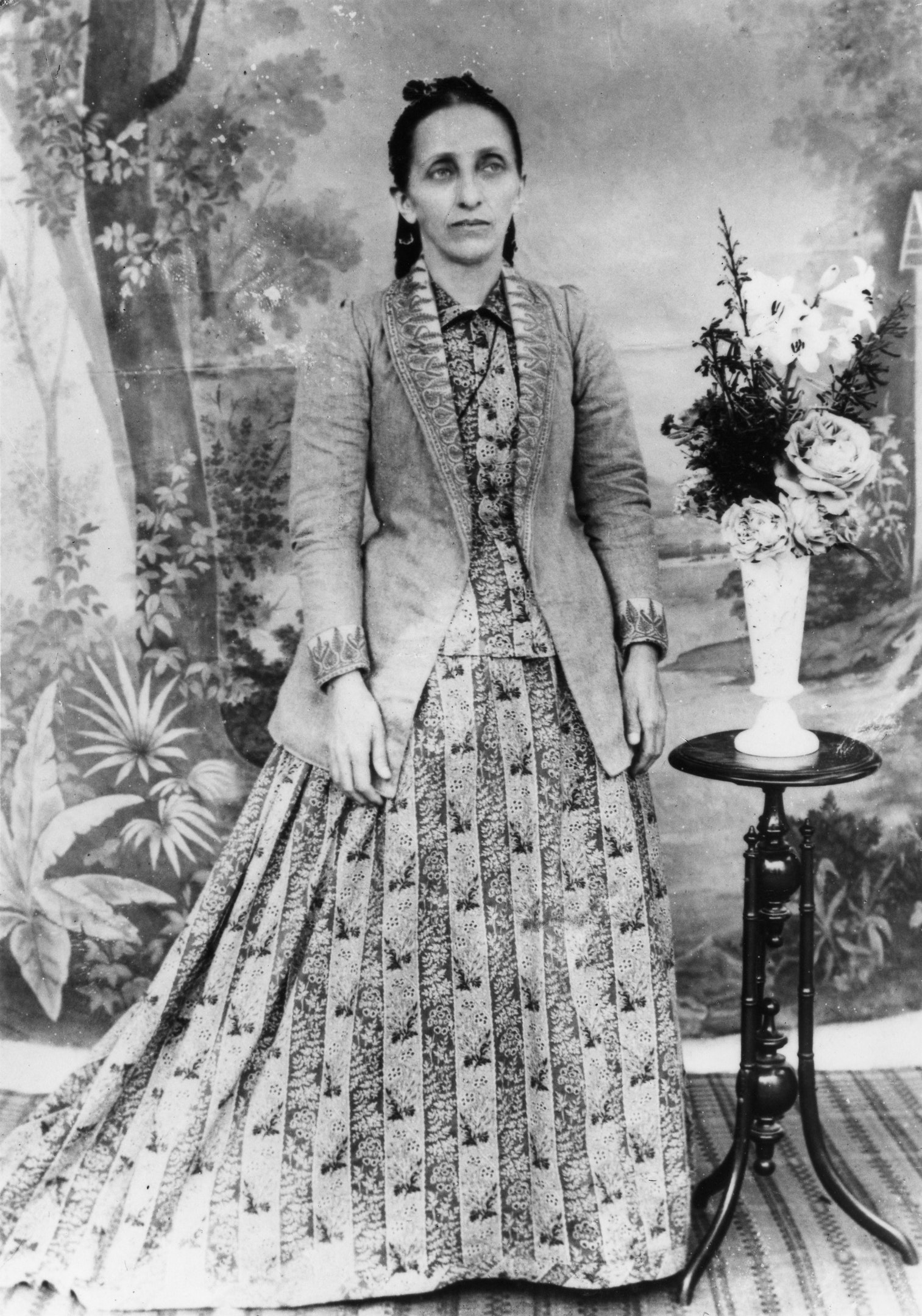
Portrait of Bahiyyih Khanum, The Greatest Holy Leaf, c. 1895, exactly around the time she oversees Shoghi Effendi's parents' marriage. Photo: courtesy of the Baha’i International Community. From Baha'i Blog.
On the very day of Bahíyyih Khánum’s passing, 15 July 1932, Shoghi Effendi wrote a letter to the National Spiritual Assembly of the Bahá'ís of the British Isles in which he majestically outlined the Greatest Holy Leaf’s services to the Faith:
For more than eighty years this Exalted Leaf bore with a fortitude that bewildered everyone who had the privilege of knowing her, sufferings and tribulations that few of our present-day believers did experience.
And yet, what a joy and what a saintlike attitude she manifested all through her life. Her angelic face was so calm, so serene in the very midst of sufferings and pains. Not that she lacked tenderness of heart and sympathy. But she could overcome her feelings and this because she had put all her trust in God.
And now that she has gone forever we should rejoice at the thought that she is still living in our hearts and is animating our soul with a devotion, a courage, and a hope of which we are in such a dire need in these days of sufferings and hardships.
It is significant to note that the Guardian purposefully uses the adjective “saintlike” to describe the attitude of the Greatest Holy Leaf. Shoghi Effendi, a supremely gifted writer, always chose his words carefully, and he was communicating to the Bahá'í community how they should consider the daughter of Bahá'u'lláh, how they should see her, how she should appear in their minds and souls.
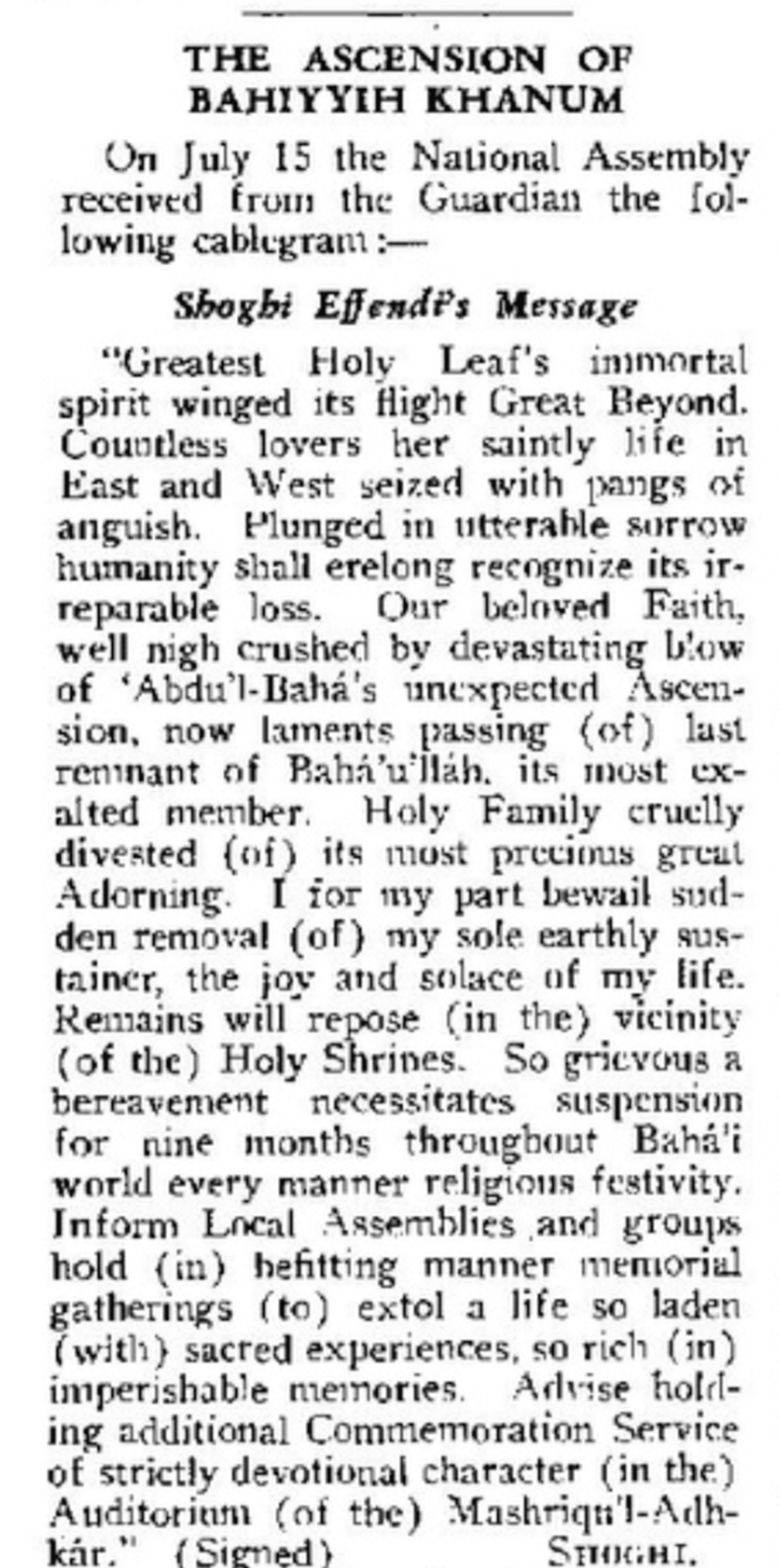
The cable sent by Shoghi Effendi on the day of the passing of the Greatest Holy Leaf as it was printed in Bahá'í News Issue 65 (August 1932).
That same day, the Guardian cabled the National Spiritual Assembly of the United States and Canada from Switzerland:
Greatest Holy Leaf’s immortal spirit winged its flight great beyond countless lovers her saintly life in east and west seized with pangs of anguish, plunged in unutterable sorrow. Humanity shall ere long recognize its irreparable loss. Our beloved Faith, well-nigh crushed by devastating blow of ‘Abdu’l-Bahá unexpected Ascension, now laments passing last remnant of Bahá’u’lláh its most exalted member.
Holy family cruelly divested its most precious most great adorning. I, for my part, bewail sudden removal my sole earthly sustainer the joy and solace of my life. Her sacred remains will repose vicinity holy shrines.
So grievous a bereavement necessitates suspension for nine months throughout Bahá’í world every manner religious festivity. Inform local assemblies and groups hold befitting manner memorial gatherings extol a life so laden sacred experiences, so rich imperishable memories.
Advise holding additional commemoration service of strictly devotional character auditorium Mashriqu’l-Adhkár.
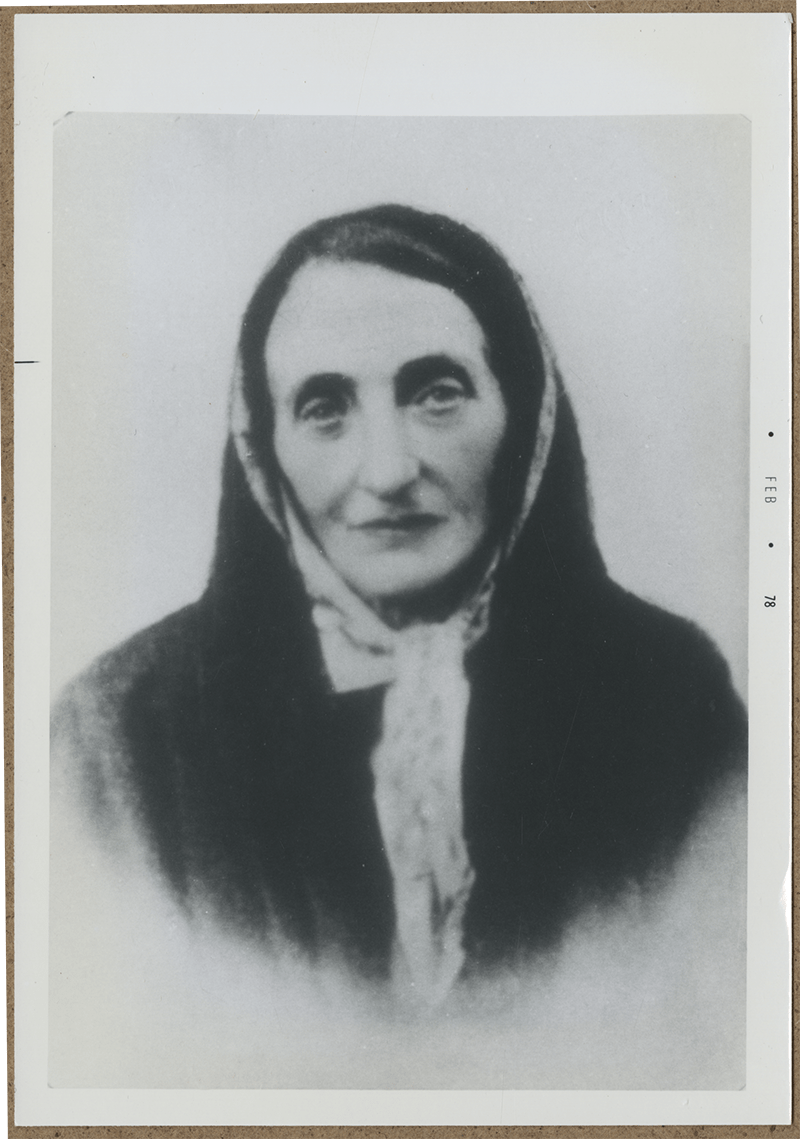
Undated photograph of the Greatest Holy Leaf. © United States National Bahá'í Archives, used with permission.
Shortly after the Greatest Holy Leaf’s interment, the Guardian sent a cable to the Bahá'ís in Persian announcing the devastating news of her passing:
The Greatest Holy Leaf, the Remnant of Bahá and His Trust, has disappeared from the horizon of the luminous Shrine, ascended to the Sadratu'l-Muntahá and is in the highest chambers of paradise leaning against the immortal throne of glory.
The eyes of the people of Bahá are weeping and the hearts of the faithful are on fire. Patience and fortitude are the attributes of the steadfast friends, radiant submission is the characteristic of those near to God.
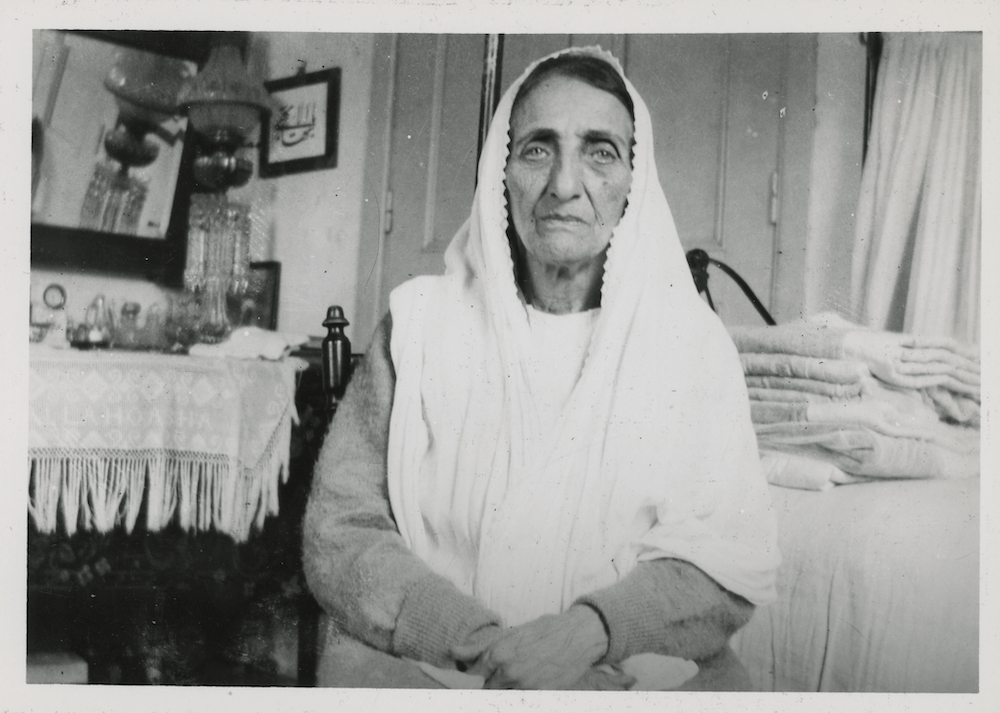
The Greatest Holy Leaf in Haifa. © United States National Bahá'í Archives, used with permission.
Although Shoghi Effendi himself was reeling with the pain of losing the most important person in his life, he found the superhuman strength to display empathy to the suffering of the Bahá'ís and their immense grief at losing the Greatest Holy Leaf.
One example of this is his words in a beautiful letter in Persian which he wrote to the Bahá'ís of the East on the day of Bahíyyih Khánum’s passing, 15 July 1932 in which he found the perfect words to describe the feeling of loss they were struggling to deal with:
The community of Bahá, whether in the East of the world or the West, are lamenting like orphans left destitute; fevered, tormented, unquiet, they are voicing their grief.
Out of the depths of their sorrowing hearts, there rises to the Abhá Horizon this continual piercing cry: “Where art thou gone, O torch of tender love? Where art thou gone, O source of grace and mercy? Where art thou gone, O symbol of bounty and generosity? Where art thou gone, O day-spring of detachment in this world of being? Where art thou gone, O trust left by Bahá among His people, O remnant left by Him among His servants, O sweet scent of His garment, shed across all created things!”
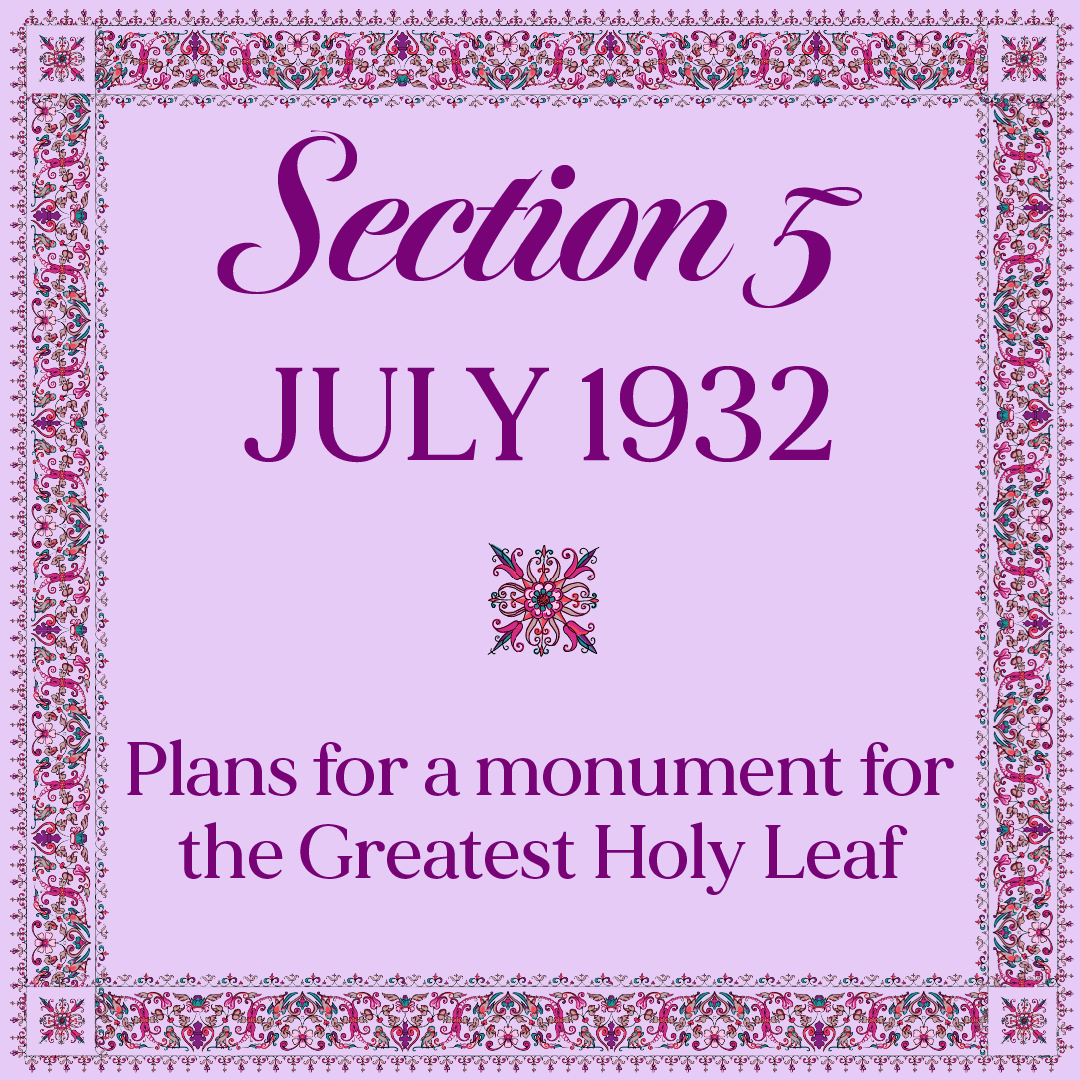
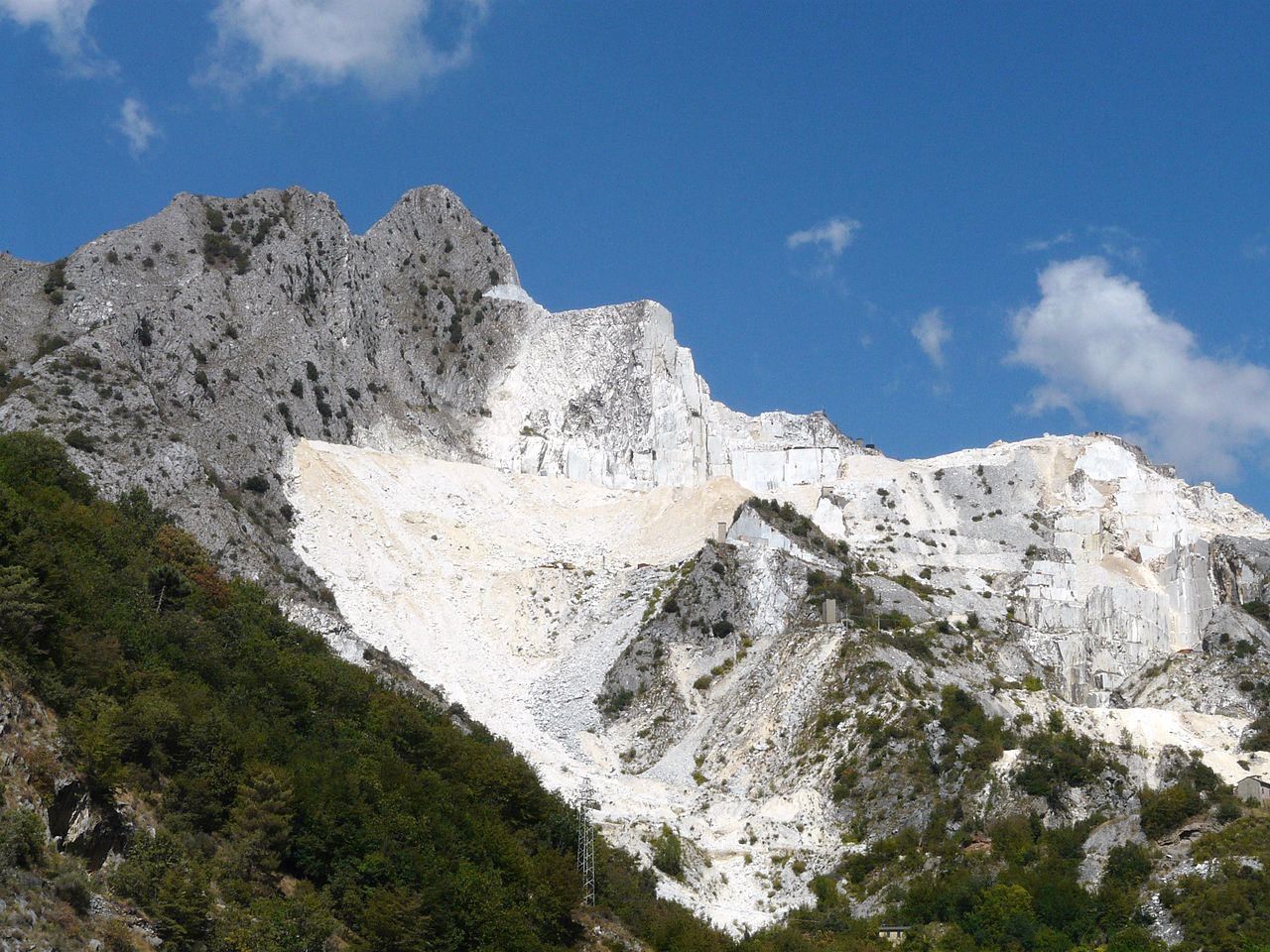
Marble quarries at Carrara, Italy in the region of Tuscany, the most famous marble in the world, used for millennia. This is where Shoghi Effendi went from Switzerland to order the marble monument for the resting place of the Greatest Holy Leaf. Source: Wikimedia Commons.
Immediately after sending cables to the Bahá'ís of the east and the west on 15 July 1932, writing his long eulogy for the Greatest Holy Leaf two days later on 17 July 1932, and officially inaugurating nine months of mourning in memory of the Greatest Holy Leaf, the Guardian took action on the next step.
Shoghi Effendi prepared for the construction of a befitting monument to place over the resting place of the daughter of Bahá'u'lláh, a structure that would perfectly embody the exalted station of the Outstanding Heroine of the Bahá'í Dispensation.
The Guardian left Switzerland and personally traveled to Italy to commission a magnificent, memorial monument.

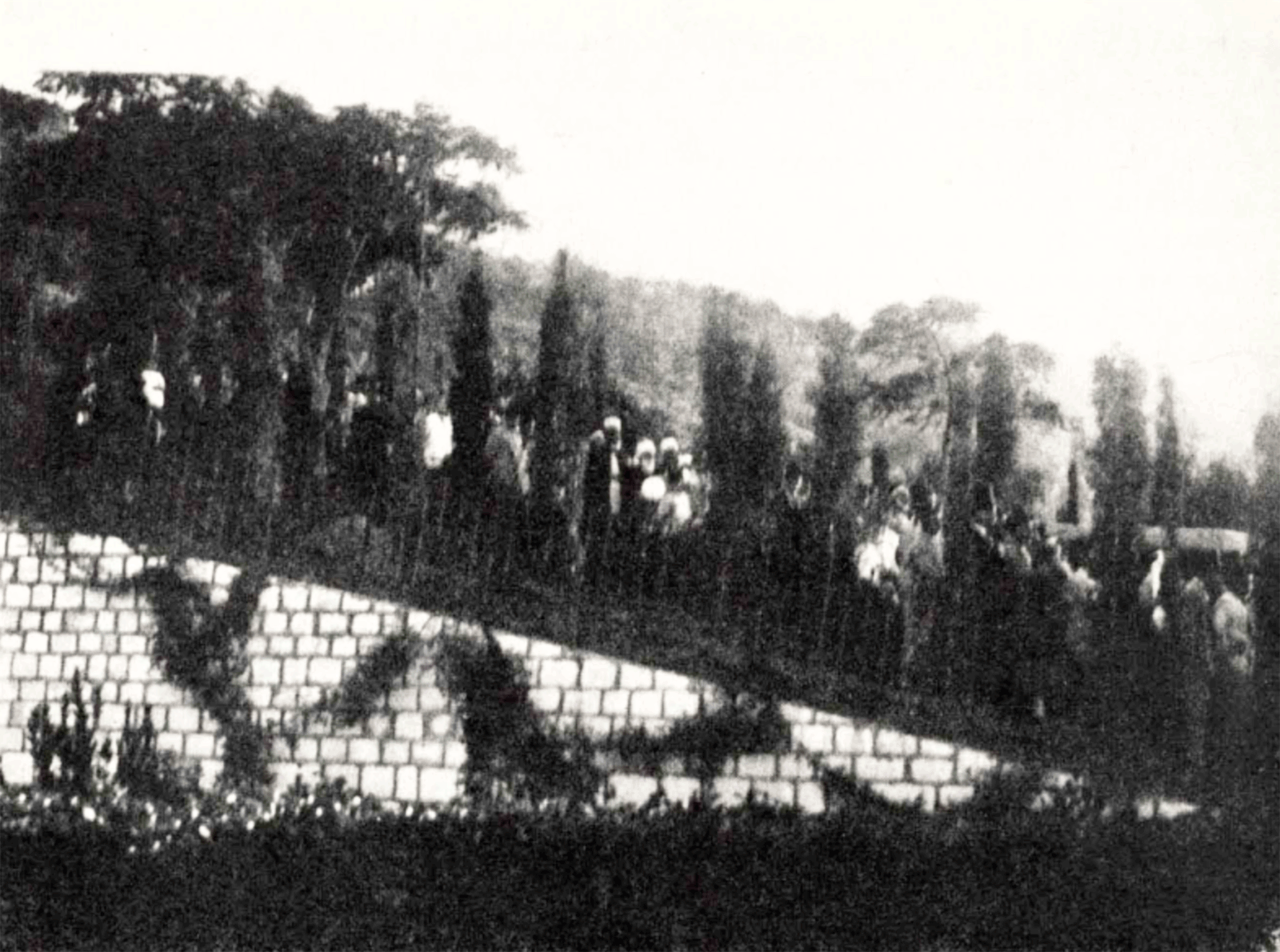
The funeral cortege of the Greatest Holy Leaf approaching the Shrine of the Báb. Source: Bahaimedia.
The Greatest Holy Leaf had herself prepared her burial shroud, a pair of white socks, a white scarf, a white handkerchief and a white dress made of inexpensive material.
The Greatest Holy Leaf had wrapped everything, as had been her lifelong habit, in a piece of paper, to keep everything together.
A large crowd assembled to pay their last respects to the Greatest Holy Leaf and lay her to rest. The funeral cortège numbered a hundred cars.
Local dignitaries were present, such as the Mayor of Haifa and the Representative of the Northern District of British Mandate Palestine.
People who had loved Bahíyyih Khánum flocked from all the surrounding towns and villages, from Haifa, 'Akká, but also the Druze village of Abú-Sinán where she had lived for 8 months during World War I, and also towns as far as Nablus, Jaffa and Jerusalem.
The resident Bahá'í community was also present.
Before laying the Greatest Holy Leaf to rest, the prayer for the dead was read in the house of the Master, where she had passed away early that same morning, in the large downstairs reception hall.
Then, pallbearers raised the coffin containing the sacred remains of the Greatest Holy Leaf aloft on their shoulders and walked up the steep incline of Mount Carmel to inter Bahíyyih Khánum in the place that had been specifically designated by the Guardian.
Shoghi Effendi had given specific instructions to his father, Mírzá Hádí Shírází, on exactly where to inter the remains of the Greatest Holy Leaf and how to conduct the funeral ceremony.

Closeup of a previously posted photograph of the Greatest Holy Leaf in Haifa. Photograph taken as part of a series of portraits in November 1900. © United States National Bahá'í Archives, used with permission.
From Switzerland, the Guardian, who was carefully following all the arrangements for the funeral of the Greatest Holy Leaf, sent an important instruction addressed directly to all Bahá'ís in the Holy Land.
Shoghi Effendi instructed the Bahá'ís to visit the Greatest Holy Leaf’s resting place daily.
Dutifully, and no doubt crushed with grief and sadness, the Bahá'ís visited Bahíyyih Khánum’s resting place every afternoon from 15 to 24 July 1932 to say prayers, during the period of nine days of mourning.
It would be a very grave mistake to think that Bahá'ís were the only ones grieving for the passing of the Greatest Holy Leaf.
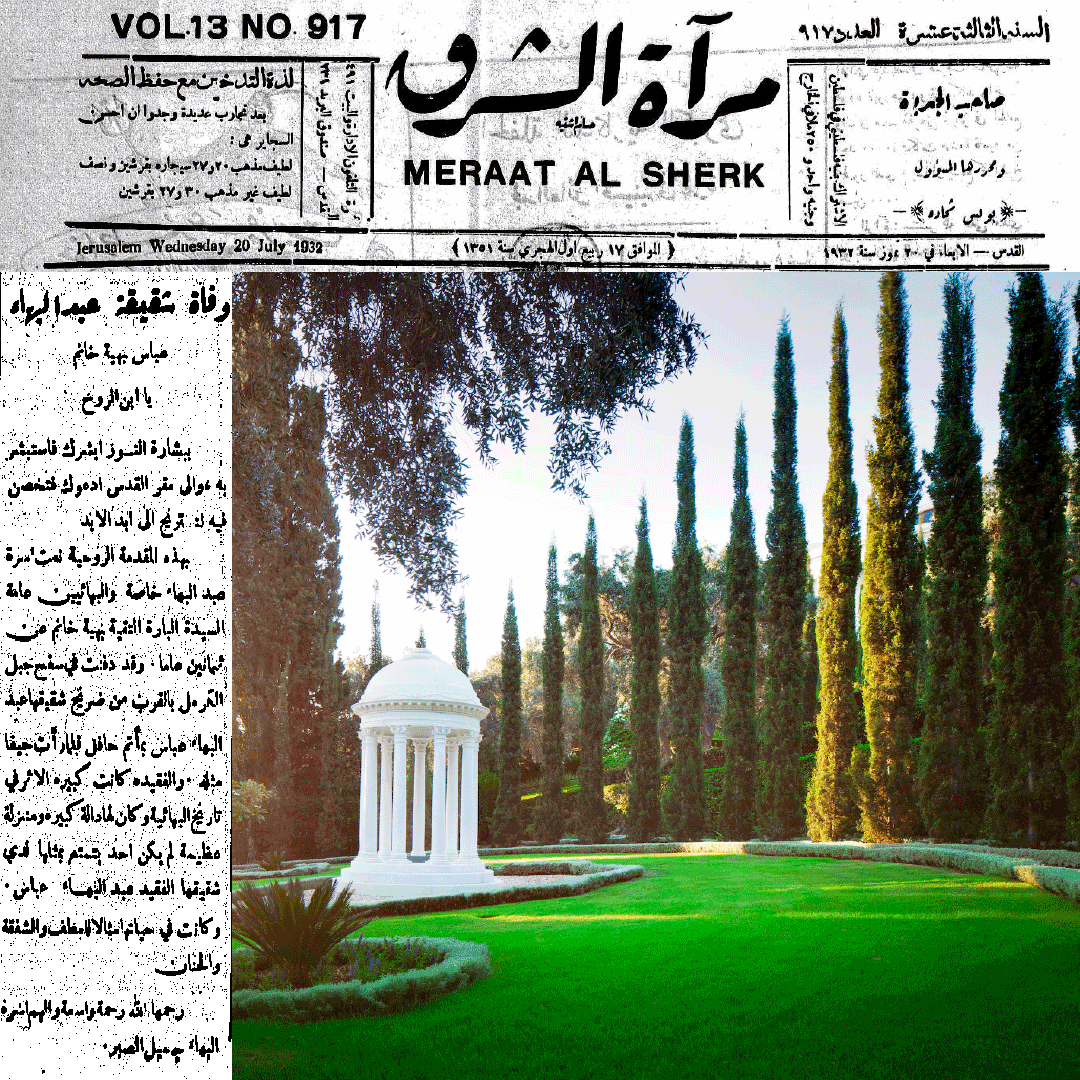
Article on the Greatest Holy Leaf's passing dated 20 July 1932 from the Jerusalem newspaper Mir’át ash-Sharq ("The Mirror of the East"). Article courtesy of Dr. Necati Alkan. Background image: A modern view of the monument for the resting place of the Greatest Holy Leaf. Source: Bahá'í Media Bank, © Bahá'í International Community 2023.
This is an article on the passing of the Greatest Holy Leaf dated 20 July 1932 from the Jerusalem newspaper Mir’át ash-Sharq ("The Mirror of the East"), kindly provided for use in this chronology by Dr. Necati Alkan, the foremost specialist on all things related to the Bábí and Bahá'í Faiths during the time of the Ottoman Empire.
The title of the article reads:
Death of the sister Bahíyyih Khánum, the sister of 'Abdu'l-Bahá ‘Abbás
This is the Hidden Word from the Arabic number 33 which opens the article:
O Son of Spirit!
With the joyful tidings of light I hail thee: rejoice! To the court of holiness I summon thee; abide therein that thou mayest live in peace forevermore.
This is the article, translated into English from the original Arabic by Gamal Hassan:
With this spiritual preface, the Family of 'Abdu'l-Bahá in particular, and the 'Abdu'l-Baháin general, announced the passing of the benevolent and pious lady, Bahíyyih Khánum, of eighty years of age. She has been laid to rest at the slopes of Mount Carmel, in the vicinity of the shrine of her brother 'Abdu'l-Bahá ‘Abbás, in a funeral that was packed with mourners, the likeness of which the city of Haifa hasn’t previously witnessed.
The late lady had a great influence in the history of the Bahá'í Faith. She had a significant role, and occupied a great station that nobody else enjoyed save her brother the Late 'Abdu'l-Bahá ‘Abbás. Throughout her life she was the embodiment of decency, compassion, and kindness.
May God shower her with His abundant mercy, and grant the Family of Bahá a well-enduring patience.
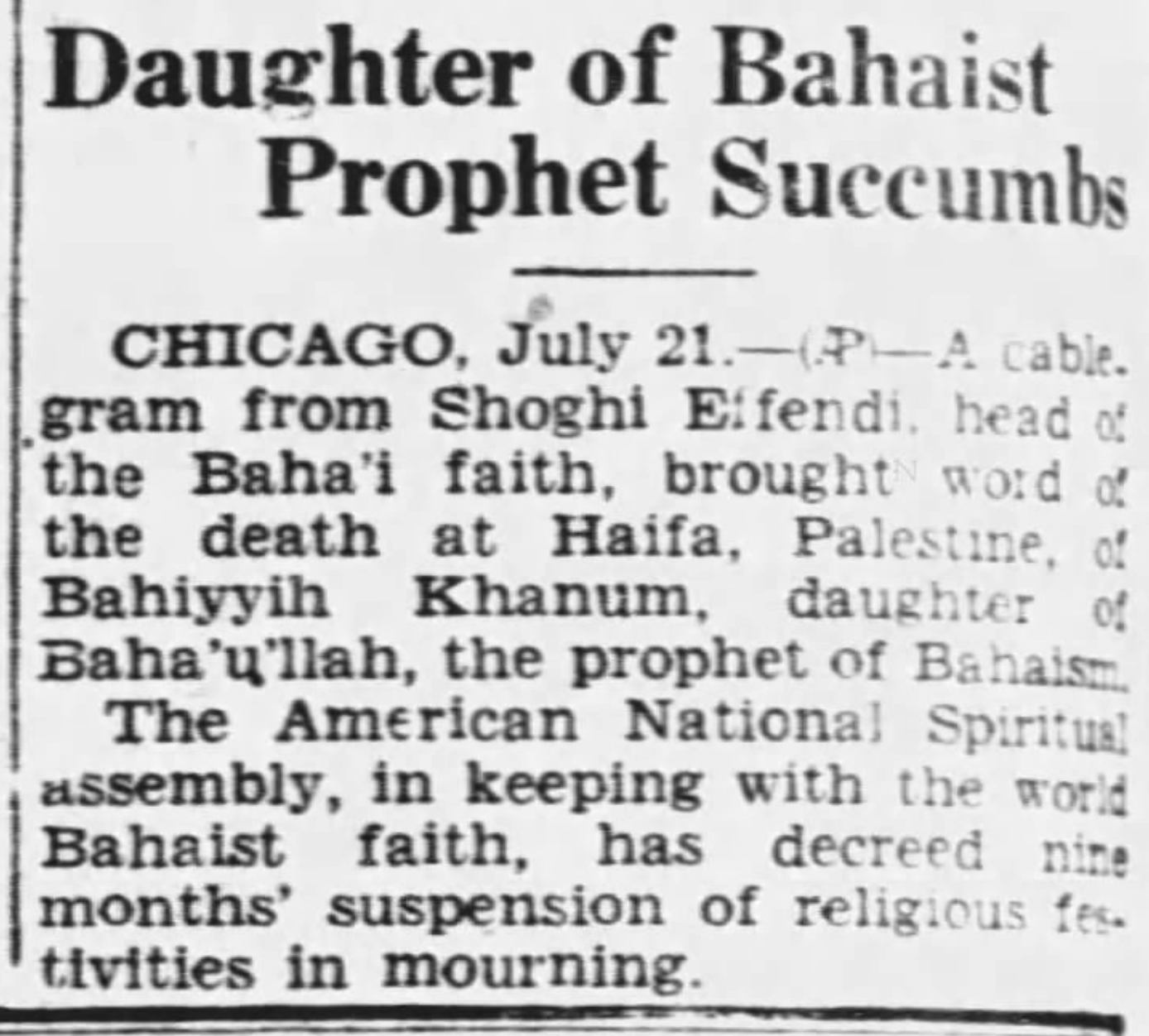
Obituary of the Greatest Holy Leaf published in the Casper Star-Tribune, Casper, Wyoming, on Thursday 21 July 1932 on page 10. Source: Newspapers.com.
On Thursday 21 July 1932, exactly one week after her passing, Casper Star-Tribune of Casper, Wyoming, published an obituary of the Greatest Holy Leaf on page 20.
The title of the obituary read:
Daughter of Bahaist Prophet succumbs
Below was the following text:
CHICAGO, July 21
A cablegram from Shoghi Effendi, head of the Baha’i faith, brought word of the death at Haifa, Palestine, of Bahiyyih Khanum, daughter of Baha’u’llah, the prophet of Bahaism.
The American National Spiritual Assembly, in keeping with the world Bahaist faith, has decreed nine months’ suspension of religious festivities in mourning.
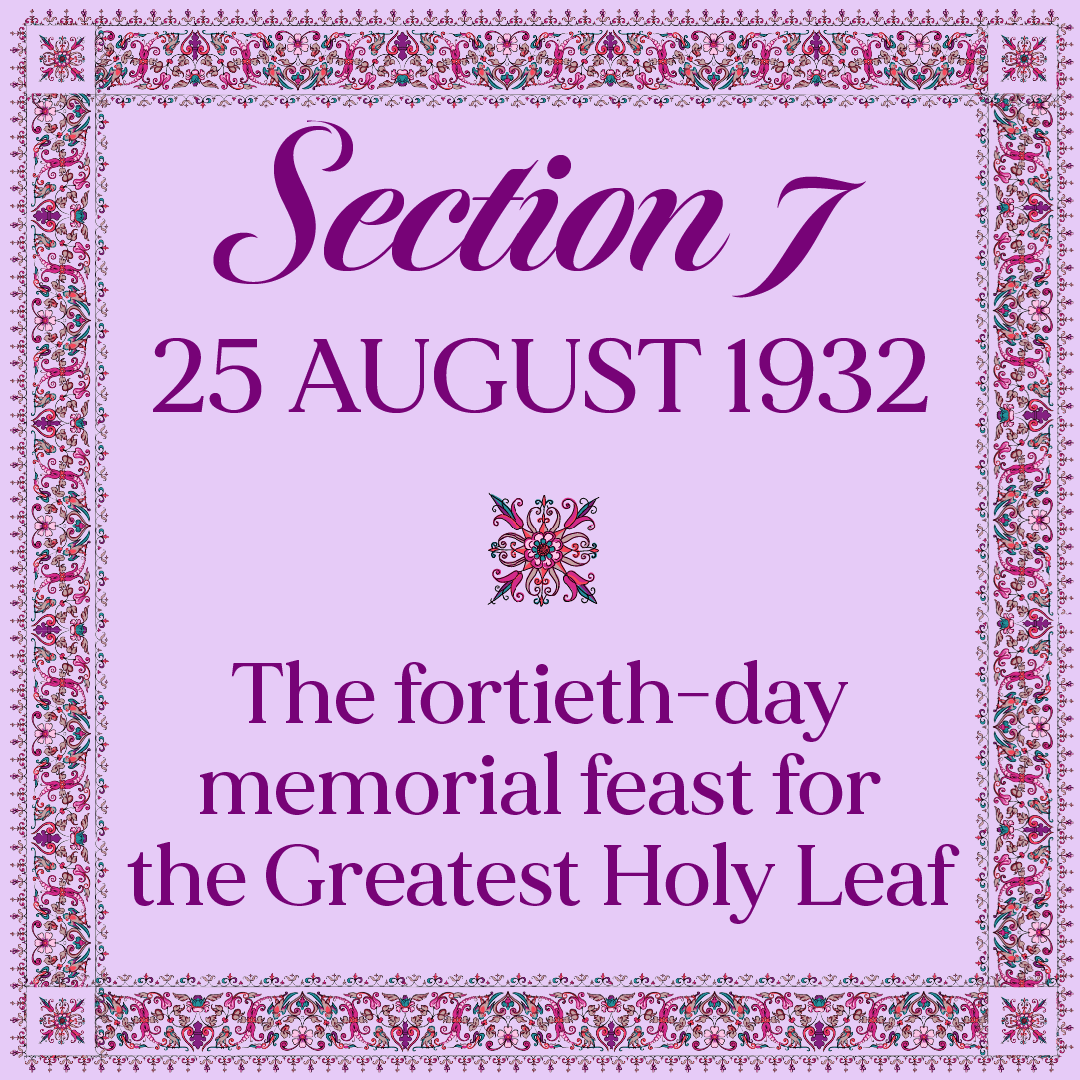
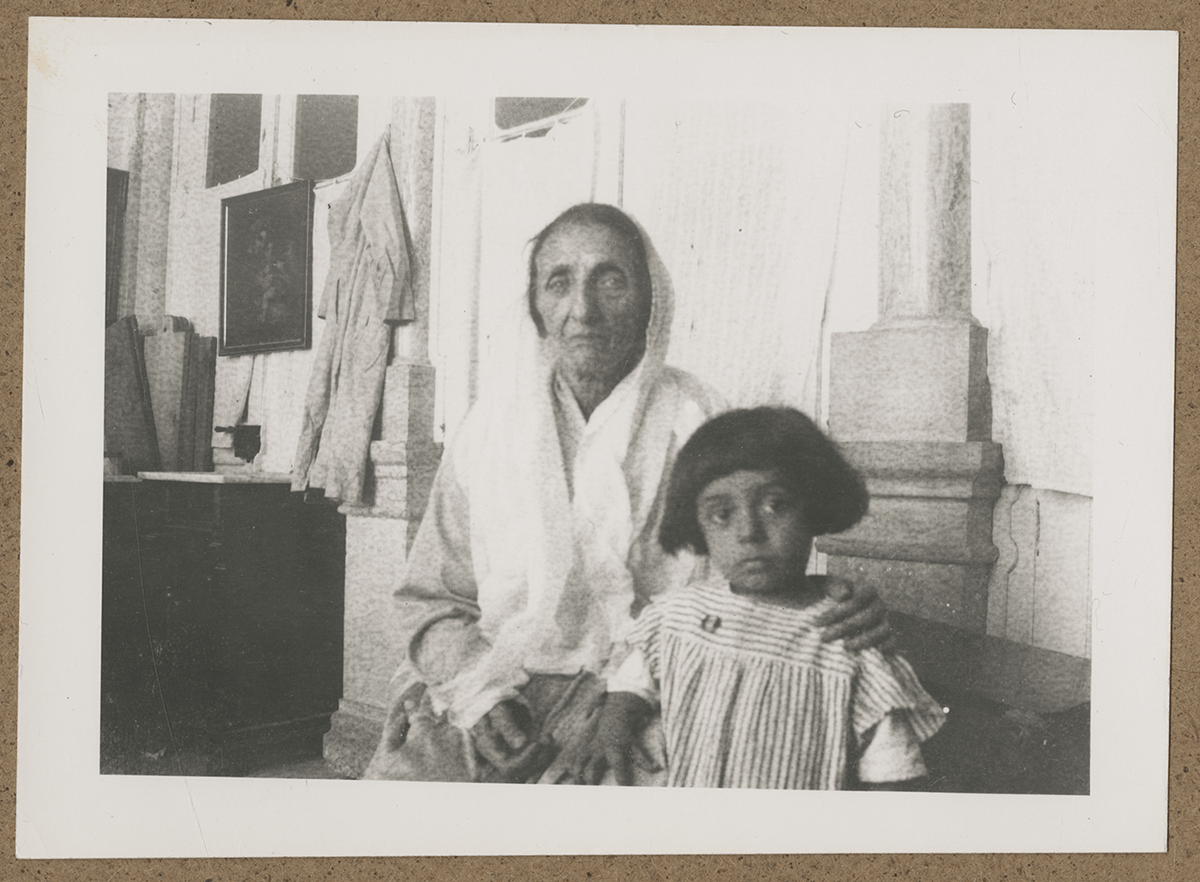
A portrait of the Greatest Holy Leaf with her grand-nephew Fu’ad—the son of the Greatest Holy Leaf’s niece Túbá Khánum, daughter of 'Abdu'l-Bahá and Munírih Khánum. The handwritten note on the back of the photograph indicates the photograph was taken in 1920 by Emogene Hoagg. © United States National Bahá'í Archives, used with permission.
The community of 'Akká and Haifa was so shaken that they wrote a classical poetic form of funeral eulogy in praise of the deceased’s character, and they wanted an opportunity to read their poems out loud.
They were not able to read their poems on the day of the Greatest Holy Leaf’s funeral because night had fallen and the assembled crowd had gone home.
The people of 'Akká and Haifa, deeply devoted to the Greatest Holy Leaf who had served the, come to their aid, fed them, been their devoted friend and loved them for 60 years, wanted their chance to express their love for Bahíyyih Khánum, same as the Bahá'ís had been able to.
They made a request to the ‘Bahá'ís to hold a meeting in the house of the Master so that they could offer their own local custom to honor the Greatest Holy Leaf.
They wanted officials to come, they wanted to pay their respects and condolences to the Holy Family, they wanted to recite their poems and they wanted a chance to eulogize her virtues, her qualities and tell the assembled audience what she meant to them.
Their request was immediately cabled to Shoghi Effendi who suggested instead that they organize something much more befitting of the Greatest Holy Leaf’ character: a fortieth-day memorial feast where hundreds could gather and be fed and be joyful in the name of Bahíyyih Khánum.
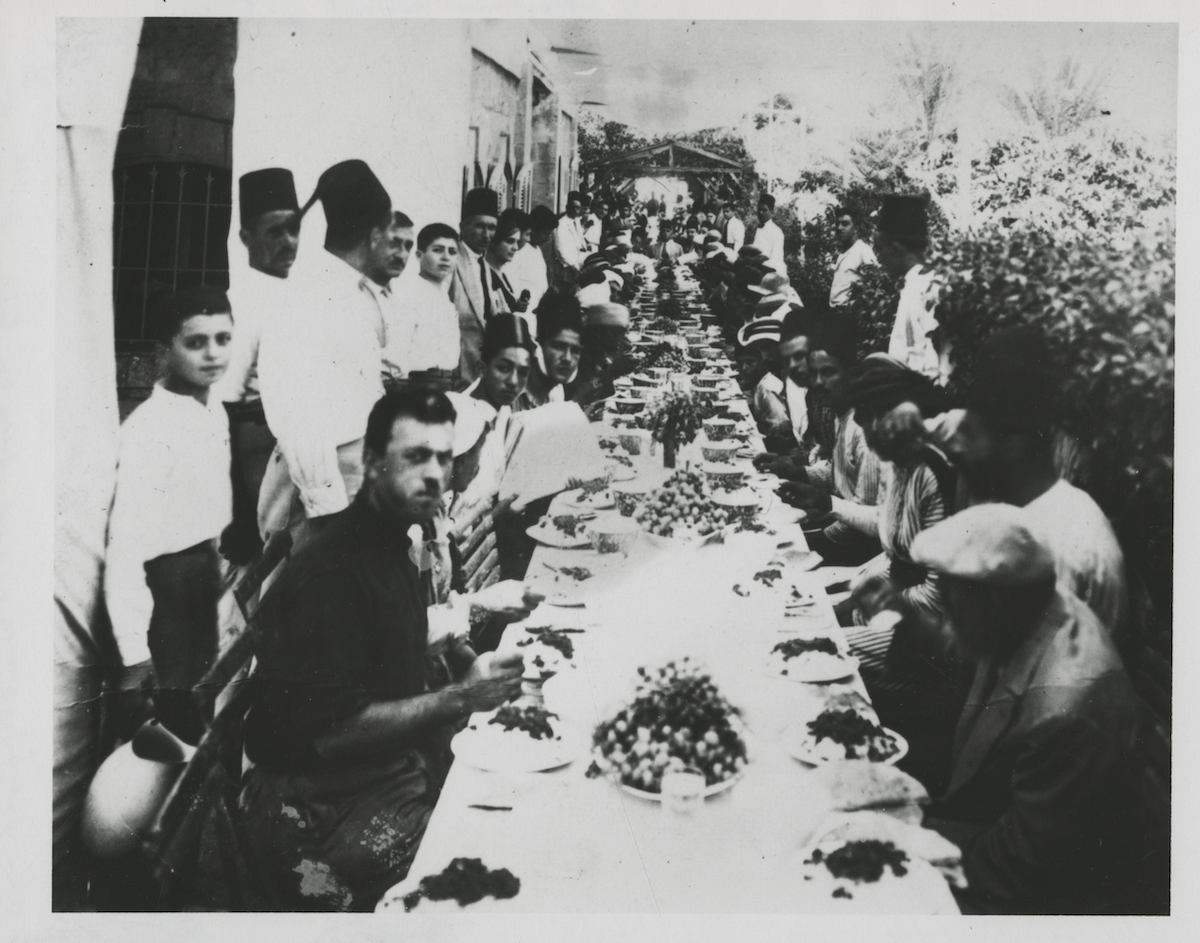
Feeding the poor after the passing of the Greatest Holy Leaf during the 40th day Memorial Feast. The first boy on the left along the wall is ‘Alí Nakhjávání, and the fifth boy on the left is Jalál Nakhjávání. © United States National Bahá'í Archives, used with permission.
As was the tradition in the Middle-East at the time—and as it had been the case with the Ascensions of Bahá'u'lláh and 'Abdu'l-Bahá—a 40-day memorial feast was held in honor of the widely and universally-beloved Greatest Holy Leaf.
The memorial feast in honor of Greatest Holy Leaf took place 40 days after the Greatest Holy Leaf’s passing on 25 August 1932 in the beautiful garden of 'Abdu'l-Bahá which she loved so much.
The memorial feast for Bahíyyih Khánum was an event of massive proportions and had required logistical planning for the large number of guests as well as the food and decoration.
The Bahá'ís were frantically busy cooking, cleaning, laying tables, serving. Among those who served during the memorial feast was future member of the Universal House of Justice, ‘Alí Nakhjávání.
The Bahá'ís had arranged for a very long table seating 100 people to be laid out.
To provide shelter for the hundreds of people waiting to be seated and eat, the Bahá'ís had erected a tent in the garden to shield from the full summer sun.
Over the course of the day, 10 or 11 groups of 100 people sat at that table, meaning the Bahá'ís hosted as many as 1,100 people on that day.
The memorial feast lasted from the morning until about 3:00 or 4:00 PM.
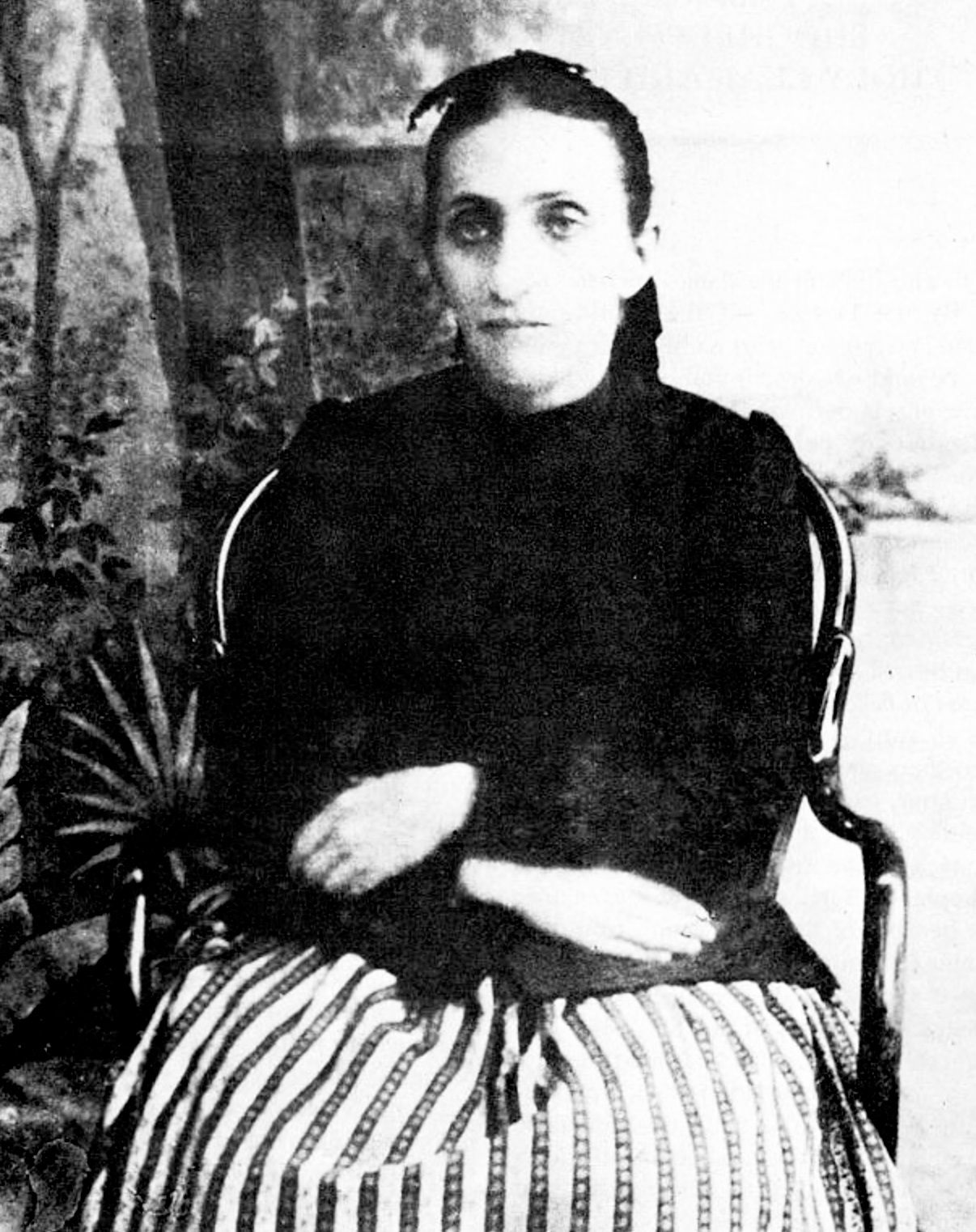
The Greatest Holy Leaf in 1890. This photograph was taken while Bahíyyih Khánum’s Father, Bahá'u'lláh, was still alive. Source: Bahaimedia.
The Guardian, still in Europe, was present in spirit at the fortieth-day memorial feast.
Shoghi Effendi had sent £100— £8,800 in today’s currency—an amount of great and significant value in 1932, and asked the Haifa Municipality to distribute the sum to the poor of Haifa in the name of the Greatest Holy Leaf.
To their credit, the Haifa Municipality took out an announcement in the local newspapers informing them of the donation and they even set up a special committee to find suitable applicants and give out the money not only responsibly but to those who needed it the most.
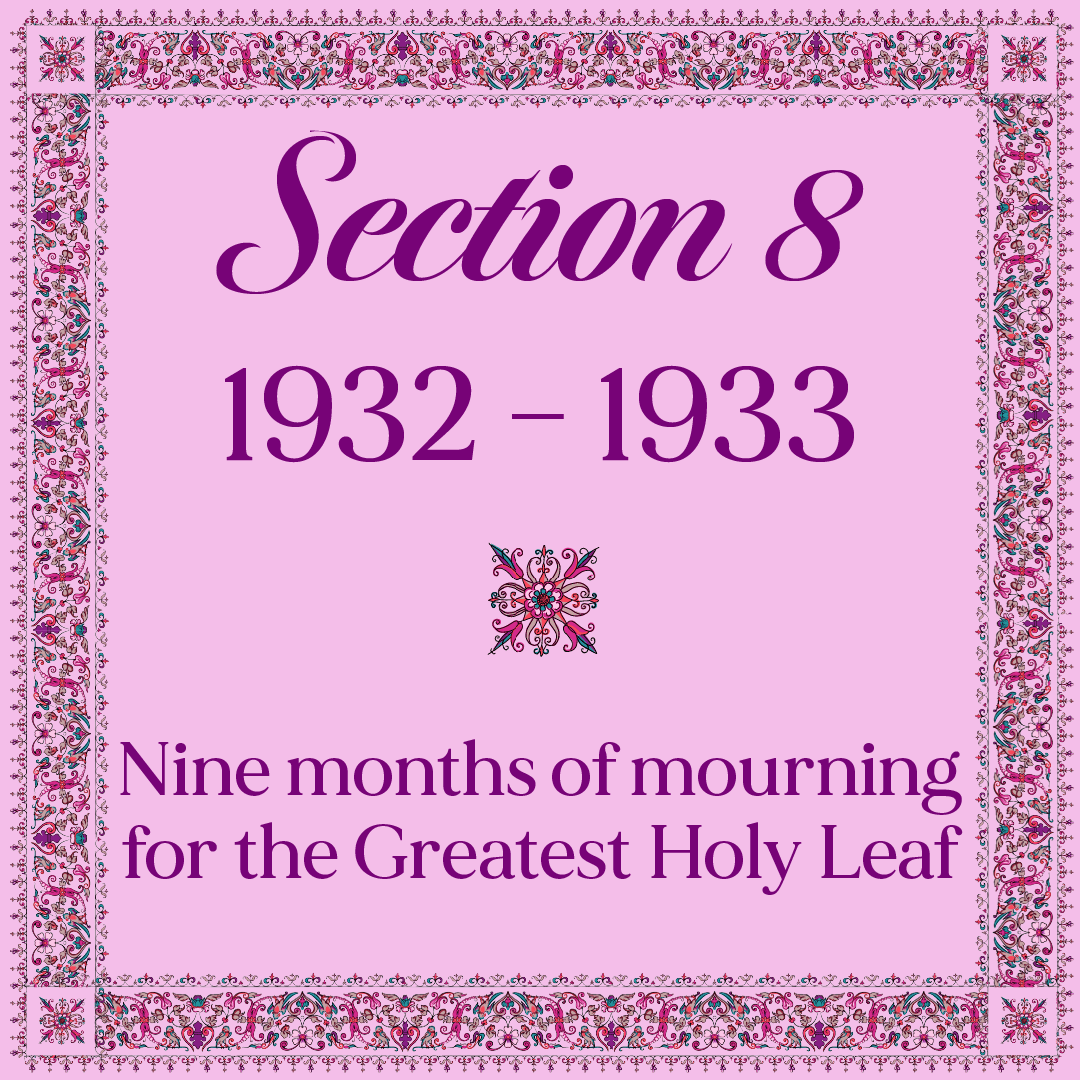
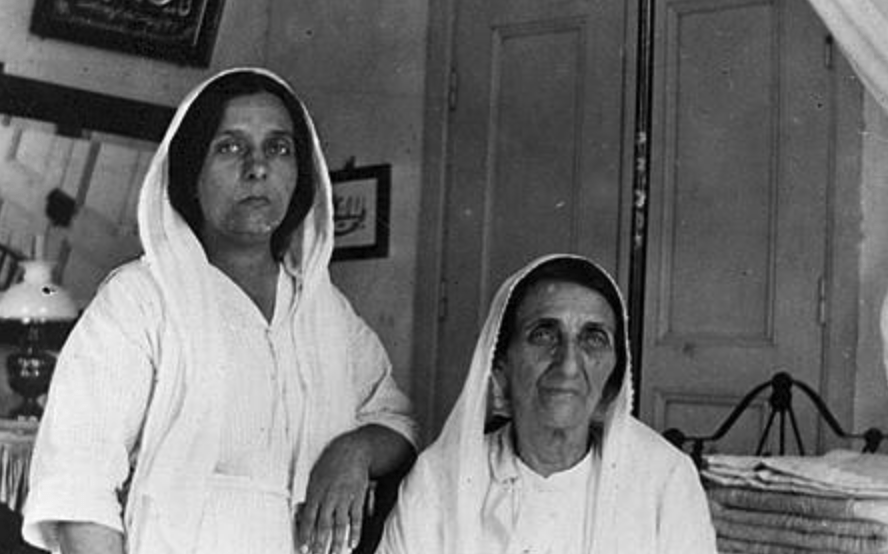
The Greatest Holy Leaf with Ḍíyá‘íyyih Khánum, her eldest niece, in Haifa around 1920. Source: Bahai Biblio.
Immediately after the Greatest Holy Leaf passed away, the Guardian called for nine months of mourning in the worldwide Bahá'í community from 15 July 1932 until 15 April 1933.
The 15 July 1932 cable the Guardian sent to the Bahá'ís of the United States and Canada read:
So grievous a bereavement necessitates suspension for nine months throughout Bahá’í world every manner religious festivity. Inform Local Assemblies and groups hold befitting manner memorial gatherings extol a life so laden sacred experiences, so rich imperishable memories. Advise holding additional commemoration service of strictly devotional character auditorium Mashriqu’l-Adhkár.
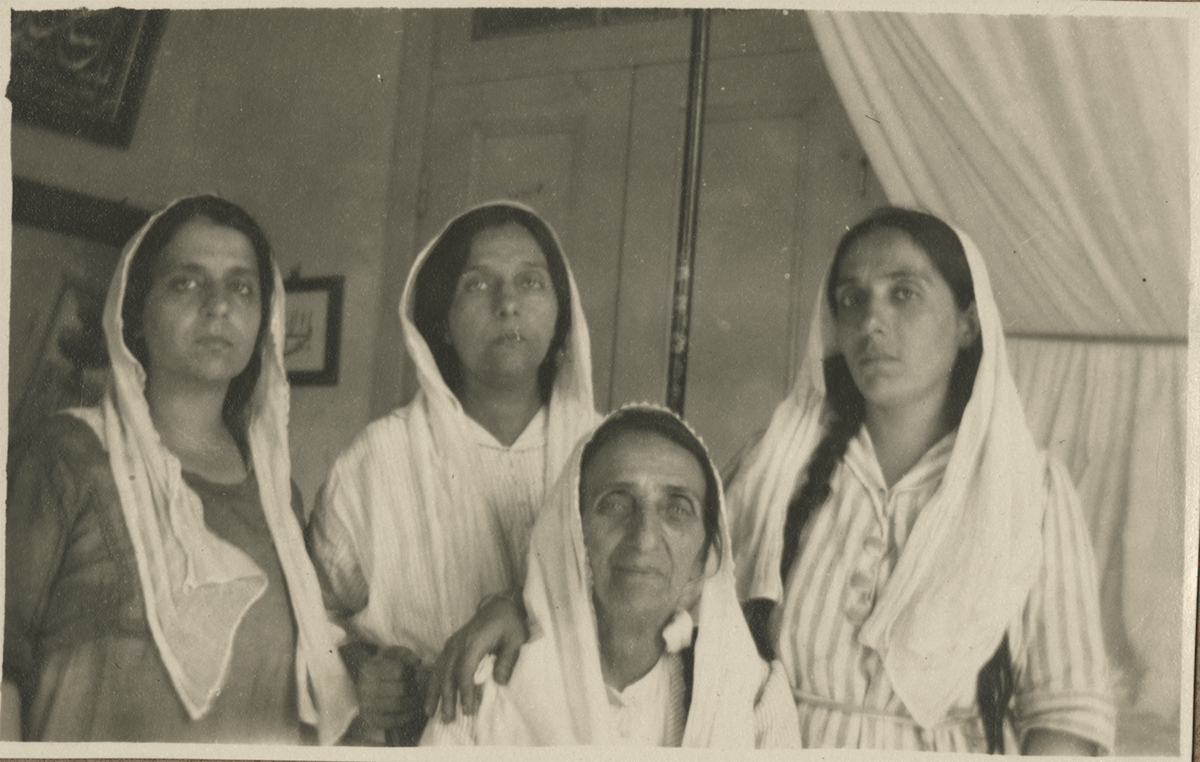
The Greatest Holy Leaf in the center, surrounded by three of her nieces, the daughters of 'Abdu'l-Bahá, from left to right: Munavvar Khánum, Ḍíyá‘íyyih Khánum—the mother of Shoghi Effendi—and Túbá Khánum with her hand around her aunt. © United States National Bahá'í Archives, used with permission.
That very same day, in another letter, Shoghi Effendi further explained the significance of these nine months of mourning for the passing of the Greatest Holy Leaf, this time to the Bahá'ís of the east.
In this excerpt, the Guardian mentions the “most high station” of the Greatest Holy Leaf, and specific the events that should be postponed, celebrations, festivals and even personal celebrations—these for a period of a year—instead replaced by deeply spiritual memorial meetings to honor the daughter of Bahá'u'lláh:
It is right and fitting that out of honour to her most high station, in the gatherings of the followers of Bahá’u’lláh, whether of the East or the West, all Bahá’í festivals and celebrations should be completely suspended for a period of nine months, and that in every city and village, memorial meetings should be held, with all solemnity, spirituality, lowliness and consecration—where, in the choicest of language, may be described at length the shining attributes of that most resplendent Leaf, that archetype of the people of Bahá.
If it be possible for the individual believers to postpone their personal celebrations for a period of one year, let them unhesitatingly do so thus to express their sorrow at this agonizing misfortune.
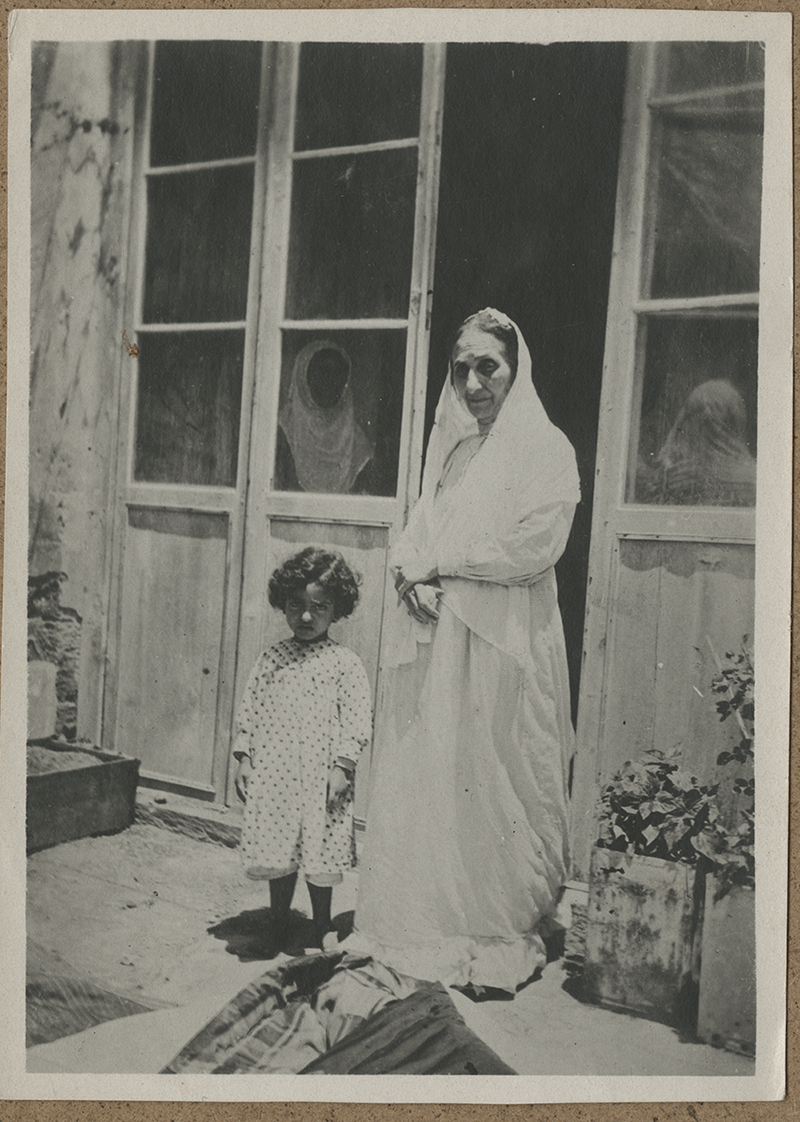
Photograph of the Greatest Holy Leaf and her grand-nephew Soheil Afnán or Fu’ad, sons of Túbá Khánum, one of the daughters of 'Abdu'l-Bahá and Munírih Khánum. There are two identical photographs in the United States National Bahá'í Archives, one stating the child is Fu’ad, another saying it is Soheil. This photograph was most likely taken in 1920, along with the other photographs taken of the Greatest Holy Leaf with Fu’ad and Soheil from the United States National Bahá'í Archives. © United States National Bahá'í Archives, used with permission.
In his cables announcing the passing of Bahíyyih Khánum, the Guardian called for or a period of nine months, from 15 July 1932 until 15 April 1933 of nine months of mourning.
The Guardian eloquently described the character of these nine months of mourning and they involved a number of aspects:
- The suspension of “every manner [of] religious festivity” amd “all Bahá’í festivals and celebrations” which included both indoor and outdoor gatherings where were not purely spiritual or devotional in nature. These included Naw-Rúz and Riḍván, as well as the births of Bahá'u'lláh and the Báb.
- Theh Guardian did not suspend 19-Day Feasts during the nine months of mourning, but advised that they should be conducted with the utmost simplicity.
- Holding “befitting memorial gatherings” in every city and village
- These memorial gatherings should be “held, with all solemnity, spirituality, lowliness and consecration—where, in the choicest of language, may be described at length the shining attributes of that most resplendent Leaf, that archetype of the people of Bahá.”
- Holding additional devotional meetings in Houses of Worship
- Individual believers should, in order to express their profound sorrow at the passing of the Greatest Holy Leaf “postpone their personal celebrations for a period of one year”
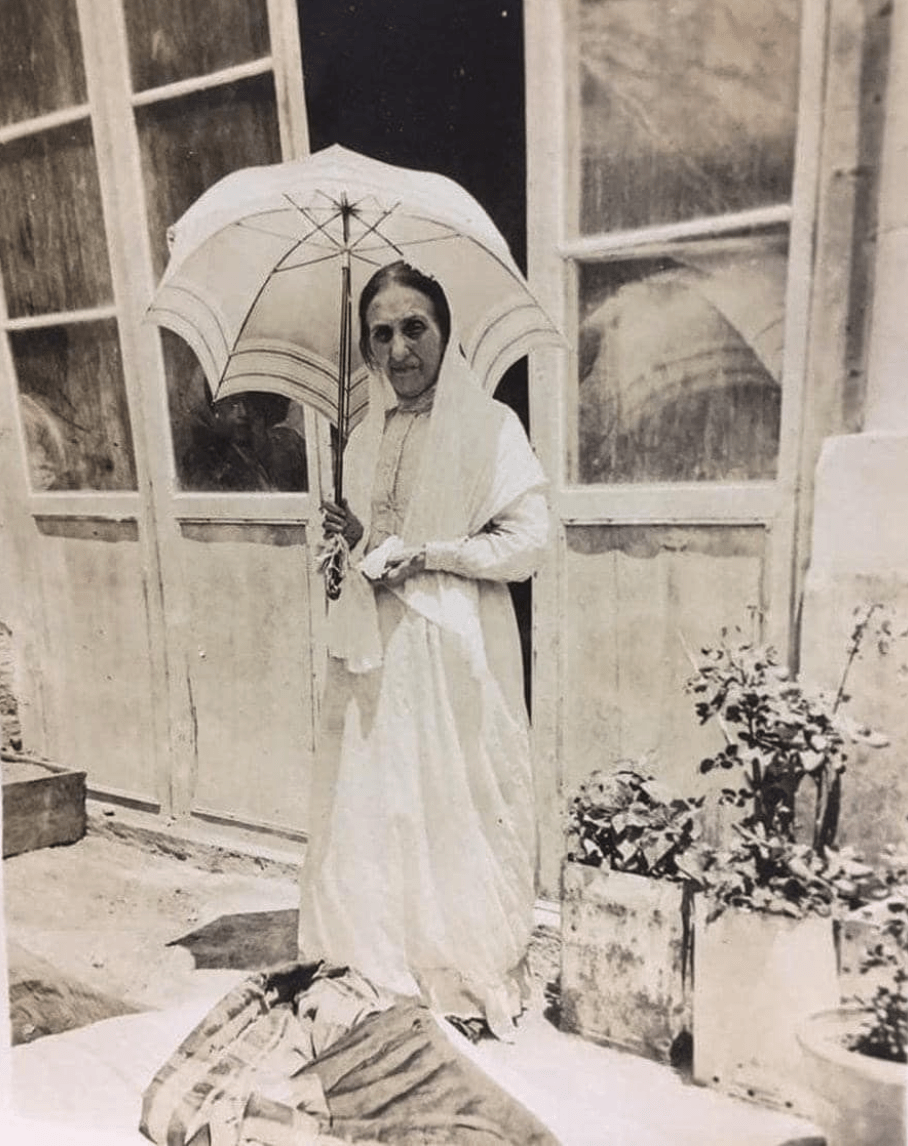
The Greatest Holy Leaf holding a parasol. Source: Find a Grave.
The Bahá'í community worldwide held, as per the Guardian’s request, memorial gatherings for the Greatest Holy Leaf.
Deeply moving memorial gatherings were held in the evenings in Australia, and participants felt moved when they realized what a tremendous source of comfort Bahíyyih Khánum had been to the Holy Family and the Guardian.
In New Zealand, they held a memorial meeting where they read the excerpts the Guardian had circulated about her revealed by Bahá'u'lláh and 'Abdu'l-Bahá. The Greatest Holy Leaf’s life of service and sacrifice touched all those present, as did her example of a life of service and love.
In the New Zealand gathering, those who had had the privilege of entering the presence of the Greatest Holy Leaf spoke of her love, and the unforgettable memory of meeting her and what an influence it had had on their souls. They reported:
Following the sad news of the passing of the Greatest Holy Leaf, a memorial meeting was held at which were read excerpts from the Writings in reference to her wonderful life of sacrifice and loving service, and the tribute written by Shoghi Effendi.

Closeup of the 1895 portrait of Bahíyyih Khánum. Source: Bahá'í Media Bank, © Bahá'í International Community 2024.
Persia, the land of Bahíyyih Khánum’s birth, held memorial meetings during the nine months of mourning in her honor.
In Ṭihrán, the city of her birth, the Bahá'ís designated 21 July 1932 almost as a Holy Day: Bahá'ís did not go to work that day.
After the Greatest Holy Leaf’s passing, the Bahá'ís of Ṭihrán held nine days of memorial services, in various neighborhoods of Ṭihrán, and these nine-day memorials continued every 19 days—every Bahá'í month—for the 9-month mourning period.
Keith Ransom-Kehler gave a powerful talk at the first of these 9 memorial meetings.
During these memorial services, the Bahá'ís told stories from the Greatest Holy Leaf’s life and chanted Tablets which had been revealed in her honor.
The Bahá'ís of Ṭihrán fed over 700 people over the courses of 10 memorial suppers during this same period.
On 21 March 9133, the day of Naw-Rúz—and traditionally a day of great celebration in Bahá'í communities—all festivities were suspended.
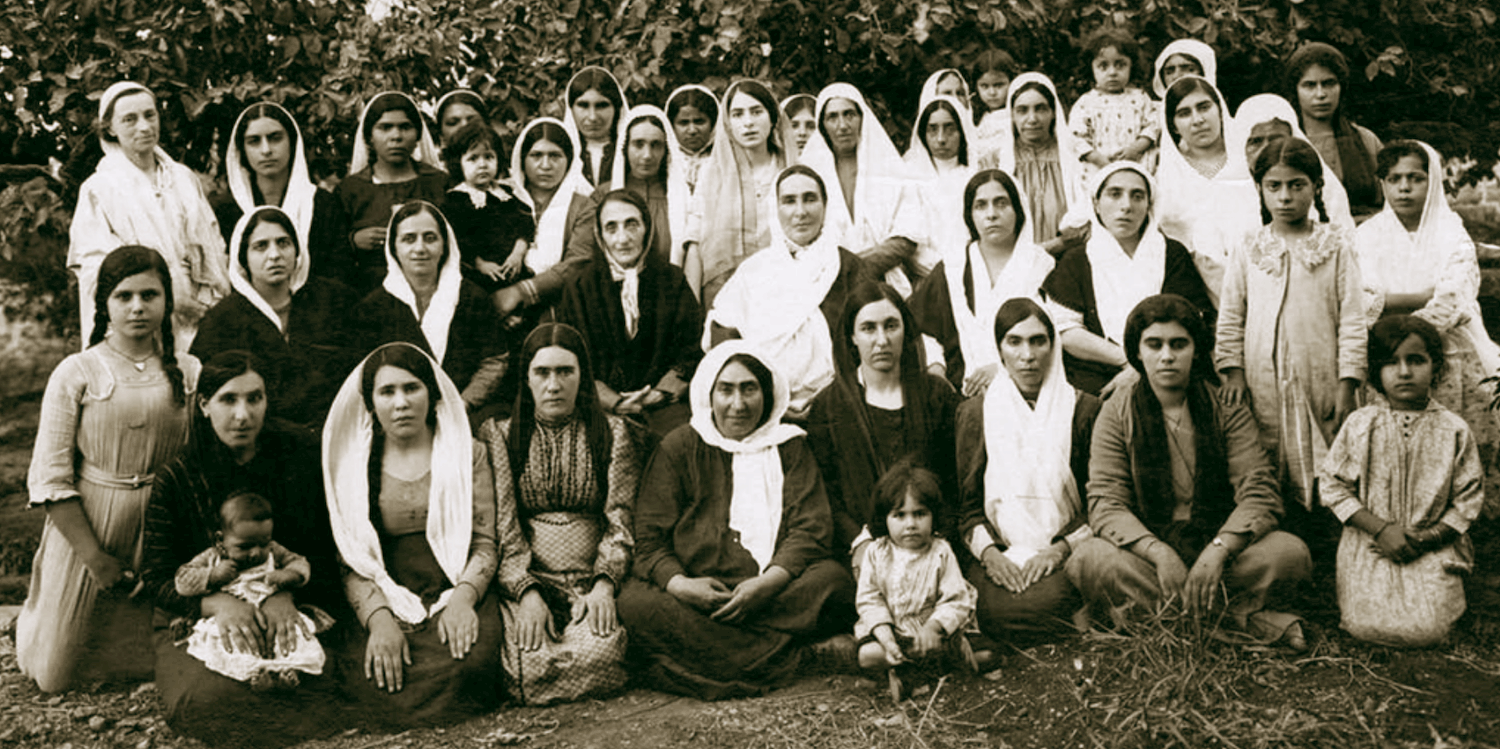
The Women of the Holy Family and other Bahá'í women all gathered around Bahíyyih Khánum, the Greatest Holy Leaf in a black dress and scarf around her head, and next to her, her sister-in-law Munírih Khánum, the widow of 'Abdu'l-Bahá wearing a large white scarf around her head. Two daughters of 'Abdu'l-Bahá are on either side of Bahíyyih Khánum and Munírih Khánum. Daily Baha'i Photos Website.
Future Hand of the Cause and first American Bahá'í martyr, Keith Ransom-Kehler was on a mission to Persia at the request of the Guardian and she spoke with great emotion and regularly to the Persian Bahá'í communities about the Greatest Holy Leaf.
Keith was a powerful and talented speaker, and there is no doubt that her talks about the Greatest Holy Leaf mere not only moving but comforting to the Persian believers who attended them. She once spoke to an audience of 100 believers.
Shortly before she passed away from smallpox in Iṣfahán on, 23 October 1933, Keith Ransom-Kehler gave a last, unforgettable address to the Persian Bahá'ís where she recalled Bahíyyih Khánum’s last words to her as she left Haifa in 1932:
When saying good-bye to the Greatest Holy Leaf, she told me to give to the men as well as to the women the same message of love equally. She said also, “When you enter the holy city of Ṭihrán, enter it in my name and when you speak, speak in my name.”
The most moving part of Keith’s recollections of the Greatest Holy Leaf’s last words to her, were, in fact, that she and the Persian Bahá'ís realized in retrospect that they were her last message to them, that they were in fact, her last words, her parting words, and that she knew her physical life was soon coming to an end.
And the words she. Had chosen to convey were words of love.
Keith Ransom-Kehler attended another Bahá'í memorial meeting where many, many Bahá'ís were present: young and old, adults and children. Everyone was seated on two flights of steps. The steps and the veranda of the home were utterly packed with Bahá'ís. Everyone was staring at the American Bahá'í, sent to Persia by the Guardian himself, and Keith was crying when she said:
Only the unlimited power of Bahá’u’lláh is able to attract such a love and unity and bring about this soul-to-soul communion between the East and the West.
That was the power of the Greatest Holy Leaf.
This was the essence of the unity of mankind, the Bahá'í Faith’s central concept: an American woman, speaking to Persian Bahá'ís about the Greatest Holy Leaf, a daughter of Persia, in a way that moved their hearts and souls.
Accordion Sample Description
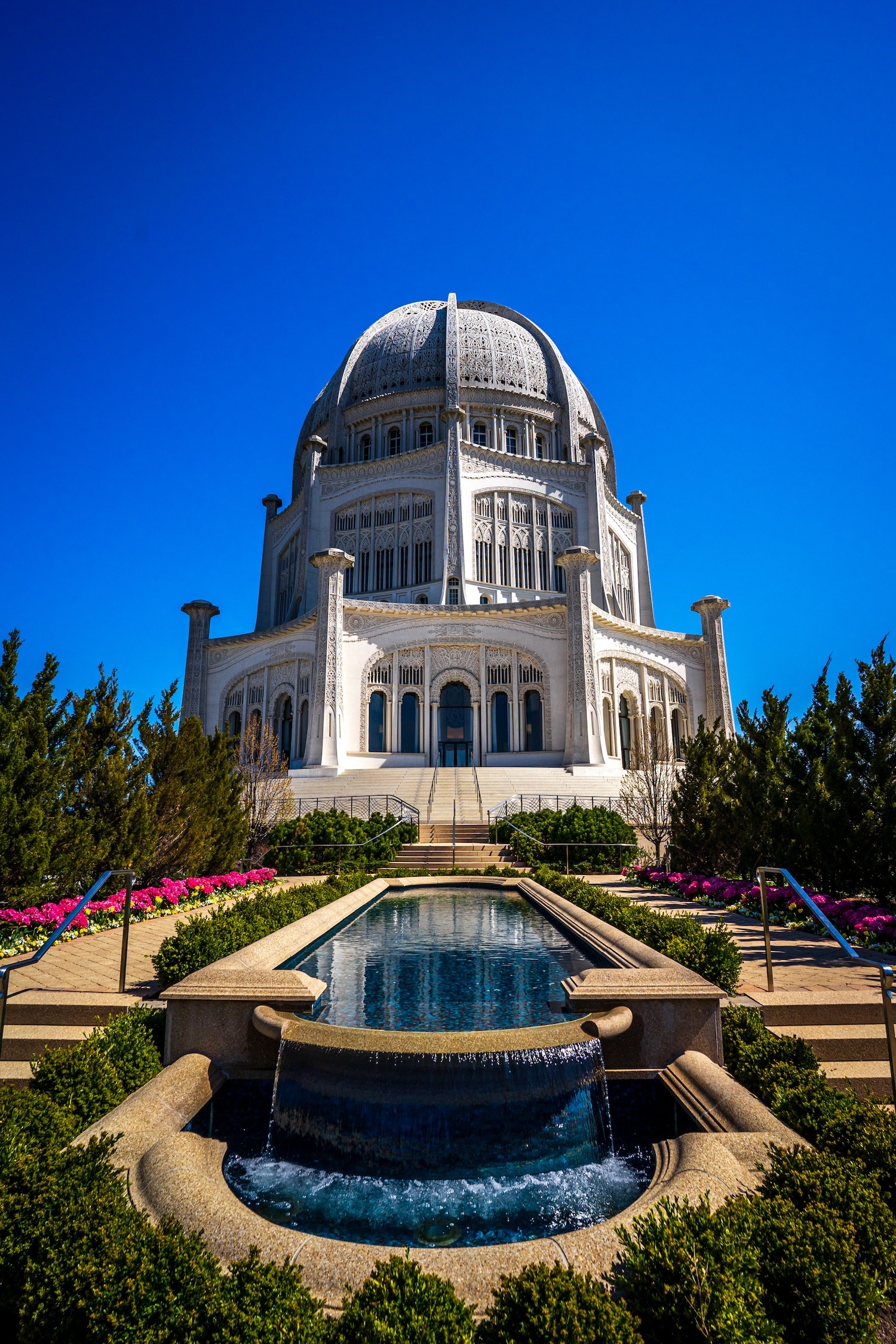
A stunning view of the House of Worship for North America in Wilmette, Illinois. Photograph by Farzam Sabetian. Source: Luminous Spot.
A little less than two months after the passing of the Greatest Holy Leaf, Shoghi Effendi, reeling with pain, sadness, and grief, managed to find it within himself to write a letter to the National Spiritual Assembly of the United States and Canada dated 12 September 1932.
In the following excerpt, the Guardian offers a stunning gift to the Bahá'ís of North America.
He tells them that their progress on the construction and ornamentation of the House of Worship was a true joy for the Greatest Holy Leaf in her last days, and inspires them to redouble their efforts, telling them that it would gladden her soul in the next world. He calls the completion of the House of Worship her “dearest wish and fondest hopes”:
The passing of the Greatest Holy Leaf has filled my heart with unutterable sorrow. My comfort is the thought that the measure of success achieved, under your wise and able leadership, by the collective efforts of the American believers has brightened considerably the last days of her precious life.
Would to God that the continued endeavours of this little band of her devoted lovers who have brought so great a joy to her blessed heart, may bring further satisfaction to her soul, and realize, at the appointed time, her dearest wish and fondest hopes for the Cause in your land.
To complete the Temple, to clothe its naked dome, and terminate its exterior elaborate ornamentation, is the best and most effective way in which the American believers, the recipients of her untold favours, can demonstrate their fidelity to her memory and their gratitude for the inestimable blessings she showered upon them.
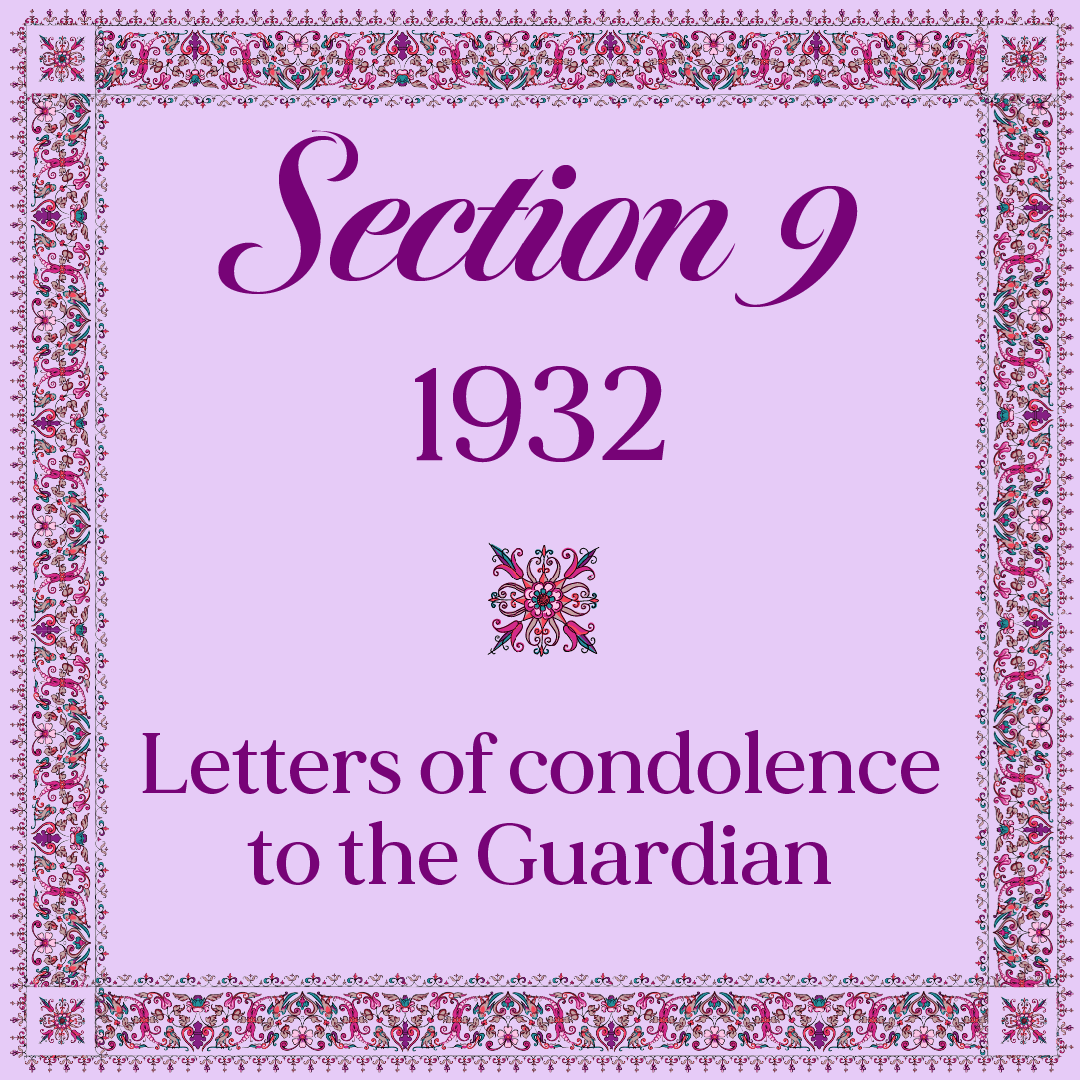

The Greatest Holy Leaf, Lady Blomfield, and two of 'Abdu'l-Baha's daughters, circa 1921, shortly after the passing of 'Abdu'l-Baha. Source: Worldwide Community of Bahá'u'lláh
The exchange of letters between individual Bahá'ís in the east and the west, in Persian and in English’s, and the Guardian’s loving and personal response to each and every cable and letter served several purposes.
On the one hand, they acted as a balm for the overwhelming grief of the individual Bahá'ís and Bahá'í institutions.
In these letters, the Guardian was able to lift the veil on the great station of the Greatest Holy Leaf and so these letters also served to deepen the Bahá'ís.
Through these letters, the Guardian also strengthened his personal bond with Bahá'ís in their mutual shared grief of the very great and irreparable loss of the saintly Greatest Holy Leaf.
These letters and the Guardian’s responses to them were exchanges based on a shared love of the Greatest Holy Leaf bond between Bahá'ís and their Guardian on their feelings of loss and grief.
To this effect, we have selected six short excerpts from letters written by the Guardian in response to condolence letters received by various Bahá'í communities.

Vintage postcard of Yonkers, New York.
Another aspect of these exchanges, spearheaded by the Guardian was to, in essence, use the opportunity of comforting the believers over the loss of the Greatest Holy Leaf to focus their efforts on the growth, development, and propagation of the Faith, the only thing the Greatest Holy Leaf cared about. Her entire life had been dedicated to serving the Bahá'ís and to furthering the Faith of Bahá'u'lláh.
For example, on 23 August 1932, the Guardian wrote to the Spiritual Assembly of the Bahá'ís of Yonkers, N.Y., and inspired to them to renewed courage and hope:
…He is eagerly awaiting to see the friends as ever burning with the desire to serve a Cause for the sake of which our departed Holy Leaf gave up her entire existence.
May her glorious spirit cheer your hearts, strengthen your faith and inspire you with renewed courage and hope.

Vintage postcard of Racine, Wisconsin.
A week later, Shoghi Effendi wrote to the Local Spiritual Assemblies of Racine, Wisconsin in. which he roused them to action and service:
The Guardian sends messages of consolation to you and all the friends in this bereavement, and he says that in this calamitous time all must bow down their heads and be acquiescent, arise in faithful service to His Cause, and model themselves upon that most exalted, sacred and resplendent presence [of the Greatest Holy Leaf].
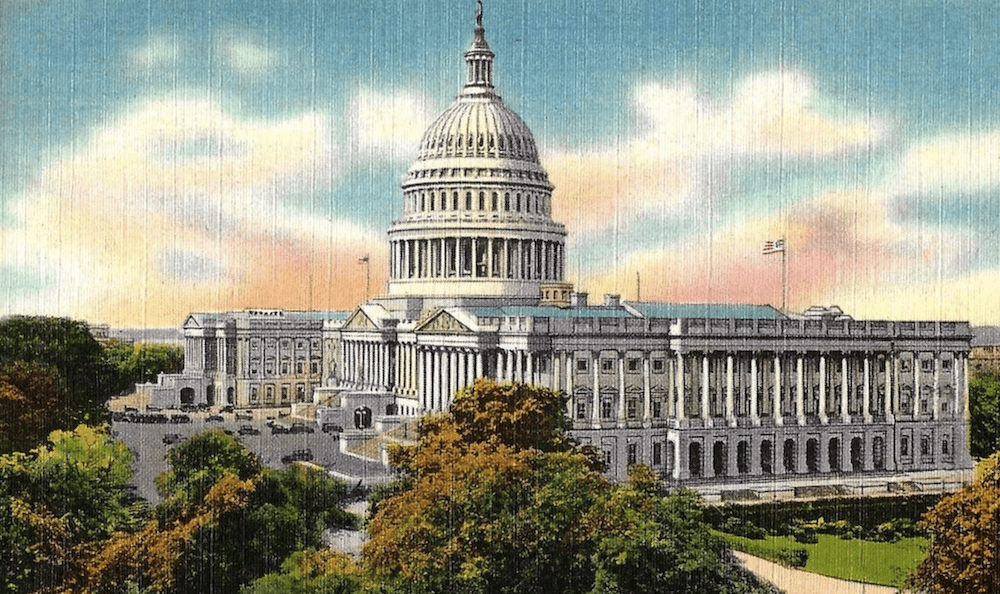
Vintage postcard of the U.S. Capitol in Washington, D.C.
The Guardian’ wielded his pen for months after the Greatest Holy Leaf’s passing, offering encouragement to individual believers in the east and west, in English and in Persian, and he deepened their understanding of her station and comforted them in their loss.
But gradually, the Bahá'ís themselves became acutely aware that the Guardian himself was in a state of deep grief, and they began to write letters to Shoghi Effendi expressing their sadness at his sorrow and his loss. These messages of sympathy was a source of comfort to the Guardian, and he responded to each of them individually.
On 1 September 1932, the Guardian wrote a kind letter to the Bahá'ís of Washington, D.C., expressing his deep gratitude for their touching condolence message:
Your highly impressive and touching message brought much relief to my weary soul. I thank you from the depths of my heart. I greatly value the sentiments expressed on behalf of a local community, the members of which have, by their services, their devotion and loyalty, contributed, to so great an extent, to the joy and satisfaction of the hearts of both 'Abdu'l-Bahá and the Greatest Holy Leaf. My great attachment to each one of you, as well as my immense love for our departed and beloved Khánum, have prompted me to add these few words in person. I will continue to pray for the success of your efforts, as well as for your spiritual advancement.
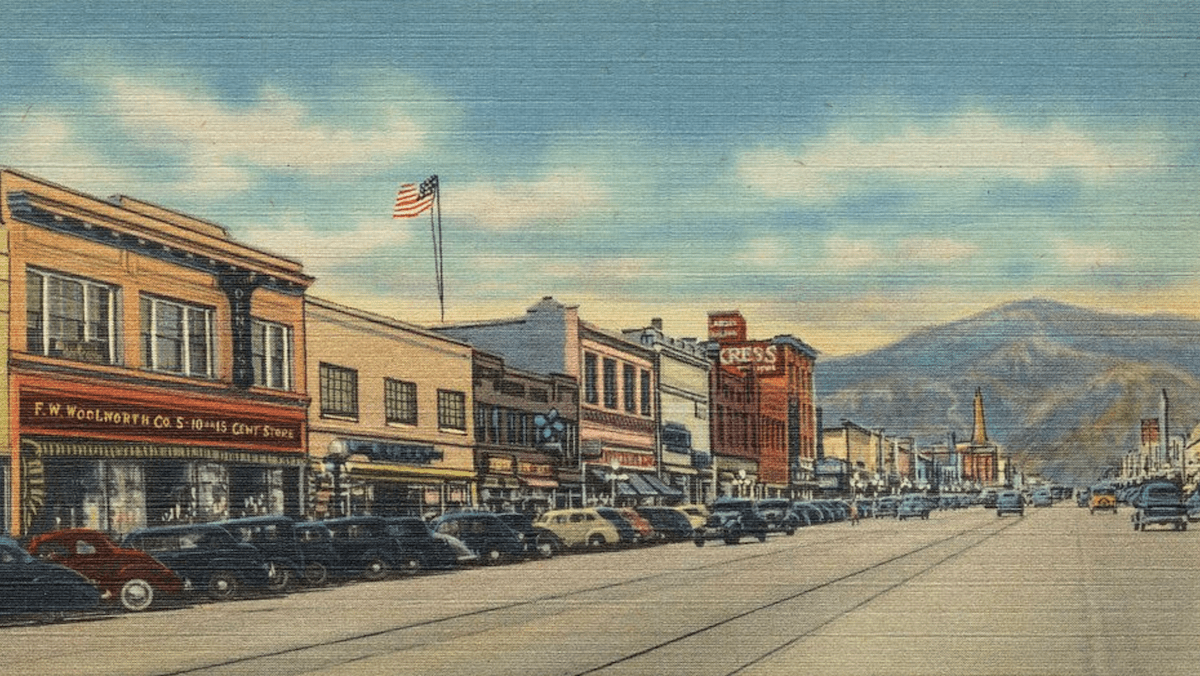
Vintage postcard of North Brand Boulevard in Glendale, California.
The Bahá'ís the world over had lost a mother-figure, a grandmother-figure, a beloved and adored friend, a confidante, the last link they had to Bahá'u'lláh. Their loss was intense, their grief was profound, their sadness was unfathomably deep.
And the Guardian addressed these feelings in this same letter with these deeply compassionate words, written to the Bahá'ís of Glendale, California on 10 September 1932:
The loss of the Greatest Holy Leaf will be bitterly felt by all those friends who had the pleasure and privilege to meet her.
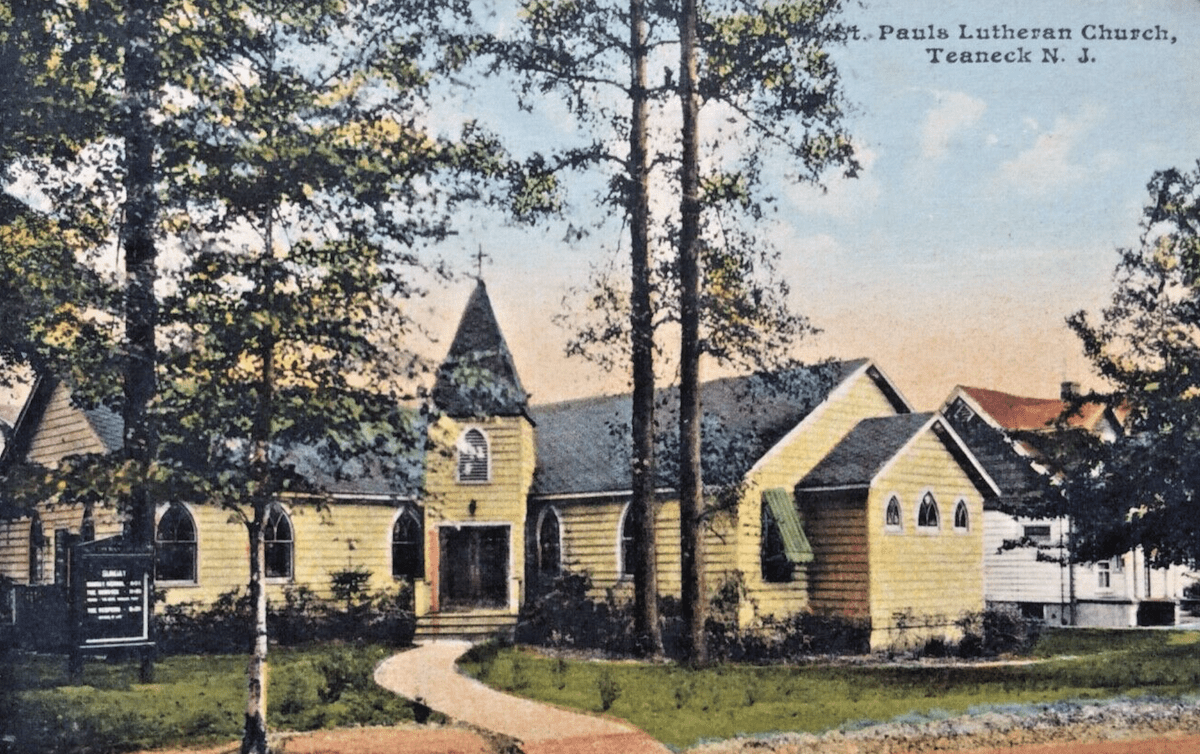
Vintage postcard of Paul’s Lutheran Church in Teaneck, New Jersey.
Another wonderful example of the kindness and thoughtfulness of the Guardian in his own deep time of grief is an excerpt from a letter he wrote to the Local Spiritual Assembly of Teaneck, New Jersey on 11 October 1932, thanking them for their comfort and kindness:
I greatly value the expression of your loving sympathy and am greatly relieved by the sentiments your message conveyed. I will pray that you may be assisted, individually and collectively, to follow her inspiring example, to bring happiness
to her soul, and to proclaim far and wide the purity of her life, the immensity of her love, and the supreme nobility of her character.
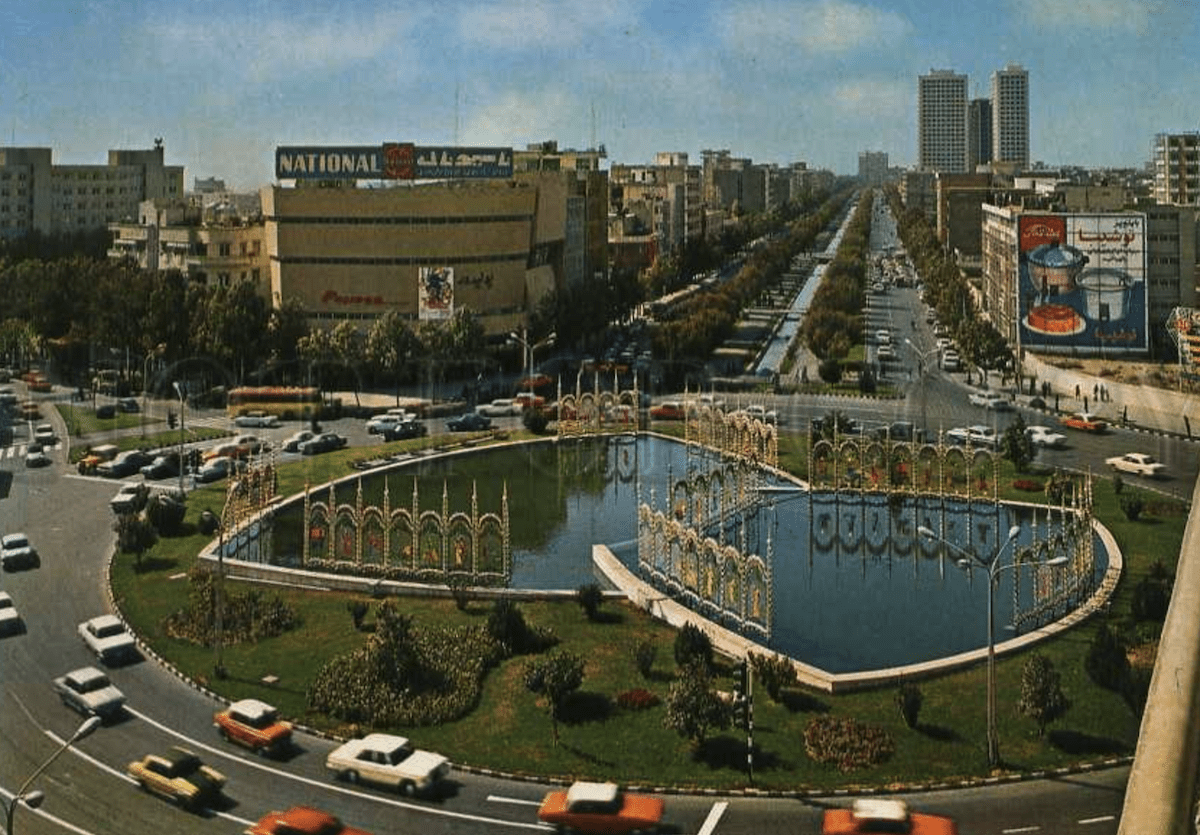
Vintage postcard of Vali Asr square in Tehran.
In yet another Persian letter dated 13 December 1932 to the Bahá'ís of Persia, Shoghi Effendi offers a balm to their suffering, focusing on the positive: the fact this individual was able to meet Bahíyyih Khánum in person, a kind perspective that no doubt assuaged the individua’s feeling of loss, and a deeply compassionate thing for the Guardian to say:
You should be very happy to have had the privilege of meeting her upon this physical plane of existence, for the world has seen only very few such souls who have suffered so much for the sake of God and yet kept their cheer and uttered words of hope and encouragement to those who were around them.
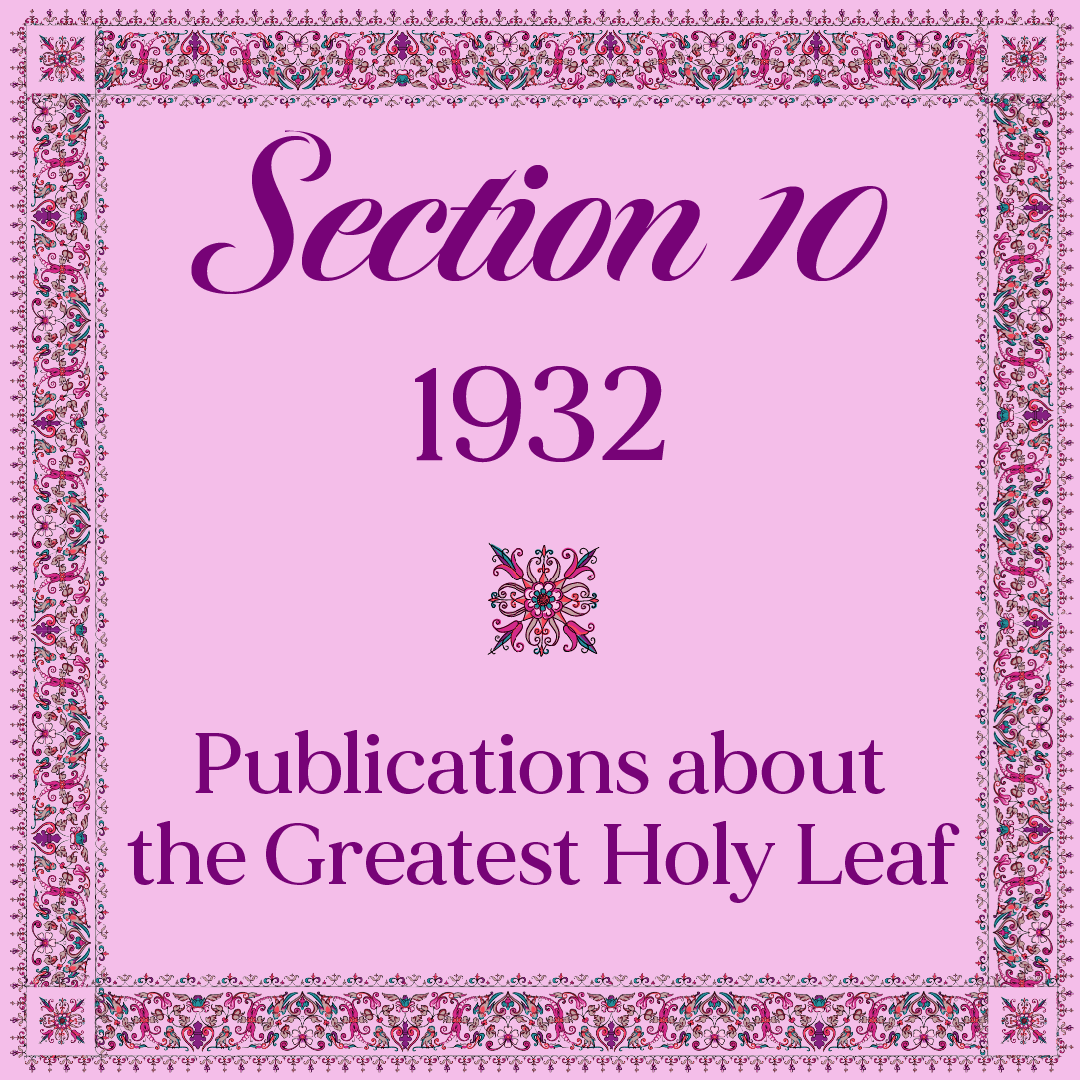
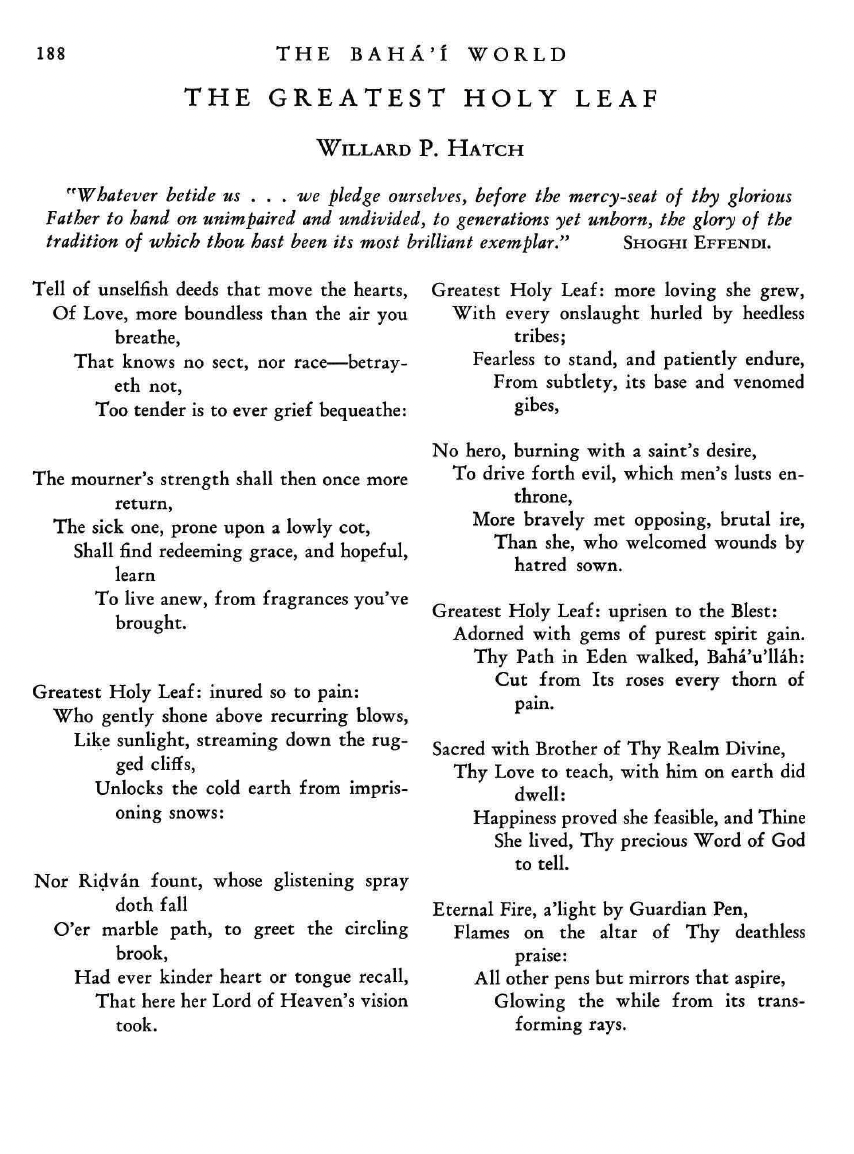
A poem composed by Willard P. Hatch and published in The Bahá'í World Volume 18, page 188.
In 1932, the most mature and experience National Spiritual Assemblies in the world were those of the National Spiritual Assembly of the United States and Canada and Persia, and the Guardian assigned them each special tasks.
The National Spiritual Assembly of the United States and Canada published a color facsimile reproduction of the Guardian’s 16-page moving, handwritten tribute to the Greatest Holy Leaf, a tribute in which he not only poured his love and gratitude out to the Greatest Holy Leaf but in which he expressed his undying gratitude for her priceless services to the Cause.
In the days following the passing of the Greatest Holy Leaf, the Guardian had assembled excerpts regarding her lofty station from the Holy Writings of Bahá'u'lláh and 'Abdu'l-Bahá, and he now asked the National Spiritual Assembly of the United States and Canada to take measures to distribute these excerpts as widely as possible among the Bahá'í communities of the west.
The effect of both these publication on western Bahá'ís and western Bahá'í communities was significant. They began to form an accurate understanding of the peerless station of the Greatest Holy Leaf, but not only that, they began to slowly understand her incredible contributions to the propagation and defense of the faith.
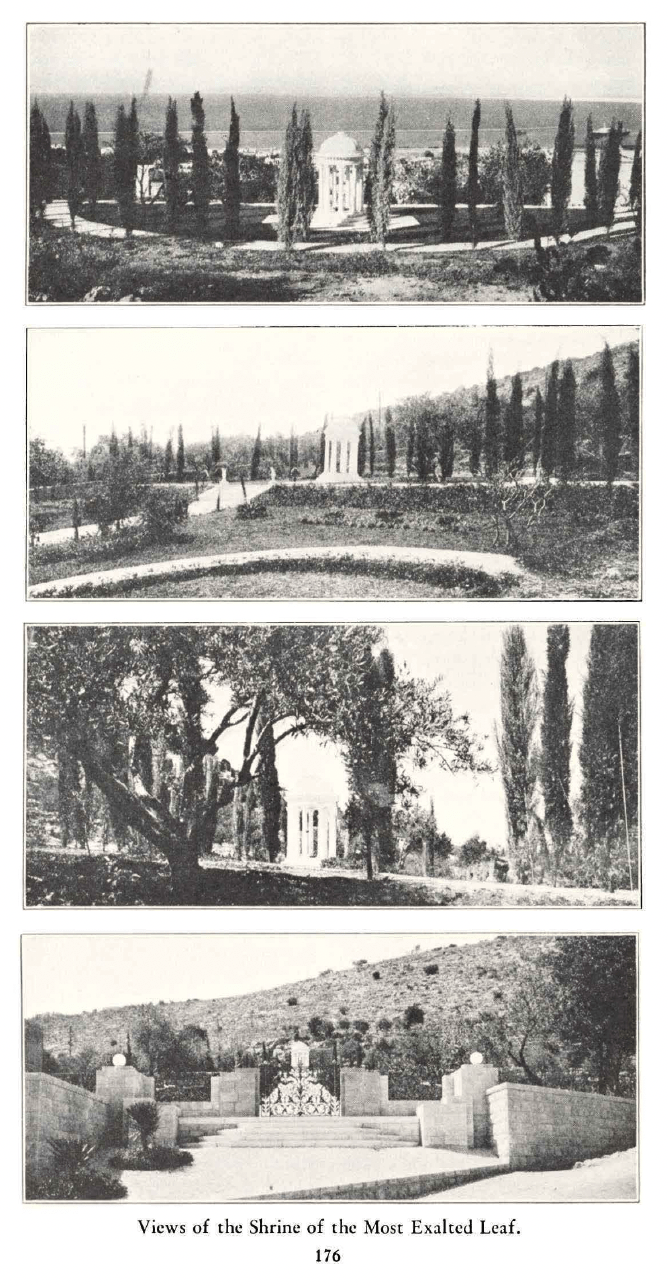
Four photographs of the monument to the Greatest Holy Leaf published in The Bahá'í World Volume 18, page 176.
As for the National Spiritual Assembly of Persia, the Guardian asked them to disseminate these same excerpts from the Holy Writings of Bahá'u'lláh and 'Abdu'l-Bahá “immediately and with great care” in a letter dated 13 December 1932, to the Bahá'ís of Persia:
O ye distracted lovers of that winsome countenance! It is meet and fitting that in the gatherings of the loved ones of God and the handmaids of the Merciful in all the countries and lands of the East, these shining words and clear tokens from the Supreme Pen and His Interpreter's wonder-working hand—verses which were revealed for that priceless treasure of the Kingdom—should be repeatedly recited, most movingly with devotion and lowliness, and great attention and care, so as to perpetuate her blessed memory, and extol her station, and out of love also for her incomparable beauty.
May the honoured members of the Central Assembly of Iran circulate these Writings, immediately and with great care, to the countries of the East, through their Local Spiritual Assemblies; for this task is a great bounty especially set apart for the trustees of His devoted loved ones in that noble homeland. May God reward them with excellent rewards, in both this world of His, and in His Kingdom.
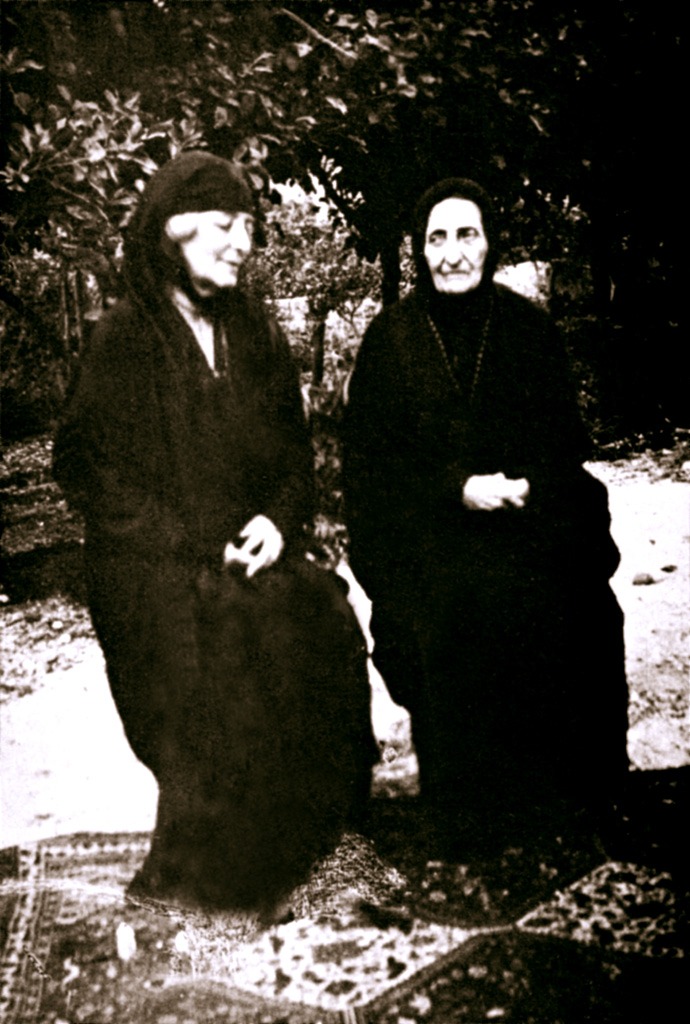
Greatest Holy Leaf with Lady Blomfield, 22 May 1922, Haifa. Source: Worldwide community of Bahá'u'lláh.
On 14 January 1933, six months after the Greatest Holy Leaf’s passing, Shoghi Effendi sent a photograph of the Greatest Holy Leaf and the most significant Tablets Bahá'u'lláh and 'Abdu'l-Bahá ever revealed regarding her station to the National Spiritual Assembly of the United States and Canada, asking them to create pamphlets using the enclosed materials and distribute them to the Bahá'ís of the United States and Canada, and the believers in Europe.
In his cover letter, Shoghi Effendi stated that these passages disclosed “the nature of that mystic bond which on one hand, united her with the Spirit of her Almighty Father and, on the other hand, linked her so closely with her glorious Brother, the perfect Exemplar of that Spirit.”
And he spoke of the Greatest Holy Leaf as “a pattern of goodness, of a pure and holy life, who was the embodiment of such heavenly virtues as only the priviliged inmates of the uppermost chambers in the 'Abhá Paradise can fully appreciate, will long live enshrined in these immortal words—a memory the ennobling influence of which will remain an inspiration and a solace amid the wreckage of a sadly shaken world.”
The Guardian included several excerpts from Tablets revealed by Bahá'u'lláh and 'Abdu'l-Bahá which not only testify to the peerless rank of the Greatest Holy Leaf but shed light on Bahá'u'lláh’s love for His saintly daughter, 'Abdu'l-Bahá’s love for His perfect sister, and Shoghi Effendi’s love for his Great-Aunt.

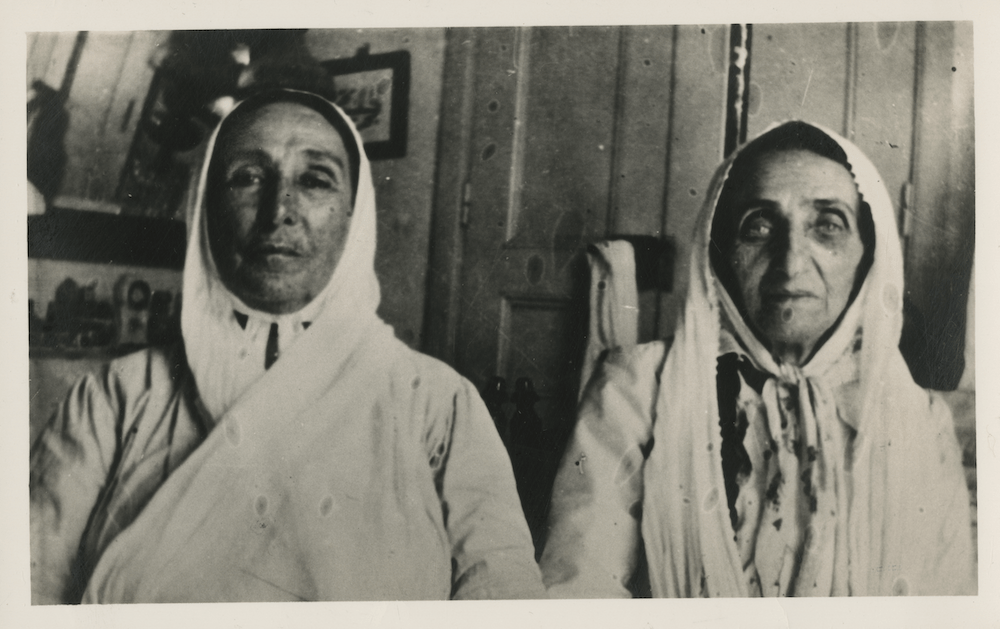
Photograph of Munírih Khánum and the Greatest Holy Leaf. © United States National Bahá'í Archives, used with permission.
Munírih Khánum and Bahíyyih Khánum were close in age—the Greatest Holy Leaf was only one year older than her—and they lived together as loving sisters and deep spiritual friends for 60 years, first in 'Akká in the house of 'Abbúd, then in the house of 'Abdu'lláh Pashá, and finally in Haifa in the house of the Master.
It was the Greatest Holy Leaf who had given Munírih Khánum her white wedding dress on 8 March 1873, the day she married 'Abdu'l-Bahá in the Houe of ‘Abbúd.
The Greatest Holy Leaf and Munírih Khánum had lived vastly different lives.
The Greatest Holy Leaf had cast aside marriage and family life to devote herself entirely to serving her parents, Bahá'u'lláh and Ásíyih Khánum, 'Abdu'l-Bahá, and Shoghi Effendi, as well as the Bahá'í Faith. Service was what her entire reason for being, and complete obedience to the Head of the Faith was her entire life.
Munírih Khánum was the consummate matriarch, referred to by all pilgrims as “Holy Mother.” She had spent her entire life bearing and raising the 9 children she had with 'Abdu'l-Bahá, only four of which, all girls, survived to adulthood. When three of her daughters had children, Munírih Khánum was passionate about her grandchildren.
Despite having lived such different lives, the Greatest Holy Leaf and Munírih Khánum were the closest of friends, they respected each other deeply, and understood each other’s respective rank in the Faith with absolute clarity.
After the Ascension of 'Abdu'l-Bahá, the Greatest Holy Leaf was Munírih Khánum’s comforter, and Munírih Khánum, in turn, fully supported the Greatest Holy Leaf in all the decisions she had to make alone for the funeral of 'Abdu'l-Bahá, the period of mourning and the commemorations. She continued to support the Greatest Holy Leaf, standing firmly with her in their allegiance to Shoghi Effendi, Guardian of the Faith, and she offered her sister-in-law her unconditional support when she was at the headship of the Faith during Shoghi Effendi’s absences.
Munírih Khánum was acutely conscious of Bahíyyih Khánum’s station and rank in the Faith and had seen the way 'Abdu'l-Bahá treated His sister with utmost reverence and tender love and compassion for 50 years, but she also spent a lifetime admiring Bahíyyih Khánum’s roles, first as the deputy of 'Abdu'l-Bahá during His journeys to the west, and then her services to Shoghi Effendi, at the headship of the Faith during his travels.
When the Greatest Holy Leaf passed away on 15 July 1932, only 11 years after her Husband 'Abdu'l-Bahá, Munírih Khánum’s broke. After having lost 'Abdu'l-Bahá, she had now lost her only friend, her only comforter, her closest friend, and her companion for six decades. The best and most positive influence in her life had vanished the moment Bahíyyih Khánum passed away, and for Munírih Khánum, the last six years of her life would be incredibly painful and heart-breaking as members of her immediate family broke the Covenant.
Bahíyyih Khánum and Munírih Khánum in their youth.
Photograph of Bahíyyih Khánum: Source: Bahá'í Media Bank, © Bahá'í International Community 2024.
Photograph of Munírih Khánum: Source: Bahá'í Media Bank, © Bahá'í International Community 2024.
AI background generated by Pikaso AI.O my Lord, O my Lord. Forsake me not, for troubles have encompassed me on all sides. Lord, Lord, leave me not to myself, for misfortune has assailed and seized me.
I sit to write a fitting letter:
A letter of swelling sorrow;
Soiled with my heart's blood,
Patterned with my tears;
Black as Laylí's tresses,
Laid waste like Majnún's soul;
Lacerated like a lover's heart,
Grieved from first to last.O Believers! Immersed in my sorrow and woe
I raise the cup of my own blood to my lips.
Should I say more, breasts would pound.
Should I write all, hearts would break.Whither my Companion, Friend of my soul,
That gentle Confidant of my secret thoughts?
Would that my tears become the sea,
Where I might cast my sorrows.O woe, O woe, O woe is me,
That our precious Sun should be veiled by a cloud.
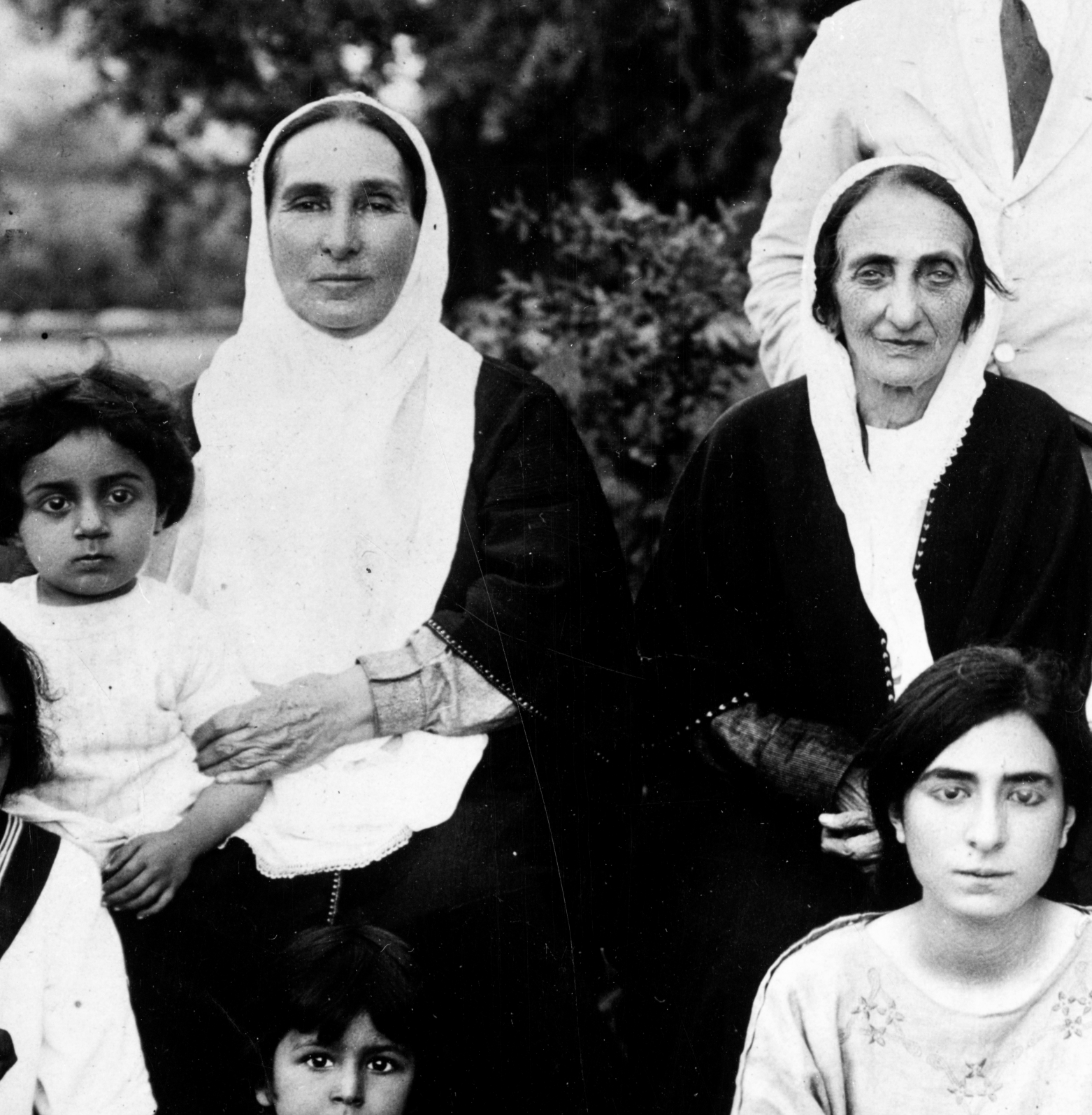
Close up of a previous used group photograph dated 1920 of Munírih Khánum, the Greatest Holy Leaf and the women of the Holy Family. © United States National Bahá'í Archives, used with permission.
O remembrance of the Blessed Beauty, O sister of 'Abdu'l-Bahá, O Greatest Holy Leaf! You have melted us in the furnace of separation and remoteness. You have ascended to your eternal nest in the Kingdom of Abhá. You have even caused the Most Excellent Branch to be depressed and downcast in the prime of his youth and vigor. Now he seeks the company of no one, and is neither happy nor cheerful.
You have cast your Brother's dear children in the fire of separation. They seek neither the company of friend nor of stranger. They sorrow and mourn at all times, and their tears are always flowing.
O friend of our spirits, and solace of our lives, was it not enough for us to have the calamity of the setting of the Most Great Luminary, the Guide of the peoples of the world, Bahá'u'lláh? — May my soul, my being, my existence be a sacrifice for His Name.
Was it not enough for us to bear that sudden blow, the midnight flight, of the Most Great Branch ['Abdu'l-Bahá]? That was cause for cries of grief and lament from the people of Palestine to reach the heights of heaven, and for all means of pleasure to be abandoned. Indeed, joy and entertainment are so foreign to us that when the merest mention of these is made, our Bahá'í youth immediately ask that "such things not be spoken of in front of us, for we are weary of the world and all its pleasures." Then they withdraw from us.
As for myself, I have found no solution other than to come to this radiant and sacred spot, the resting place of the Greatest Holy Leaf, which faces that Most Glorious Resting Place, and also the Shrines of the Bab and 'Abdu'l-Bahá. Here I make my home and seek refuge, and pray to the court of the Judge of all our needs.
O our Lord, O our Lord, depart not from our hearts, since Thou has guided us and granted us compassion from Thy presence. Verily Thou art the Giver.
O my Beloved, "better that I break away from all things and turn instead to Thy Court" for as He has said: "Wouldst thou have Me, seek none other than Me; and wouldst thou gaze upon My beauty, close thine eyes to the world and all that is therein."[The Hidden Words, Persian, No. 31.]
And now, O Mistress of the World and of the handmaids of the All-Merciful: today is one whole year since you winged your flight from this world of sorrow and pain, and made your home and refuge in the Abhá Kingdom, and in the supreme paradise. O, that I could be with you! What triumph that would be for me!
The faithful maidservant of the Most-Sacred Threshold,
Munírih
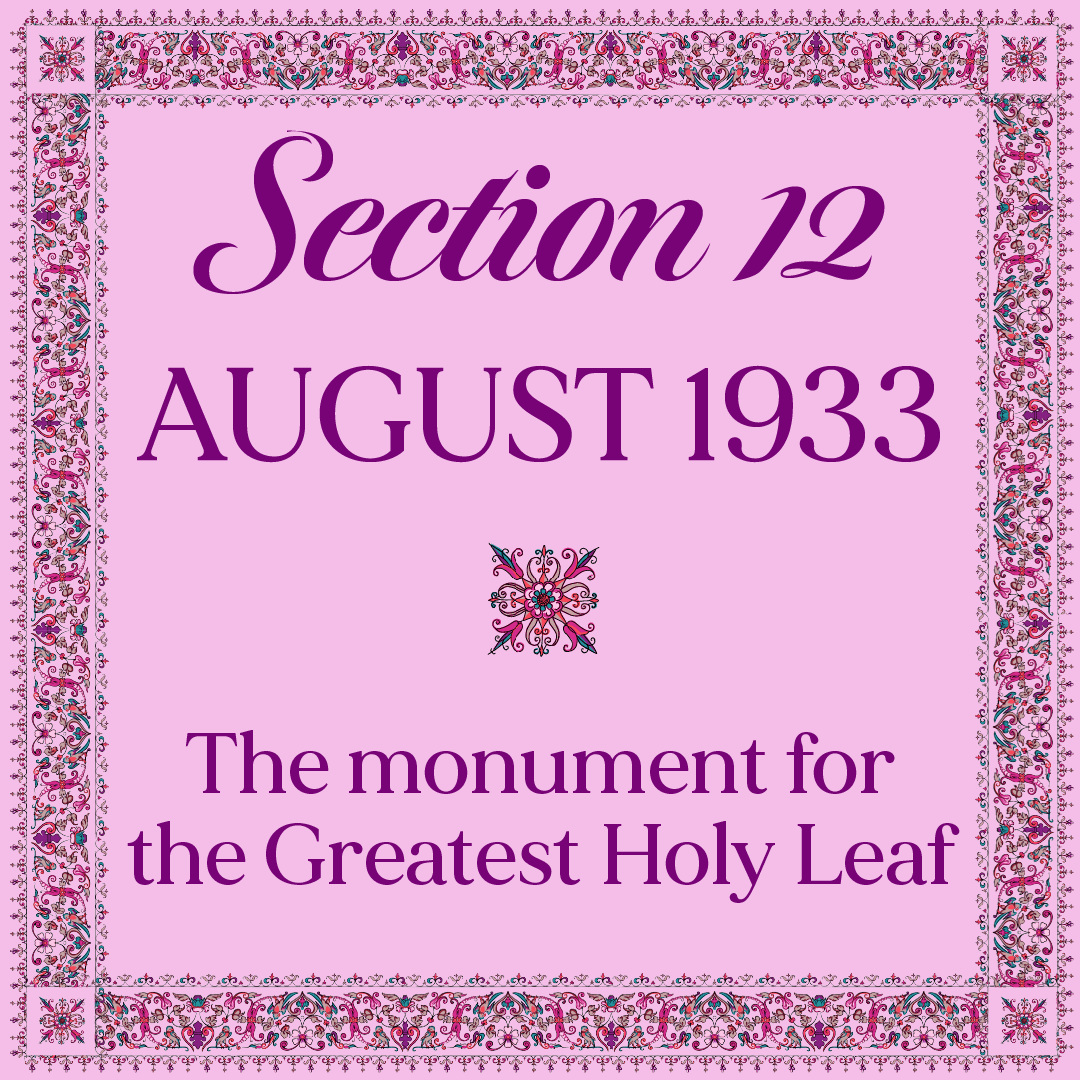

The resting place of the Greatest Holy Leaf, (Bahiyyih Khánum), the daughter of Bahá’u’lláh, in the Monument Gardens, in the 1930s, shortly after it was completed. Source: Bahá'í Media Bank, © Bahá'í International Community 2024.
Shoghi Effendi specifically chose the resting place of the Greatest Holy Leaf to be the center around which the Arc of the future international buildings of the Bahá'í Administrative Order would be built.
That choice determined the shape, disposition, arrangement, size, orientation, and location of the Bahá'í World Centre and the seat of the Universal House of Justice at its very front and center, facing the monument of the Greatest Holy Leaf.
Bahíyyih Khánum was the Outstanding Heroine of the Bahá'í Dispensation, and her rank and her station both merited a meaningful location for her final resting place.
The remainder of the members of the Holy Family would be interred near her—'Abdu'l-Bahá’s mother, brother Mírzá Mihdí, and wife Munírih Khánum, as their station was also above that of every other Bahá'í.
Bahíyyih Khánum’s burial spot was very close to the Shrines of the Báb and 'Abdu'l-Bahá, her Brother, and therefore on sacred land.
In addition, what also makes the resting place of the Greatest Holy Leaf so special is that her father Bahá'u'lláh had graced Mount Carmel with His presence several times, and consecrated the land with His blessed footsteps.
Bahá'u'lláh had revealed the Tablet of Carmel in 1891 at the top of the mountain. Shoghi Effendi called this Tablet the charter for the development of the Bahá'í World Centre, and it prophesied the seat of the Universal House of Justice with the words “Ere long will God sail His Ark upon thee.”
Shoghi Effendi wanted to pinpoint the exact place to bury the Greatest Holy Leaf so that future generations would know to build the “Ark”— the Seat of the Universal House of Justice—directly across from it, on a pathway shaped like an arc.
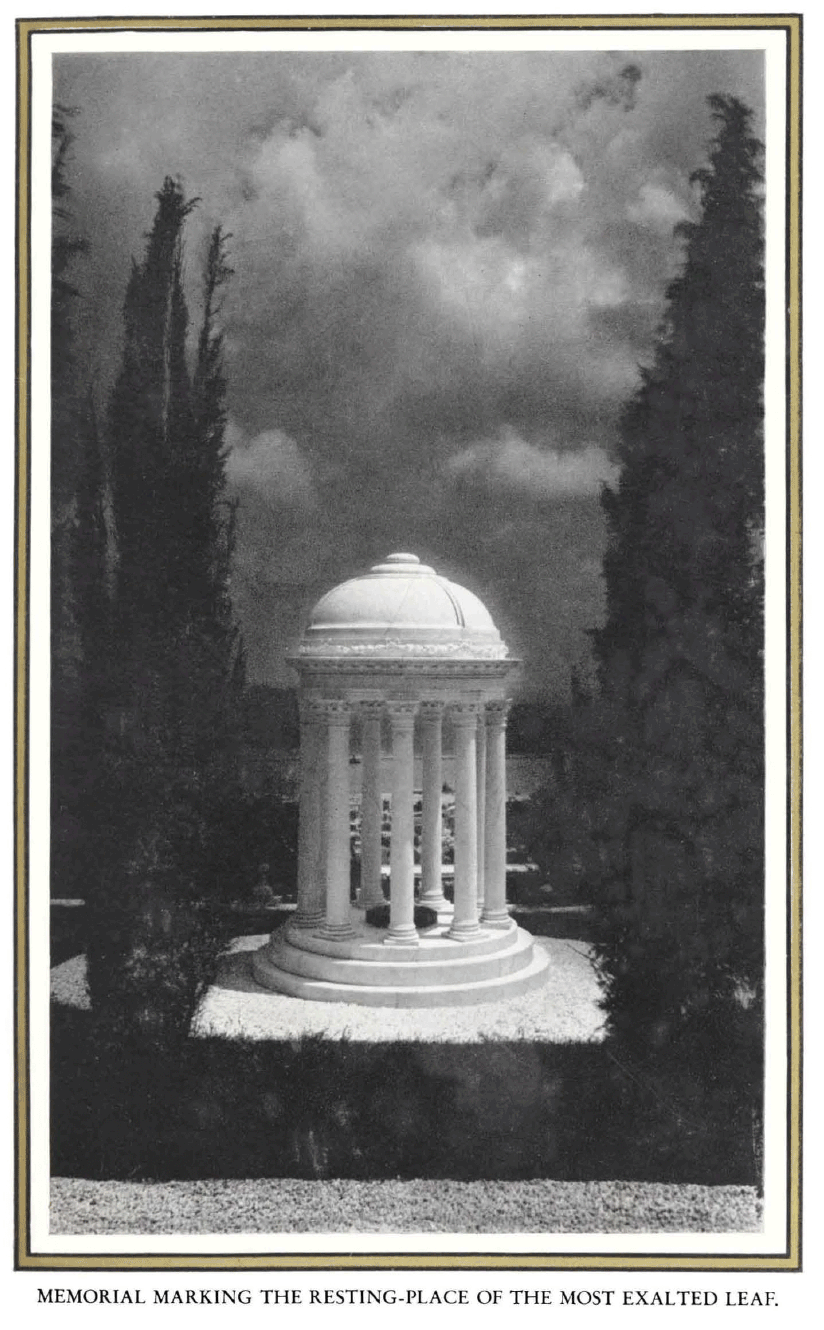
Frontispiece of The Bahá'í World Volume 5 (1930-1932): Photograph by Shoghi Effendi marking the memorial marking the resting-place of the Most Exalted Leaf.
Shoghi Effendi shared the significance of the location of the Greatest Holy Leaf’s resting place with the Bahá'ís of the world in God Passes By:
…a further testimony to the majestic unfoldment and progressive consolidation of the stupendous undertaking launched by Bahá’u’lláh on that holy mountain, may be mentioned the selection of a portion of the school property situated in the precincts of the Shrine of the Báb as a permanent resting-place for the Greatest Holy Leaf…
The Guardian explained the power of the gardens where 'Abdu'l-Bahá’s entire immediate would eventually be laid to rest and said:
“The conjunction of the resting-place of the Greatest Holy Leaf with those of her brother and mother incalculably reinforces the spiritual potencies of that consecrated Spot [which was] destined to evolve into the focal centre of those world-shaking, world embracing, world-directing Administrative institutions, ordained by Bahá’u’lláh.
And around this monument, the international institutions of the Bahá'í Faith would one day be built.
Of course, the immediate next step for the Guardian was to plan, design, and build the beautiful monument over the Greatest Holy Leaf’s resting-place, and he immediately set about doing just that.

Resting Place of the Greatest Holy Leaf, (Bahíyyih Khánum), the daughter of Bahá’u’lláh, in the Monument Gardens. Source: Bahá'í Media Bank, © Bahá'í International Community 2024.
By August 1933, the Guardian had completed the Greatest Holy Leaf’s monument on Mount Carmel, the first memorial in the Monument Gardens, destined become the heart of the Bahá'í World Centre’s Administrative buildings built around them in an arc.
Rúḥíyyih Khánum described the Monument for the Greatest Holy Leaf as a “love temple, the embodiment of Shoghi Effendi’s love” for Bahíyyih Khánum.
The monument, which Shoghi Effendi had commissioned in person in Italy immediately after learning of the Greatest Holy Leaf’s passing, was built of shining white Carrara marble.
Carrara marble has long been considered the best marble in the world. It has been quarried since Roman times in the mountains outside the city of Carrara, in Tuscany, in the north of Italy. More marble has been quarried around Carrara than from any other place on earth. The pure white statuario marble is the best marble that exists on earth.
Shoghi Effendi’s design inspiration for the columned Monument for Bahíyyih Khánum undoubtedly finds its roots in Antiquity, but he reinterpreted a classical feature—columns surmounted by a dome—into a meaningful spiritual homage to the Bahá'í Administrative Order.
The monument was composed of three distinct parts: three circular steps leading to a base, pillars resting around the perimeter of the base, and a round dome crowning the monument.
The Guardian would always compare the Administrative Order to the Greatest Holy Leaf’s monument: the first step was the election of delegates to National Convention, the second step was the election of the National Spiritual Assemblies, the third step was the election of the Universal House of Justice by the National Spiritual Assemblies. The pillars symbolized National Spiritual Assemblies, and the dome symbolized the Universal House of Justice.
No element of the monument—or the Administrative Order, for that matter—could be firmly established if the previous level of wasn’t firmly in place. No dome without pillars, no pillars without base.

Carved and gilded verse regarding the station of Bahíyyih Khánum from a Tablet revealed by Bahá'u'lláh in her honour. This inscription is above the monument designed by Shoghi Effendi for her resting place in the Monument Gardens. Source: Bahá'í Media Bank, © Bahá'í International Community 2023.
Around the base of the elegant circular dome is one of Bahá'u'lláh’s most exquisite tributes to the Greatest Holy Leaf, His peerless, illustrious daughter, is inscribed in gold in the original Arabic. The English translation of the Tablet reads:
This is My testimony for her who hath heard My voice and drawn nigh unto Me. Verily, she is a leaf that hath sprung from this preexistent Root. She hath revealed herself in My name and tasted of the sweet savours of My holy, My wondrous pleasure. At one time We gave her to drink from My honeyed Mouth, at another caused her to partake of My mighty, My luminous Kawthar. Upon her rest the glory of My name and the fragrance of My shining robe.
Once the Greatest Holy Leaf’s monument was completed, Shoghi Effendi had a beautiful photograph sent to many different National Spiritual Assemblies. The National Spiritual Assembly of the United States and Canada published the photo the Guardian sent them in Issue 76 of Bahá'í News in August 1933).
Shoghi Effendi also sent the beautiful photograph to a special list of individuals to whom he wanted to present this tender and touching souvenir.
One of the most touching aspects of Shoghi Effendi’s attention to detail with regards to the monument of the Greatest Holy Leaf was a phone call he placed to the engineer, asking him to make sure that when the head pillar was put in place that it face in the direction of the Shrine of Bahá'u'lláh and not the city of 'Akká.
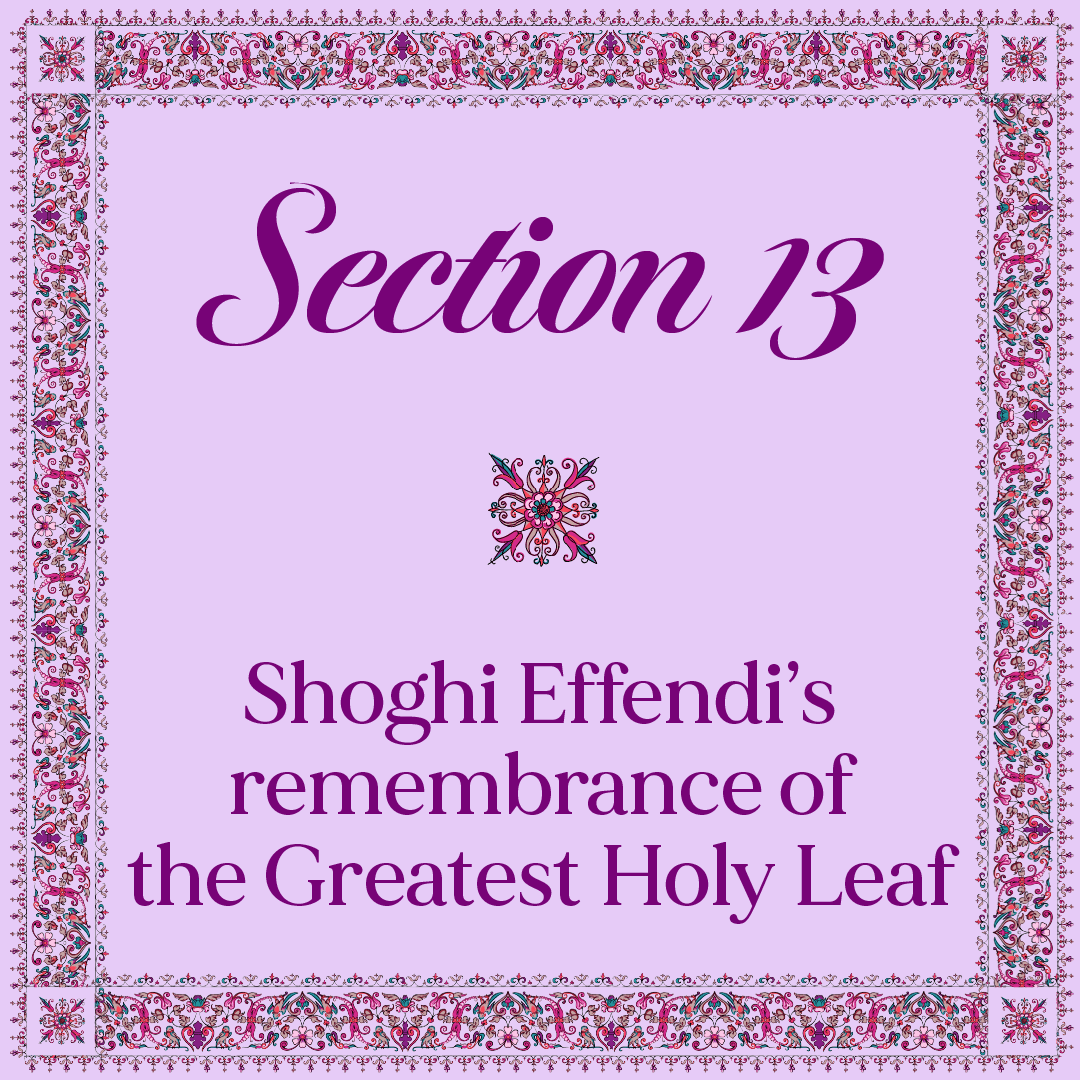
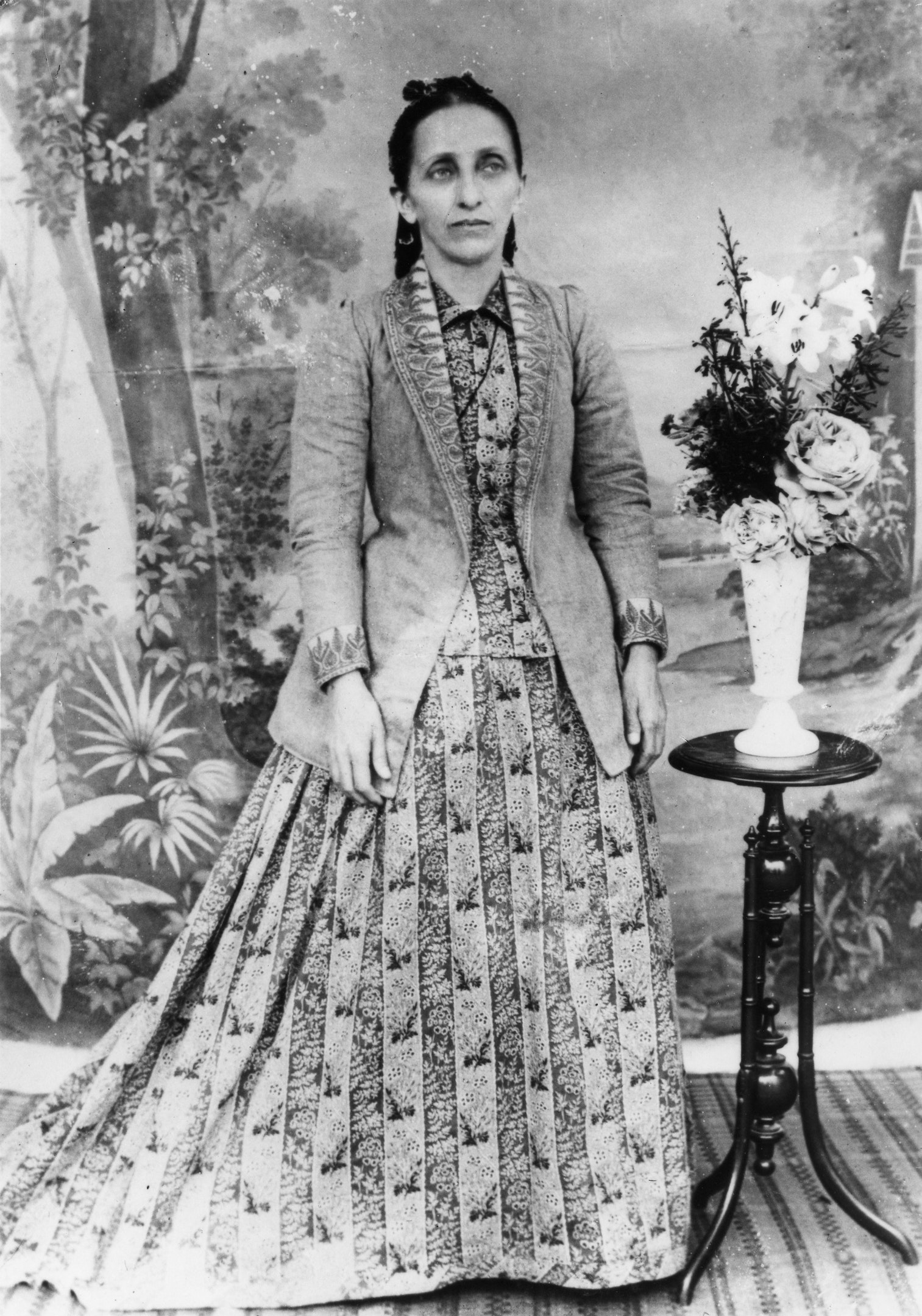
Photograph of Bahíyyih Khánum in 1895 at the age of 49. Source: Bahá'í Media Bank, © Bahá'í International Community 2024.
For a long period of time after the Greatest Holy Leaf’s passing, but more intensely in the days immediately following, Shoghi Effendi made a tremendous effort to guide the worldwide Bahá'í community in understanding her unparalleled station in Bahá'í history.
She was, as the Guardian explicitly stated, “the outstanding heroine of the Bahá’í Dispensation.”
The Guardian emphasized her station by sharing with Bahá'ís everywhere excerpts and copies of Tablets from Bahá'u'lláh and 'Abdu'l-Bahá which They had revealed in her honor.
It is safe to state that apart from Bahá'u'lláh, 'Abdu'l-Bahá, and the Guardian, no Bahá'í could ever fully comprehend the exalted and saintly station of Bahíyyih Khánum, but Shoghi Effendi did his utmost, by sharing these excerpts to shed light—to the extent that Bahá'ís could even fathom it—on Bahíyyih Khánum’s role in the Faith.
The Greatest Holy Leaf had a mystic bond with the Spirit of Bahá'u'lláh, she was the daughter of the supreme Manifestation of God, prophesied by all former prophets. That bond would be incomprehensible to mere mortals.
Bahíyyih Khánum was also deeply bonded to 'Abdu'l-Bahá, her older Brother, the appointed successor of Bahá'u'lláh, the Center of the Covenant, the Perfect Exemplar, the Master.
It was important for Shoghi Effendi to communicate these excerpts so that Bahá'ís could understand the mysteries and secrets contained in the Holy Writings about the Greatest Holy Leaf. She had been so self-effacing during her life that many Bahá'ís simply had no concept of her as an active player in the history of the Faith, no less its outstanding heroine.
Shoghi Effendi worked tirelessly to right this wrong, and to continue, beyond the Greatest Holy Leaf’s passion, to instill inspiration, hope, joy, comfort through words written about her glorious station, and he intended that the writings he shared would be recited and used during the memorial gatherings in his honor. In Shoghi Effendi’s words, this was his intent:
[these verses] should be repeatedly recited, most movingly with devotion and lowliness, and great attention and care, so as to perpetuate her blessed memory, and extol her station, and out of love also for her incomparable beauty.
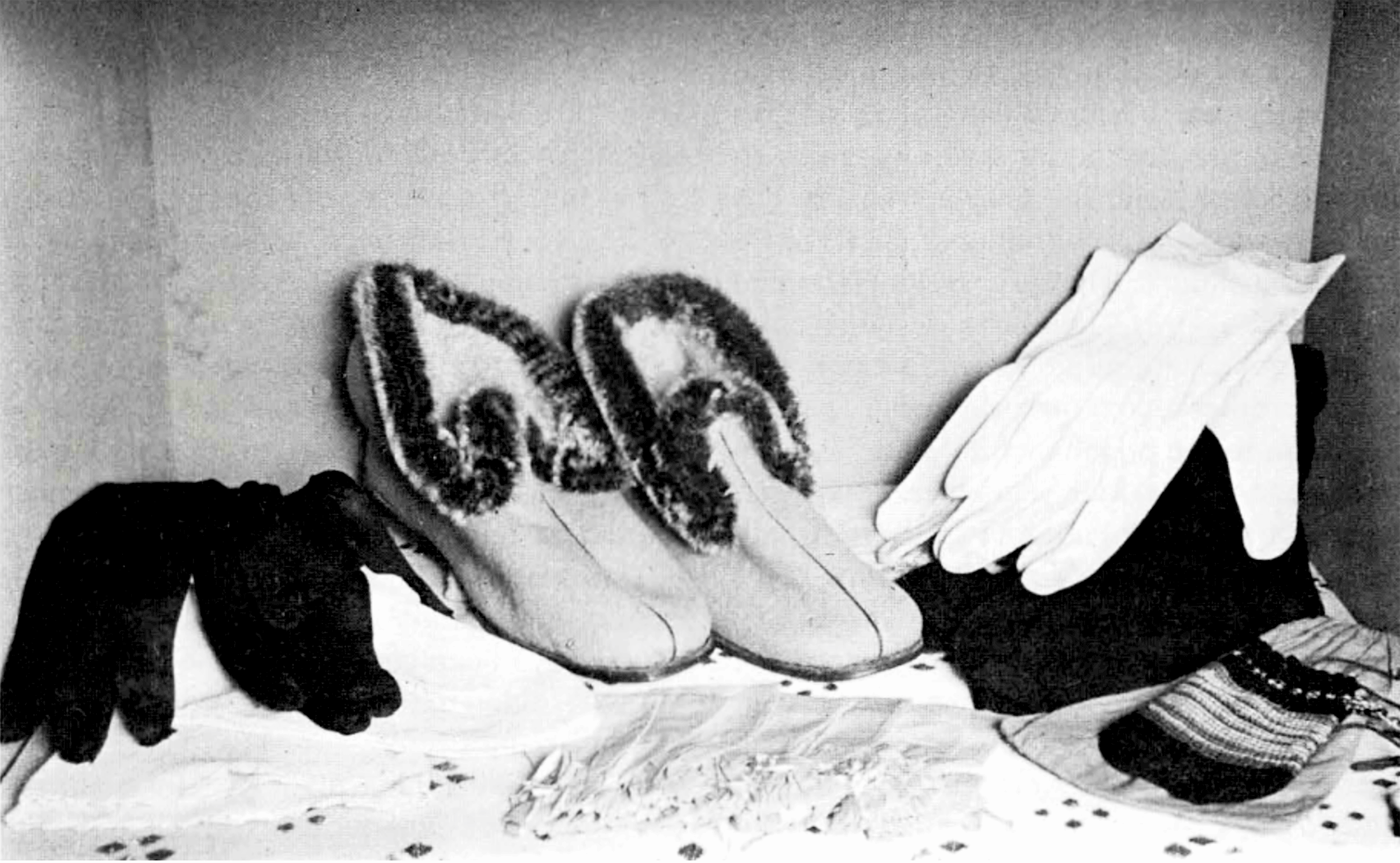
Some relics of items having belonged to the Greatest Holy Leaf and preserved in the International Bahá'í Archives. Originally published in The Bahá'í World Volume 18 page 52. Source: Bahaimedia.
In 1937, when they were on pilgrimage, Shoghi Effendi told May and Mary Maxwell that Greatest Holy Leaf was not, in fact, the most accurate translation for the title Bahá'u'lláh bestowed on His saintly daughter. He told them that the correct rendition of the Arabic “Varaqiy-i-‘ulyá” was “The Most Exalted Leaf," and that the word “Holy” was not present in the Arabic.
Once the Greatest Holy Leaf had passed away, Shoghi Effendi kept mementos of her, surrounding his life with her presence.
He moved the armchair that he used to sit in when he visited his great-aunt his room and continued to use it until the end of his life.
He filled his bedroom with photographs of her from her youth to her old age, as well as beautiful photos of her Monument.
Her memory to him, became "ennobling influence...amid the wreckage of a sadly shaken world." She was his refuge in death as she had been in life.
He decorated the International Bahá'í Archives with illuminated Tablets revealed by Bahá'u'lláh in her honor, also including photographs of her and her Monument, as well as relics from her life and other mementos.
Every single great achievement he accomplished in the rest of his Guardianship, he associated with her.
In 1939, when he re-interred the remains of Ásíyih Khánum and Mírzá Mihdí, her mother and martyred young brother on Mount Carmel, very close to her resting place, he thought of her, cabling “cherished wish Greatest Holy Leaf fulfilled.”
Shoghi Effendi never forgot that the Greatest Holy Leaf had often said during her lifetime that she wanted to be buried near her beloved mother and brother.
He marked this momentous occasion by pledging £1,000 as his contribution to the Bahíyyih Khánum Fund, the last fund drive connected with the completion of the interior ornamentation of the Mother Temple of North America.

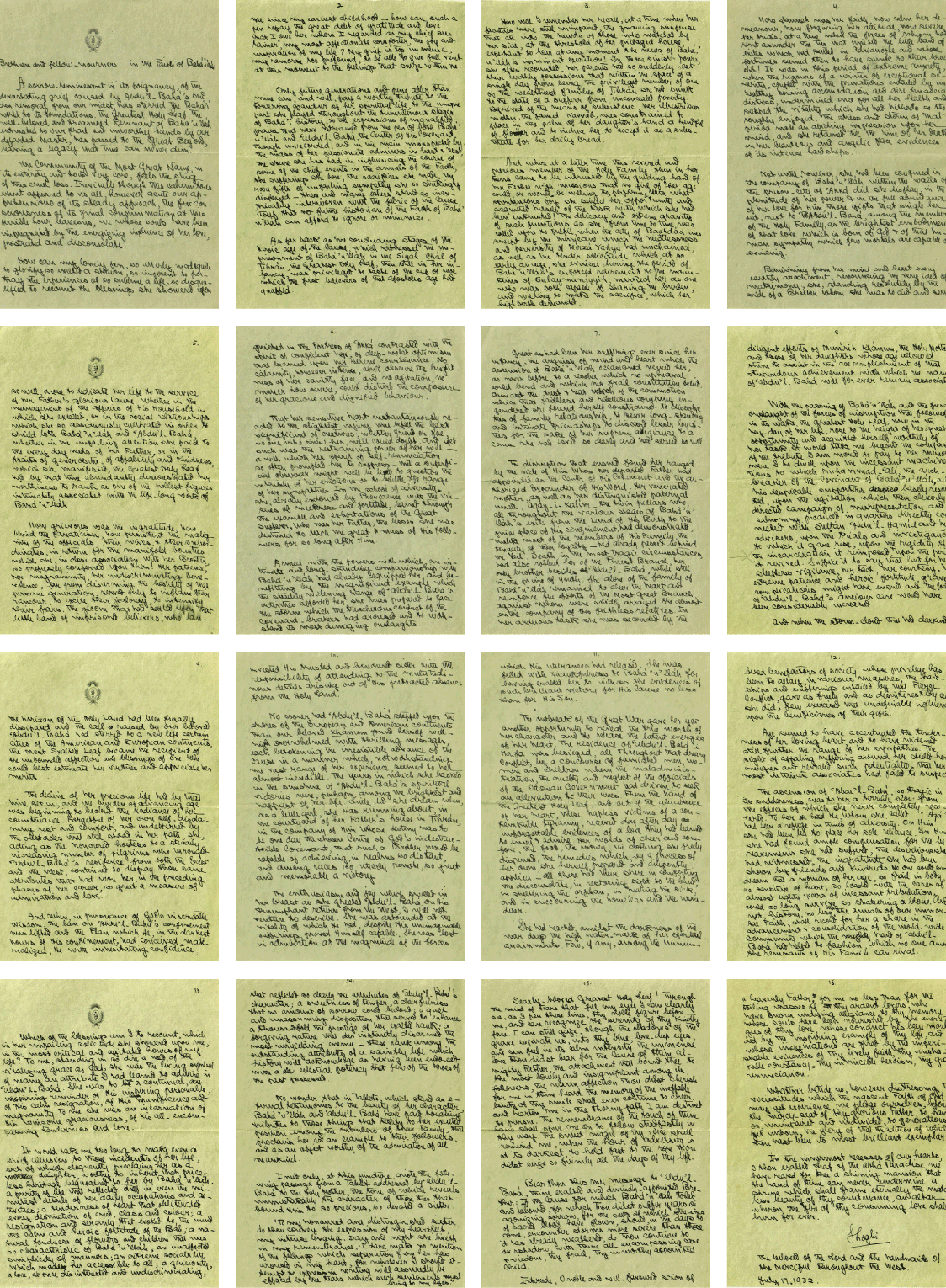
The original 16 handwritten pages of Shoghi Effendi’s eulogy to the Greatest Holy Leaf dated 17 July 1932. Source: Bahá'í Library Online.
To conclude this chronology of the awe-inspiring life of the Greatest Holy Leaf, daughter of a Manifestation of God, sister of the Center of the Covenant, great-aunt of the Guardian of the Cause of Bahá'u'lláh, we go back in time to two days after her passing.
Shoghi Effendi was painfully aware of male historians’ tendency to leave out women in their narratives. He ensured this would never happen to Bahíyyih Khánum when he penned an extraordinary 16-page, 37-paragraph, 3,645-word eulogy for the Greatest Holy Leaf in Switzerland, two days after her passing on 17 July 1932, as he was preparing to travel to Italy to order the monument for the Greatest Holy Leaf’s resting place.
The Guardian’s eulogy for the Greatest Holy Leaf provides a glimpse of what was passing in the surging sea of his heart and in which he eulogizes the life, station and deeds of ‘Abdu’l-Bahá sister, pouring forth his love in an unforgettable torrent of words.
This letter is vastly important.
For one, it is a 17-page letter from the Guardian written in his own hand about the station of the of the Greatest Holy Leaf.
But another reason it is a very unique letter among the 36,000 cables and letters the Guardian wrote and sent during his lifetime is that it is one of only five letters that the Guardian sent simultaneously in English to the Bahá'ís of the West and in Persian to the Bahá'ís of the East.
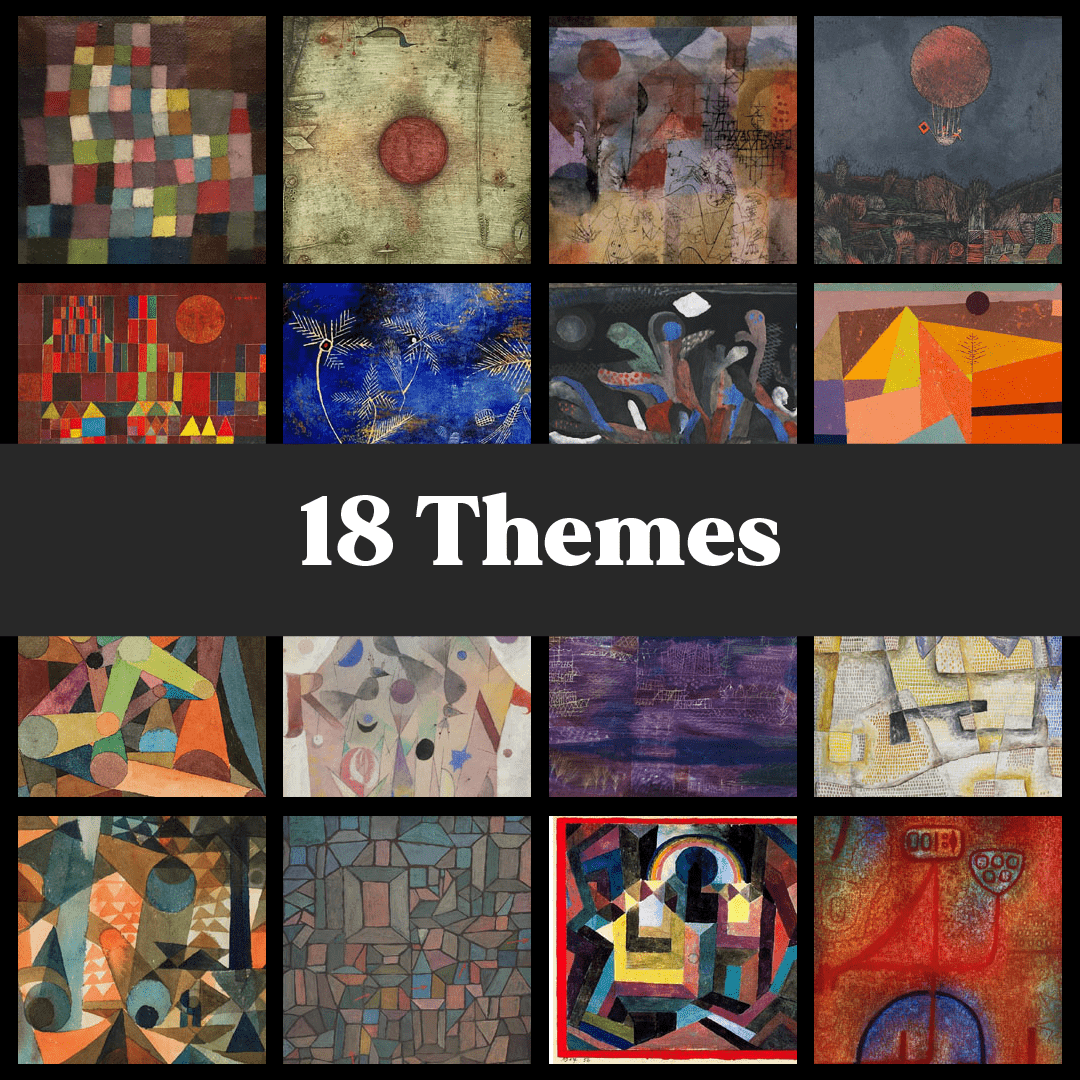
Background image composed of 16 of the paintings by Paul Klee used below.
In this eulogy, Shoghi Effendi addresses the following themes: the devastating grief and sorrow and grief of the Guardian and the Bahá'í community, Bahíyyih Khánum’s station in Bahá'í history and the story of her life and sufferings from Persia, to Iraq, Turkey, and the Holy Land, Her self-sacrificing nature and her noble spiritual qualities, Her role during the ministry of 'Abdu'l-Bahá—particularly during His Journeys to the West and during World War I—Her role immediately after the Ascension of 'Abdu'l-Bahá and the Tablets Bahá'u'lláh and 'Abdu'l-Bahá revealed regarding her station and character, a one-paragraph quote from a Tablet revealed by 'Abdu'l-Bahá to Munírih Khánum addressing the Greatest Holy Leaf as “my honored and distinguished sister.”
The last five paragraphs are written in traditional Persian fashion, where Shoghi Effendi addresses himself in the language of prayer to the Greatest Holy Leaf, gazing through tears at her blue, love-deep eyes, remembering her, cherishing her, asking her to convey a message to 'Abdu'l-Bahá, and begging prayers for the Guardian of the Faith of Bahá'u'lláh, and for the Bahá'ís. This poem-eulogy ends with a promise to the Greatest Holy Leaf that the Bahá'ís built in the innermost recesses of their heart a shining mansion untouched by the hand of time, an altar where the fire of her consuming love will burn forever.
What follows is the Guardian’s full eulogy for the Greatest Holy Leaf, completely unabridged. For those of you listening and not looking at a screen, you will miss the themes of the letter as they progress. They will be graphic cards indicating the theme, but I will not read them aloud to not interrupt the flow of Shoghi Effendi’s words.
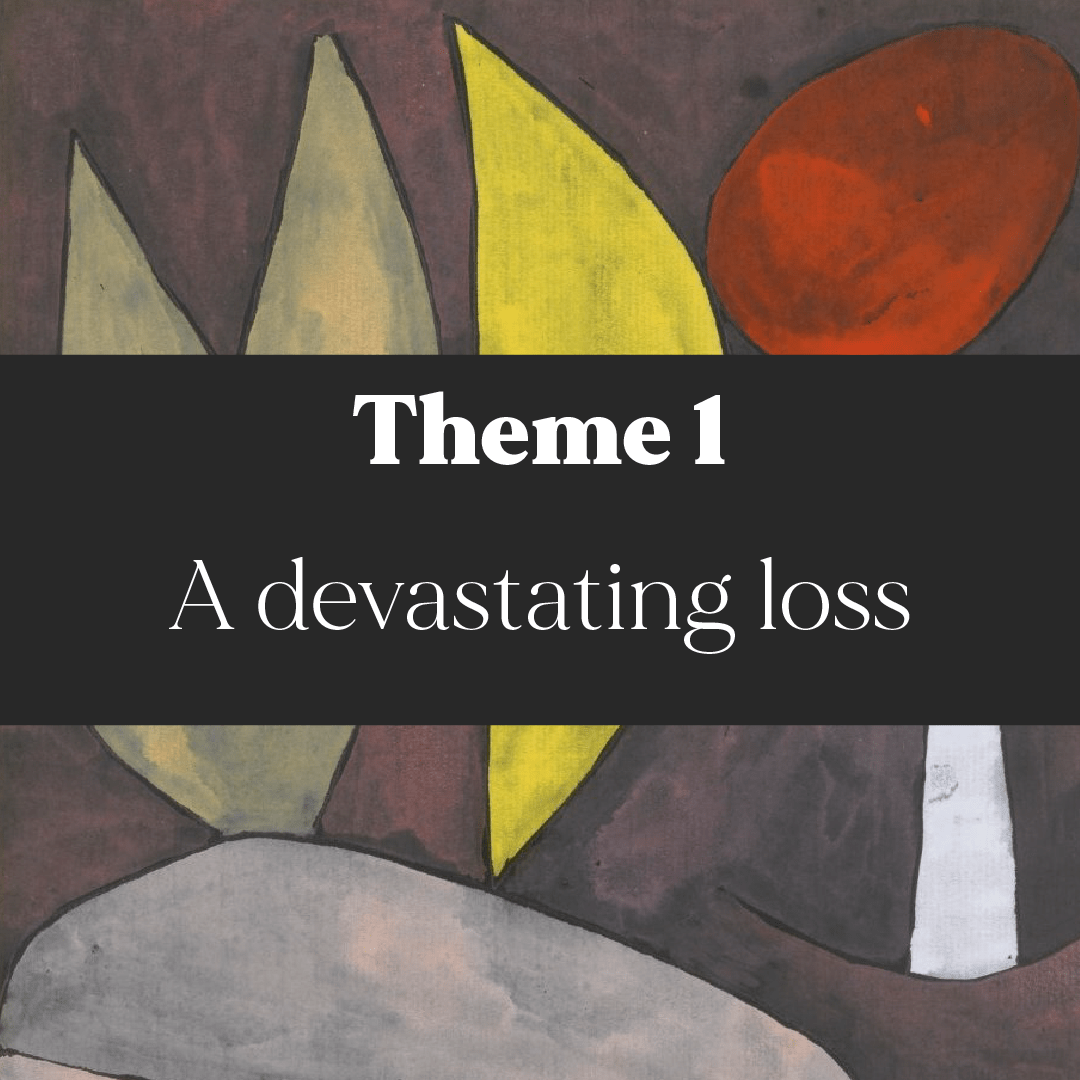
Background painting by Paul Klee: In Position (1939). Source: Wikimedia Commons.
The beloved of God and the handmaids of the Merciful throughout the United States and Canada.
Brethren and fellow-mourners in the Faith of Bahá’u’lláh:
A sorrow, reminiscent in its poignancy, of the devastating grief caused by ‘Abdu’l‑Bahá’s sudden removal from our midst, has stirred the Bahá’í world to its foundations. The Greatest Holy Leaf, the well-beloved and treasured Remnant of Bahá’u’lláh entrusted to our frail and unworthy hands by our departed Master, has passed to the Great Beyond, leaving a legacy that time can never dim.
The community of the Most Great Name, in its entirety and to its very core, feels the sting of this cruel loss. Inevitable though this calamitous event appeared to us all, however acute our apprehensions of its steady approach, the consciousness of its final consummation at this terrible hour leaves us, we whose souls have been impregnated by the energizing influence of her love, prostrated and disconsolate.
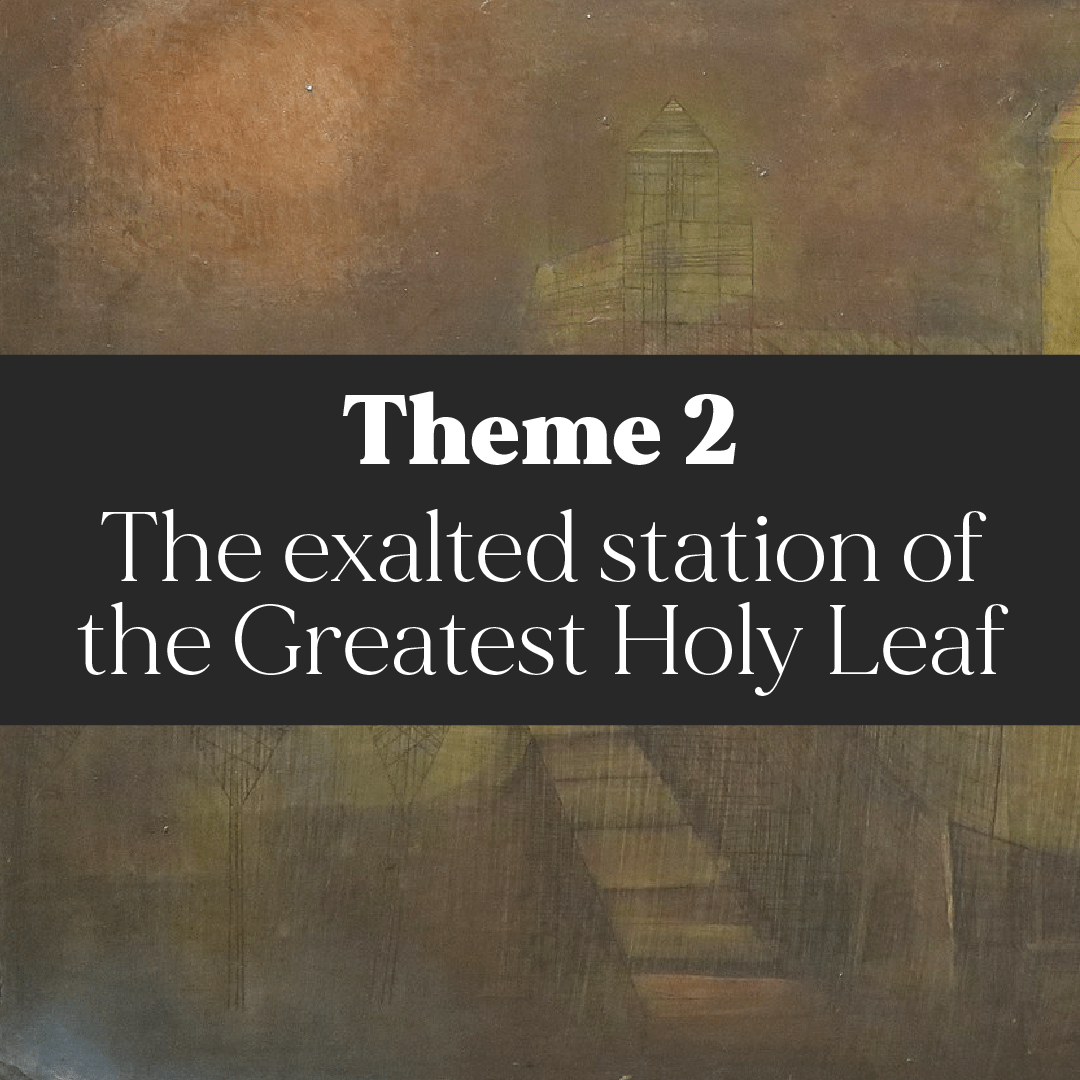
Background painting by Paul Klee: Small Village in the Autumn Sun (1925). Source: Wikimedia Commons.
How can my lonely pen, so utterly inadequate to glorify so exalted a station, so impotent to portray the experiences of so sublime a life, so disqualified to recount the blessings she showered upon me since my earliest childhood—how can such a pen repay the great debt of gratitude and love that I owe her whom I regarded as my chief sustainer, my most affectionate comforter, the joy and inspiration of my life? My grief is too immense, my remorse too profound, to be able to give full vent at this moment to the feelings that surge within me.
Only future generations and pens abler than mine can, and will, pay a worthy tribute to the towering grandeur of her spiritual life, to the unique part she played throughout the tumultuous stages of Bahá’í history, to the expressions of unqualified praise that have streamed from the pen of both Bahá’u’lláh and ‘Abdu’l‑Bahá, the Center of His covenant, though unrecorded, and in the main unsuspected by the mass of her admirers in East and West, the share she has had in influencing the course of some of the chief events in the annals of the Faith, the sufferings she bore, the sacrifices she made, the rare gifts of unfailing sympathy she so strikingly displayed—these, and many others stand so inextricably interwoven with the fabric of the Cause itself that no future historian of the Faith of Bahá’u’lláh can afford to ignore or minimize.
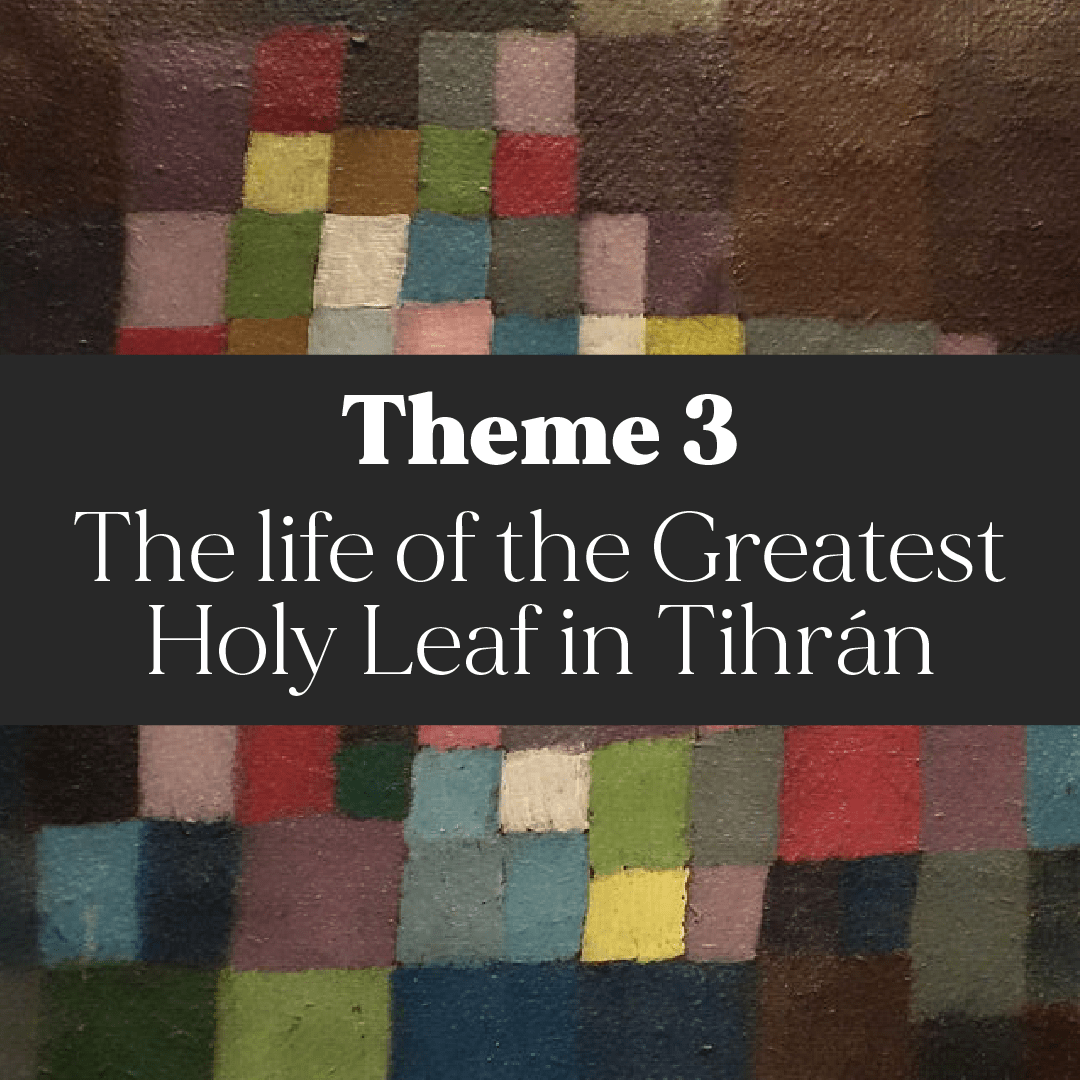
Background painting by Paul Klee: Abstraction with Reference to a Flowering Tree (1925). Source: Wikimedia Commons.
As far back as the concluding stages of the heroic age of the Cause, which witnessed the imprisonment of Bahá’u’lláh in the Síyáh-Chál of Ṭihrán, the Greatest Holy Leaf, then still in her infancy, was privileged to taste of the cup of woe which the first believers of that apostolic age had quaffed.
How well I remember her recall, at a time when her faculties were still unimpaired, the gnawing suspense that ate into the hearts of those who watched by her side, at the threshold of her pillaged house, expectant to hear at any moment the news of Bahá’u’lláh’s imminent execution! In those sinister hours, she often recounted, her parents had so suddenly lost their earthly possessions that within the space of a single day from being the privileged member of one of the wealthiest families of Ṭihrán she had sunk to the state of a sufferer from unconcealed poverty. Deprived of the means of subsistence, her illustrious mother, the famed Navváb, was constrained to place in the palm of her daughter’s hand a handful of flour and to induce her to accept it as a substitute for her daily bread.
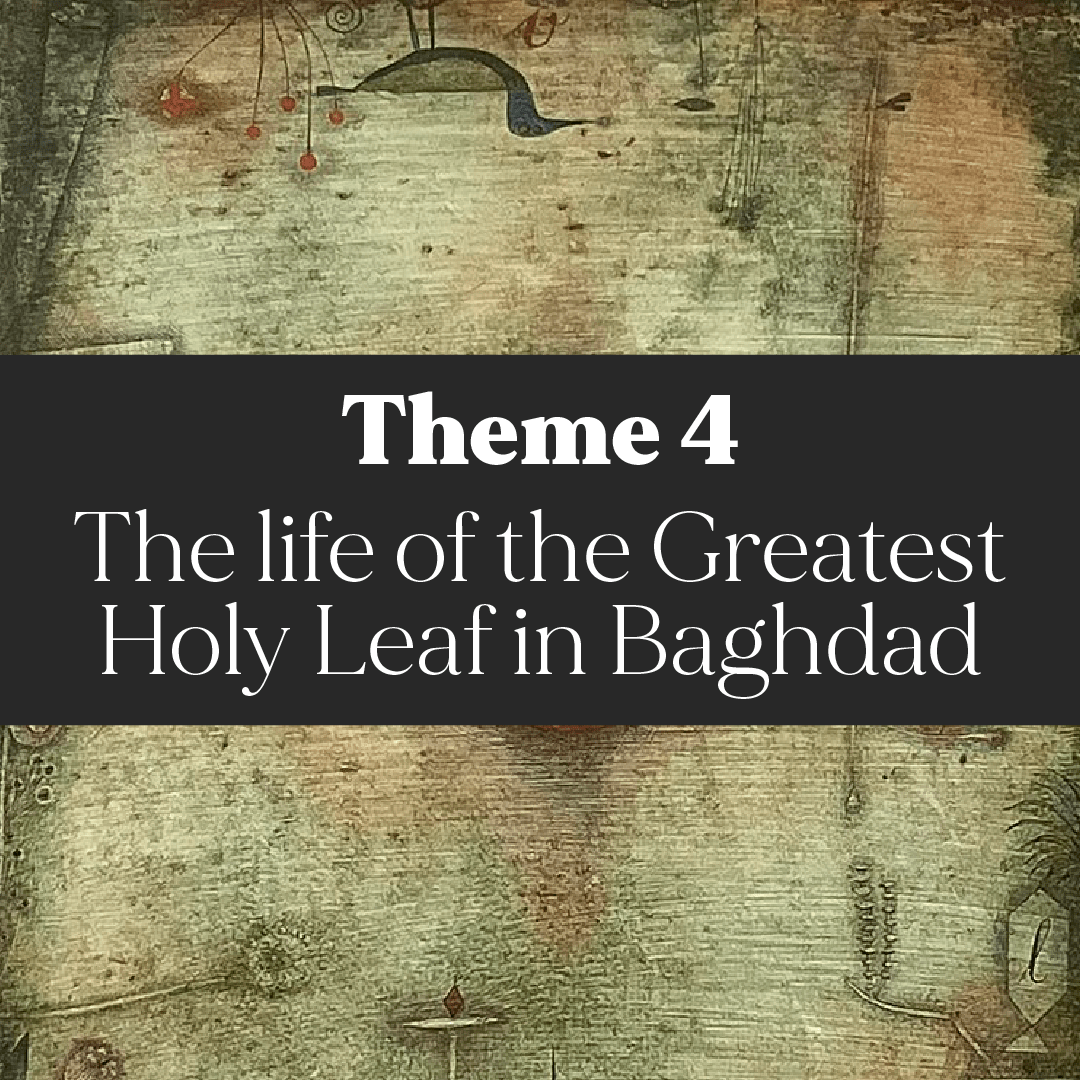
Background painting by Paul Klee: Ad Marginem (1930). Source: Wikimedia Commons.
And when at a later time this revered and precious member of the Holy Family, then in her teens, came to be entrusted by the guiding hand of her Father with missions that no girl of her age could, or would be willing to, perform, with what spontaneous joy she seized her opportunity and acquitted herself of the task with which she had been entrusted! The delicacy and extreme gravity of such functions as she, from time to time, was called upon to fulfill, when the city of Bagdad was swept by the hurricane which the heedlessness and perversity of Mírzá Yaḥyá had unchained, as well as the tender solicitude which, at so early an age, she evinced during the period of Bahá’u’lláh’s enforced retirement to the mountains of Sulaymáníyyih, marked her as one who was both capable of sharing the burden, and willing to make the sacrifice, which her high birth demanded.
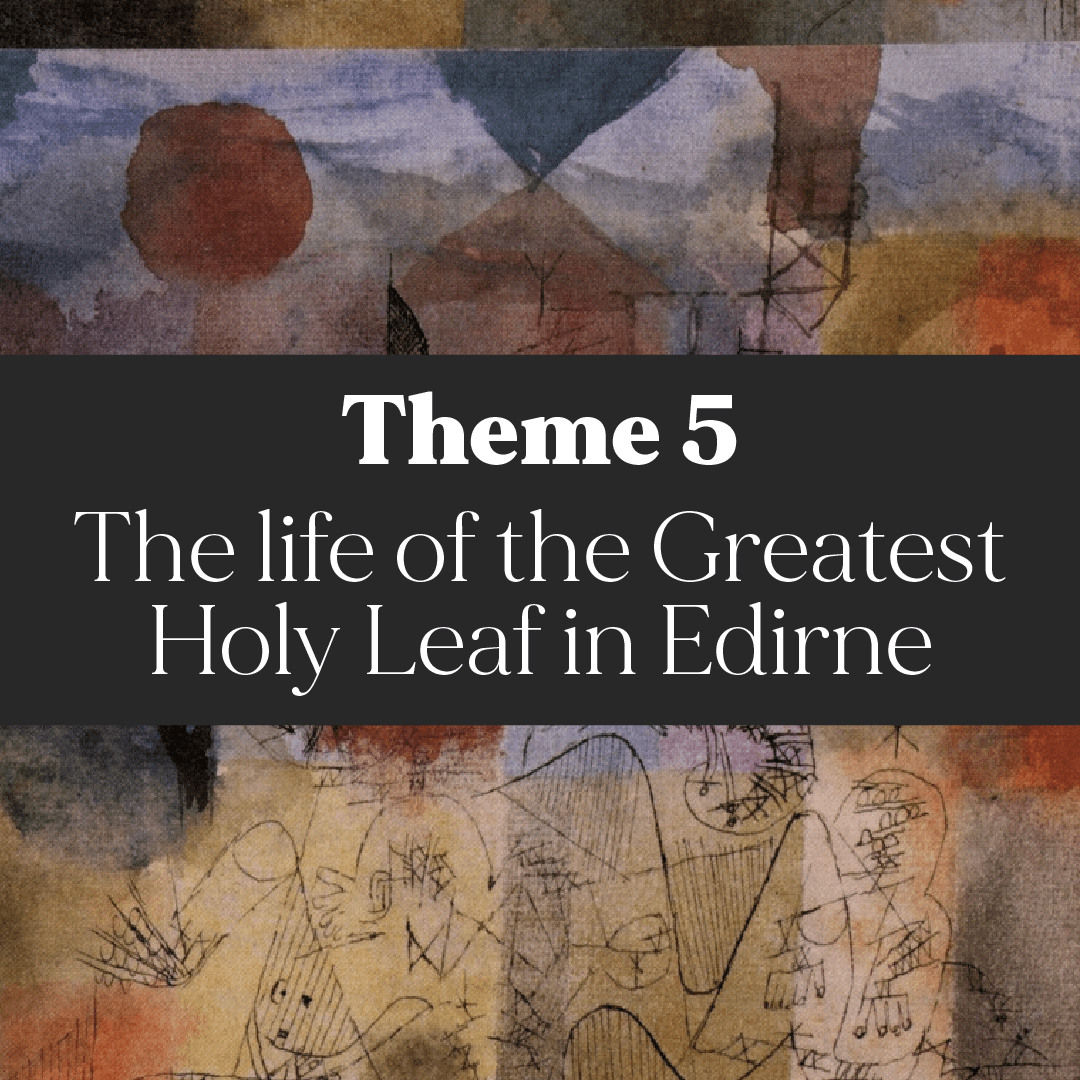
Background painting by Paul Klee: By the waters of Babel (1918). Source: Wikimedia Commons.
How staunch was her faith, how calm her demeanor, how forgiving her attitude, how severe her trials, at a time when the forces of schism had rent asunder the ties that united the little band of exiles which had settled in Adrianople and whose fortunes seemed then to have sunk to their lowest ebb! It was in this period of extreme anxiety, when the rigors of a winter of exceptional severity, coupled with the privations entailed by unhealthy housing accommodations and dire financial distress, undermined once for all her health and sapped the vitality which she had hitherto so thoroughly enjoyed. The stress and storm of that period made an abiding impression upon her mind, and she retained till the time of her death on her beauteous and angelic face evidences of its intense hardships.
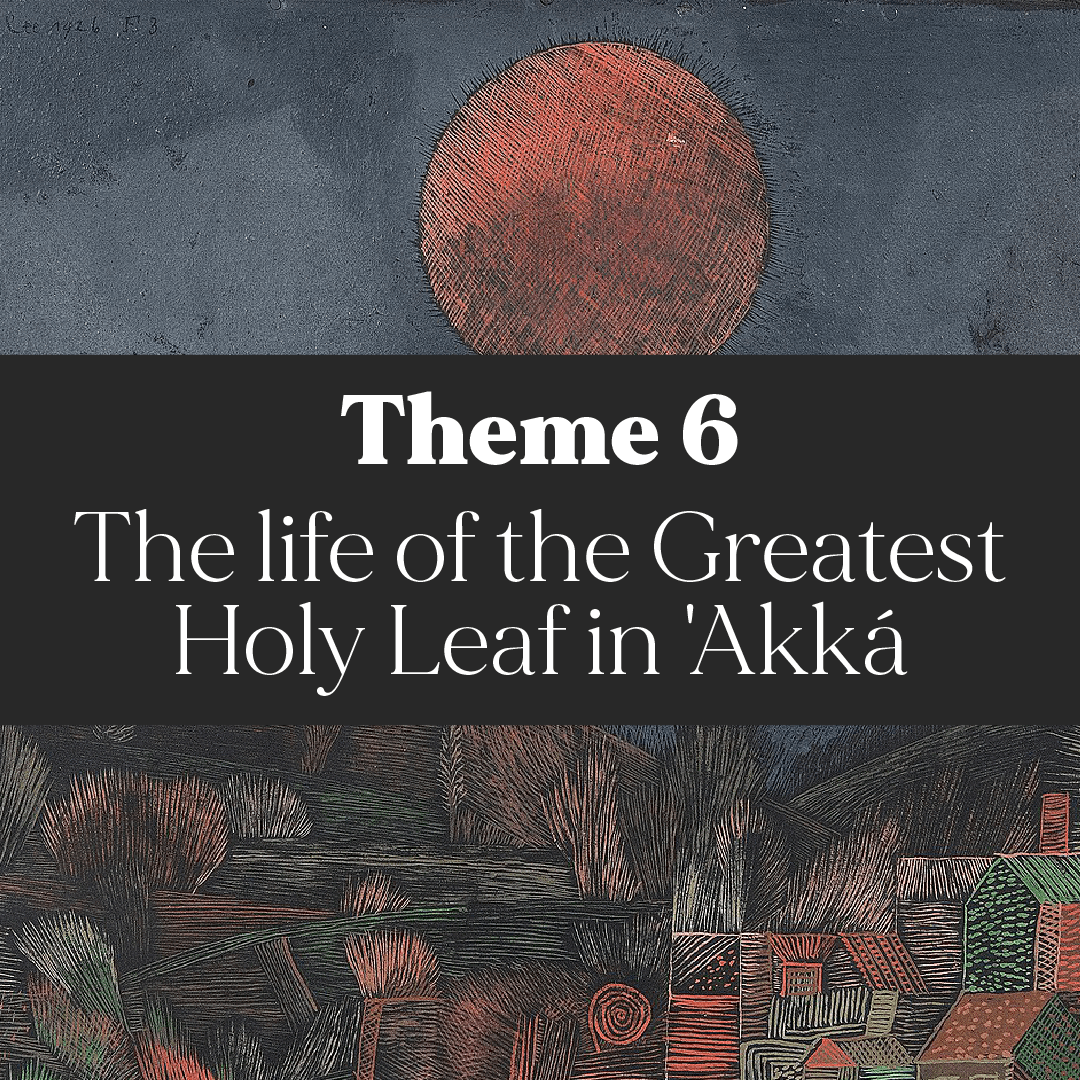
Background painting by Paul Klee: The balloon (1926). Source: Wikimedia Commons.
Not until, however, she had been confined in the company of Bahá’u’lláh within the walls of the prison-city of ‘Akká did she display, in the plenitude of her power and in the full abundance of her love for Him, more gifts that single her out, next to ‘Abdu’l‑Bahá, among the members of the Holy Family, as the brightest embodiment of that love which is born of God and of that human sympathy which few mortals are capable of evincing.
Banishing from her mind and heart every earthly attachment, renouncing the very idea of matrimony, she, standing resolutely by the side of a Brother whom she was to aid and serve so well, arose to dedicate her life to the service of her Father’s glorious Cause. Whether in the management of the affairs of His Household in which she excelled, or in the social relationships which she so assiduously cultivated in order to shield both Bahá’u’lláh and ‘Abdu’l‑Bahá, whether in the unfailing attention she paid to the everyday needs of her Father, or in the traits of generosity, of affability and kindness, which she manifested, the Greatest Holy Leaf had by that time abundantly demonstrated her worthiness to rank as one of the noblest figures intimately associated with the life-long work of Bahá’u’lláh.
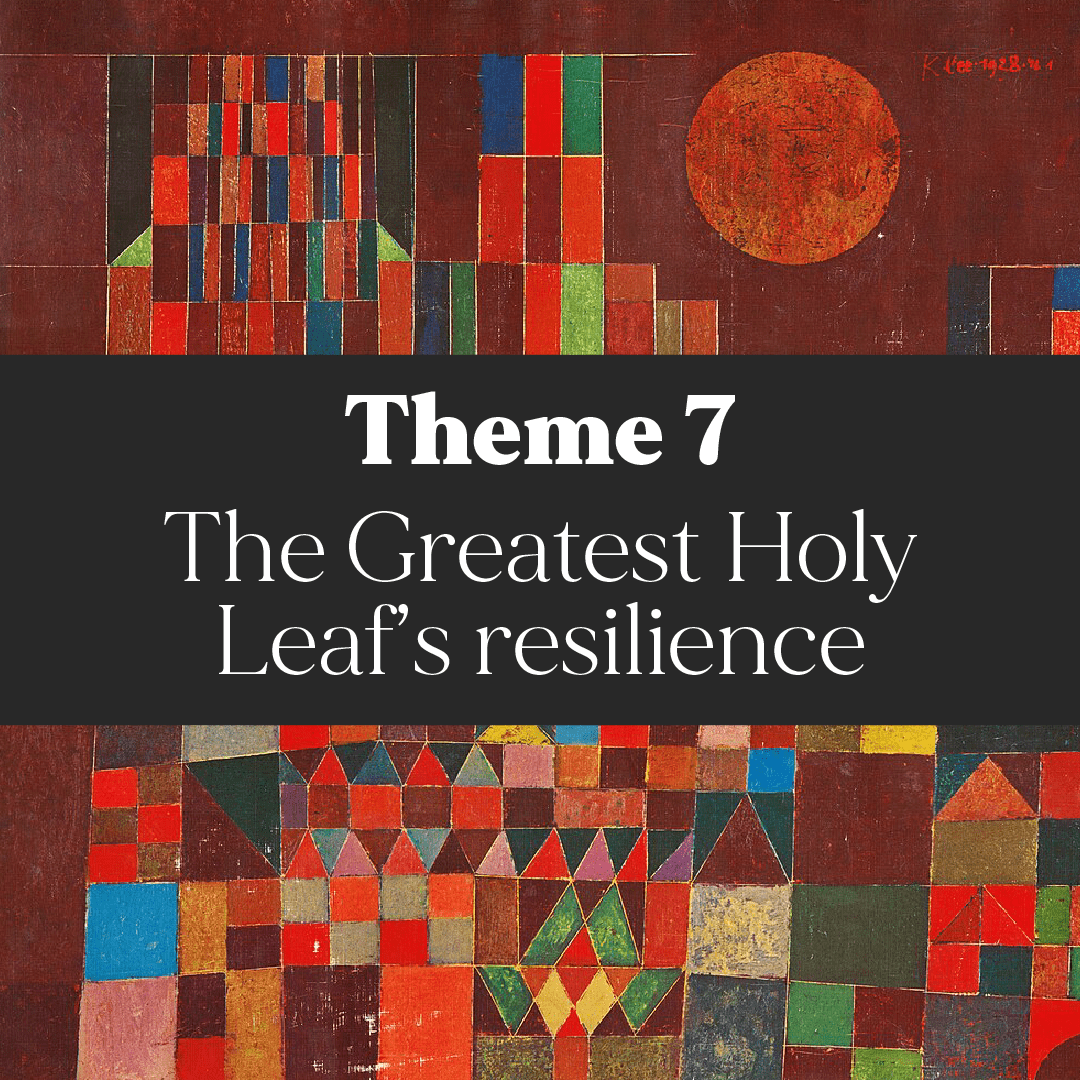
Background painting by Paul Klee: Castle and sun (1928). Source: Wikimedia Commons.
How grievous was the ingratitude, how blind the fanaticism, how persistent the malignity of the officials, their wives, and their subordinates, in return for the manifold bounties which she, in close association with her Brother, so profusely conferred upon them! Her patience, her magnanimity, her indiscriminating benevolence, far from disarming the hostility of that perverse generation, served only to inflame their rancour, to excite their jealousy, to intensify their fears. The gloom that had settled upon that little band of imprisoned believers, who languished in the Fortress of ‘Akká, contrasted with the spirit of confident hope, of deep-rooted optimism that beamed upon her serene countenance. No calamity, however intense, could obscure the brightness of her saintly face, and no agitation, no matter how severe, could disturb the composure of her gracious and dignified behaviour.
That her sensitive heart instantaneously reacted to the slightest injury that befell the least significant of creatures, whether friend or foe, no one who knew her well could doubt. And yet such was the restraining power of her will—a will which her spirit of self-renunciation so often prompted her to suppress—that a superficial observer might well be led to question the intensity of her emotions or to belittle the range of her sympathies. In the school of adversity she, already endowed by Providence with the virtues of meekness and fortitude, learned through the example and exhortations of the Great Sufferer, who was her Father, the lesson she was destined to teach the great mass of His followers for so long after Him.
Armed with the powers with which an intimate and long-standing companionship with Bahá’u’lláh had already equipped her, and benefiting by the magnificent example which the steadily widening range of ‘Abdu’l‑Bahá’s activities afforded her, she was prepared to face the storm which the treacherous conduct of the Covenant-breakers had aroused and to withstand its most damaging onslaughts.
Background painting by Paul Klee: Fairy Tales (Around 1920). Source: Wikimedia Commons.
Great as had been her sufferings ever since her infancy, the anguish of mind and heart which the Ascension of Bahá’u’lláh occasioned, nerved her, as never before, to a resolve which no upheaval could bend and which her frail constitution belied. Amidst the dust and heat of the commotion which that faithless and rebellious company engendered she found herself constrained to dissolve ties of family relationship, to sever long-standing and intimate friendships, to discard lesser loyalties for the sake of her supreme allegiance to a Cause she had loved so dearly and had served so well.
The disruption that ensued found her ranged by the side of Him Whom her departed Father had appointed as the Center of His Covenant and the authorized Expounder of His Word. Her venerated mother, as well as her distinguished paternal uncle, Áqáy-i-Kalím—the twin pillars who, all throughout the various stages of Bahá’u’lláh’s exile from the Land of His Birth to the final place of His confinement, had demonstrated, unlike most of the members of His Family, the tenacity of their loyalty—had already passed behind the Veil. Death, in the most tragic circumstances, had also robbed her of the Purest Branch, her only brother besides ‘Abdu’l‑Bahá, while still in the prime of youth. She alone of the family of Bahá’u’lláh remained to cheer the heart and reinforce the efforts of the Most Great Branch, against whom were solidly arrayed the almost entire company of His faithless relatives. In her arduous task she was seconded by the diligent efforts of Munírih Khánum, the Holy Mother, and those of her daughters whose age allowed them to assist in the accomplishment of that stupendous achievement with which the name of ‘Abdu’l‑Bahá will forever remain associated.
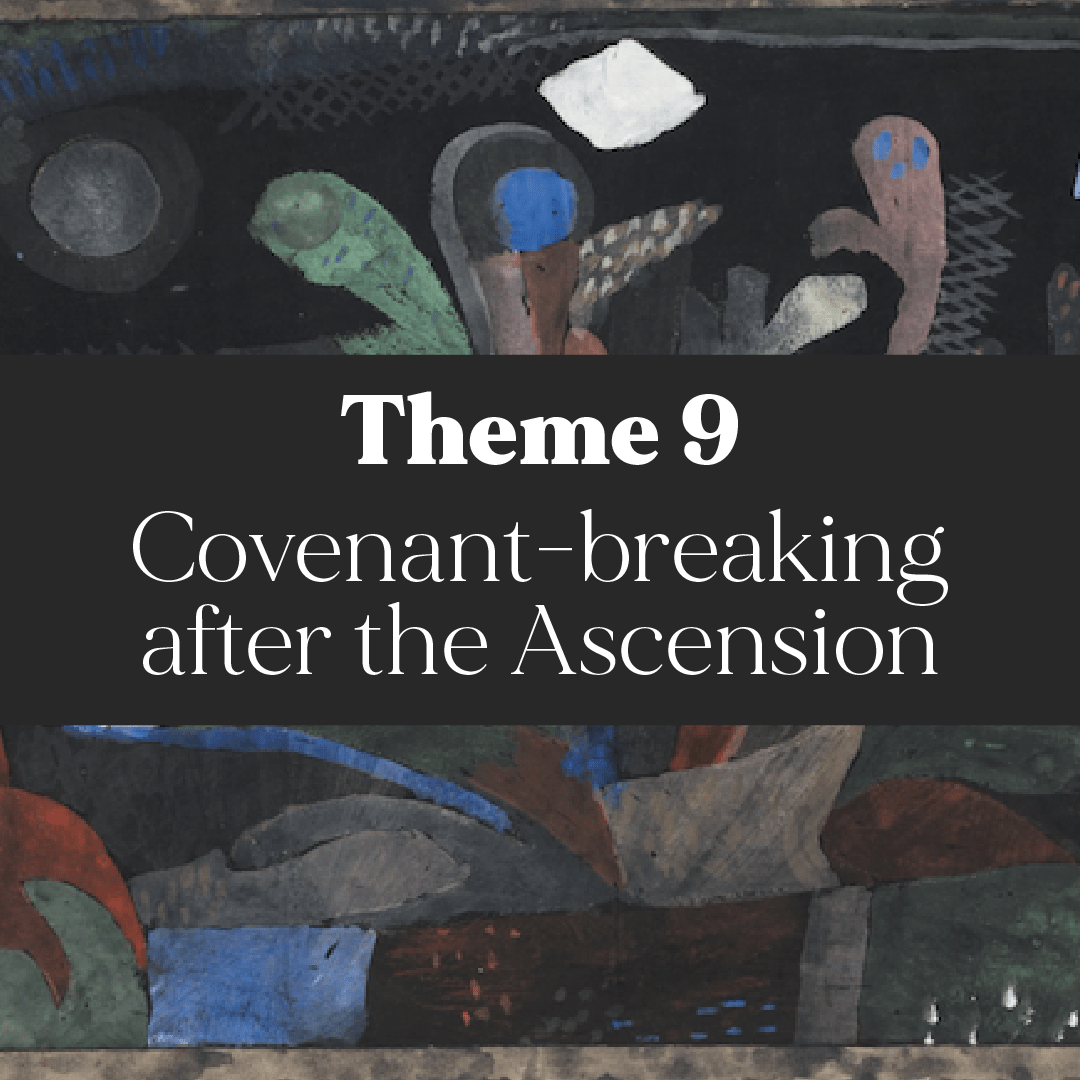
Background painting by Paul Klee: Picture of a garden in dark colours (1923). Source: Wikimedia Commons.
With the passing of Bahá’u’lláh and the fierce onslaught of the forces of disruption that followed in its wake, the Greatest Holy Leaf, now in the hey-day of her life, rose to the height of her great opportunity and acquitted herself worthily of her task. It would take me beyond the compass of the tribute I am moved to pay to her memory were I to dwell upon the incessant machinations to which Muḥammad-‘Alí, the arch-breaker of the Covenant of Bahá’u’lláh, and his despicable supporters basely resorted, upon the agitation which their cleverly-directed campaign of misrepresentation and calumny produced in quarters directly connected with Sulṭán ‘Abdu’l-Ḥamíd and his advisers, upon the trials and investigations to which it gave rise, upon the rigidity of the incarceration it reimposed, and upon the perils it revived. Suffice it to say that but for her sleepless vigilance, her tact, her courtesy, her extreme patience and heroic fortitude, grave complications might have ensued and the load of ‘Abdu’l‑Bahá’s anxious care would have been considerably increased.

Background painting by Paul Klee: Joyful Mountain Landscape (1929). Source: Wikimedia Commons.
And when the storm-cloud that had darkened the horizon of the Holy Land had been finally dissipated and the call raised by our beloved ‘Abdu’l‑Bahá had stirred to a new life certain cities of the American and European continents, the Most Exalted Leaf became the recipient of the unbounded affection and blessings of One Who could best estimate her virtues and appreciate her merits.
The decline of her precious life had by that time set in, and the burden of advancing age was beginning to becloud the radiance of her countenance. Forgetful of her own self, disdaining rest and comfort, and undeterred by the obstacles that still stood in her path, she, acting as the honoured hostess to a steadily increasing number of pilgrims who thronged ‘Abdu’l‑Bahá’s residence from both the East and the West, continued to display those same attributes that had won her, in the preceding phases of her career, so great a measure of admiration and love.
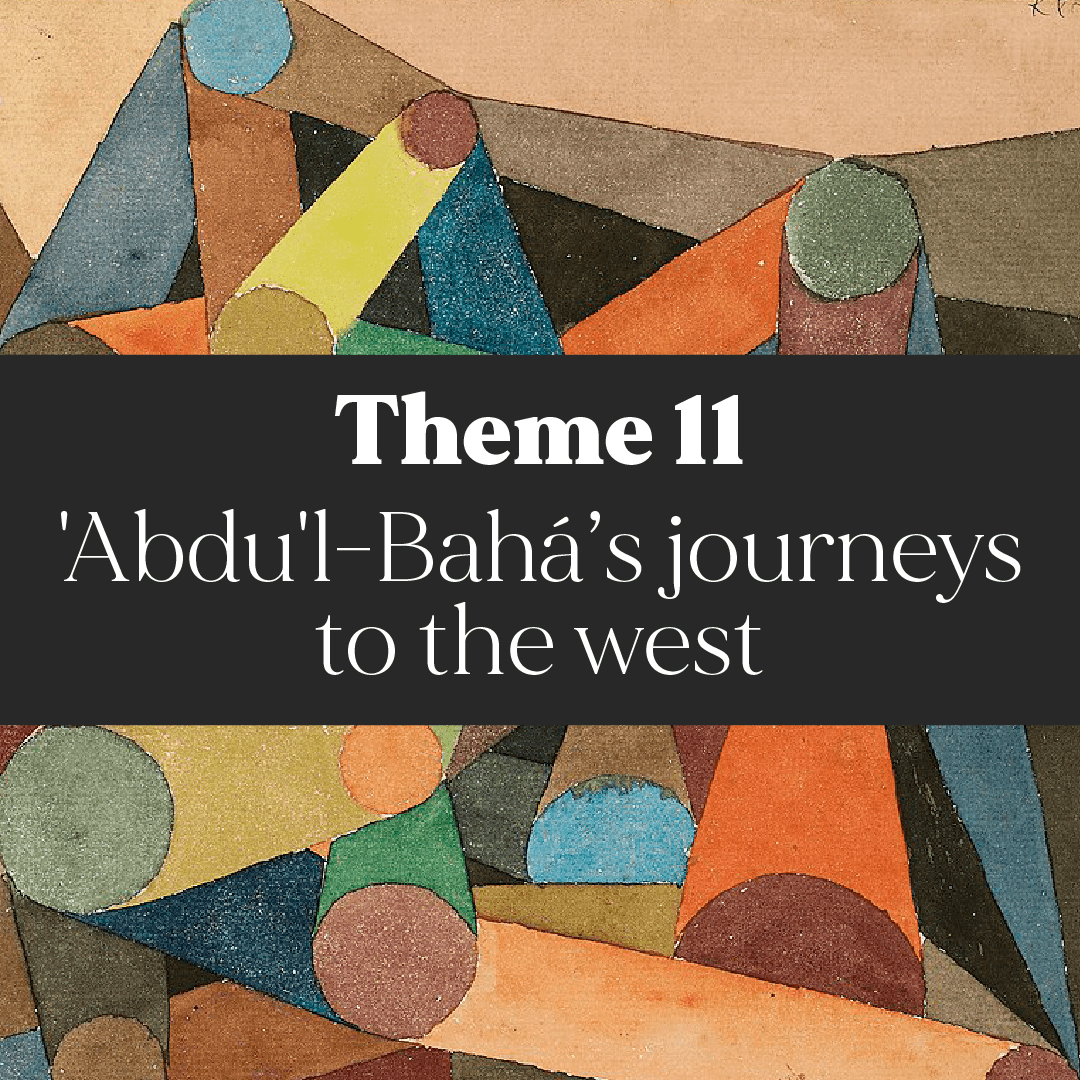
Background painting by Paul Klee: Open Mountain (1914). Source: Wikimedia Commons.
And when, in pursuance of God’s inscrutable Wisdom, the ban on ‘Abdu’l‑Bahá’s confinement was lifted and the Plan which He, in the darkest hours of His confinement, had conceived materialized, He with unhesitating confidence, invested His trusted and honoured sister with the responsibility of attending to the multitudinous details arising out of His protracted absence from the Holy Land.
No sooner had ‘Abdu’l‑Bahá stepped upon the shores of the European and American continents than our beloved Khánum found herself well-nigh overwhelmed with thrilling messages, each betokening the irresistible advance of the Cause in a manner which, notwithstanding the vast range of her experience, seemed to her almost incredible. The years in which she basked in the sunshine of ‘Abdu’l‑Bahá’s spiritual victories were, perhaps, among the brightest and happiest of her life. Little did she dream when, as a little girl, she was running about, in the courtyard of her Father’s house in Ṭihrán, in the company of Him Whose destiny was to be one day the chosen Center of God’s indestructible Covenant, that such a Brother would be capable of achieving, in realms so distant, and among races so utterly remote, so great and memorable a victory.
The enthusiasm and joy which swelled in her breast as she greeted ‘Abdu’l‑Bahá on His triumphant return from the West, I will not venture to describe. She was astounded at the vitality of which He had, despite His unimaginable sufferings, proved Himself capable. She was lost in admiration at the magnitude of the forces which His utterances had released. She was filled with thankfulness to Bahá’u’lláh for having enabled her to witness the evidences of such brilliant victory for His Cause no less than for His Son.

Background painting by Paul Klee: Persian Nightingales (7 July 1927). Source: Wikimedia Commons.
The outbreak of the Great War gave her yet another opportunity to reveal the true worth of her character and to release the latent energies of her heart. The residence of ‘Abdu’l‑Bahá in Haifa was besieged, all throughout that dreary conflict, by a concourse of famished men, women and children whom the maladministration, the cruelty and neglect of the officials of the Ottoman Government had driven to seek an alleviation to their woes. From the hand of the Greatest Holy Leaf, and out of the abundance of her heart, these hapless victims of a contemptible tyranny, received day after day unforgettable evidences of a love they had learned to envy and admire. Her words of cheer and comfort, the food, the money, the clothing she freely dispensed, the remedies which, by a process of her own, she herself prepared and diligently applied—all these had their share in comforting the disconsolate, in restoring sight to the blind, in sheltering the orphan, in healing the sick, and in succoring the homeless and the wanderer.
She had reached, amidst the darkness of the war days, the high water-mark of her spiritual attainments. Few, if any, among the unnumbered benefactors of society whose privilege has been to allay, in various measures, the hardships and sufferings entailed by that Fierce Conflict, gave as freely and as disinterestedly as she did; few exercised that undefinable influence upon the beneficiaries of their gifts.
Age seemed to have accentuated the tenderness of her loving heart, and to have widened still further the range of her sympathies. The sight of appalling suffering around her steeled her energies and revealed such potentialities that her most intimate associates had failed to suspect.

Background painting by Paul Klee: River engineering landscape (1924). Source: Wikimedia Commons.
The ascension of ‘Abdu’l‑Bahá, so tragic in its suddenness, was to her a terrific blow, from the effects of which she never completely recovered. To her He, whom she called “Áqá,” had been a refuge in times of adversity. On Him she had been led to place her sole reliance. In Him she had found ample compensation for the bereavements she had suffered, the desertions she had witnessed, the ingratitude she had been shown by friends and kindreds. No one could ever dream that a woman of her age, so frail in body, so sensitive of heart, so loaded with the cares of almost eighty years of incessant tribulation, could so long survive so shattering a blow. And yet history, no less than the annals of our immortal Faith, shall record for her a share in the advancement and consolidation of the world-wide community which the hand of ‘Abdu’l‑Bahá had helped to fashion, which no one among the remnants of His Family can rival.
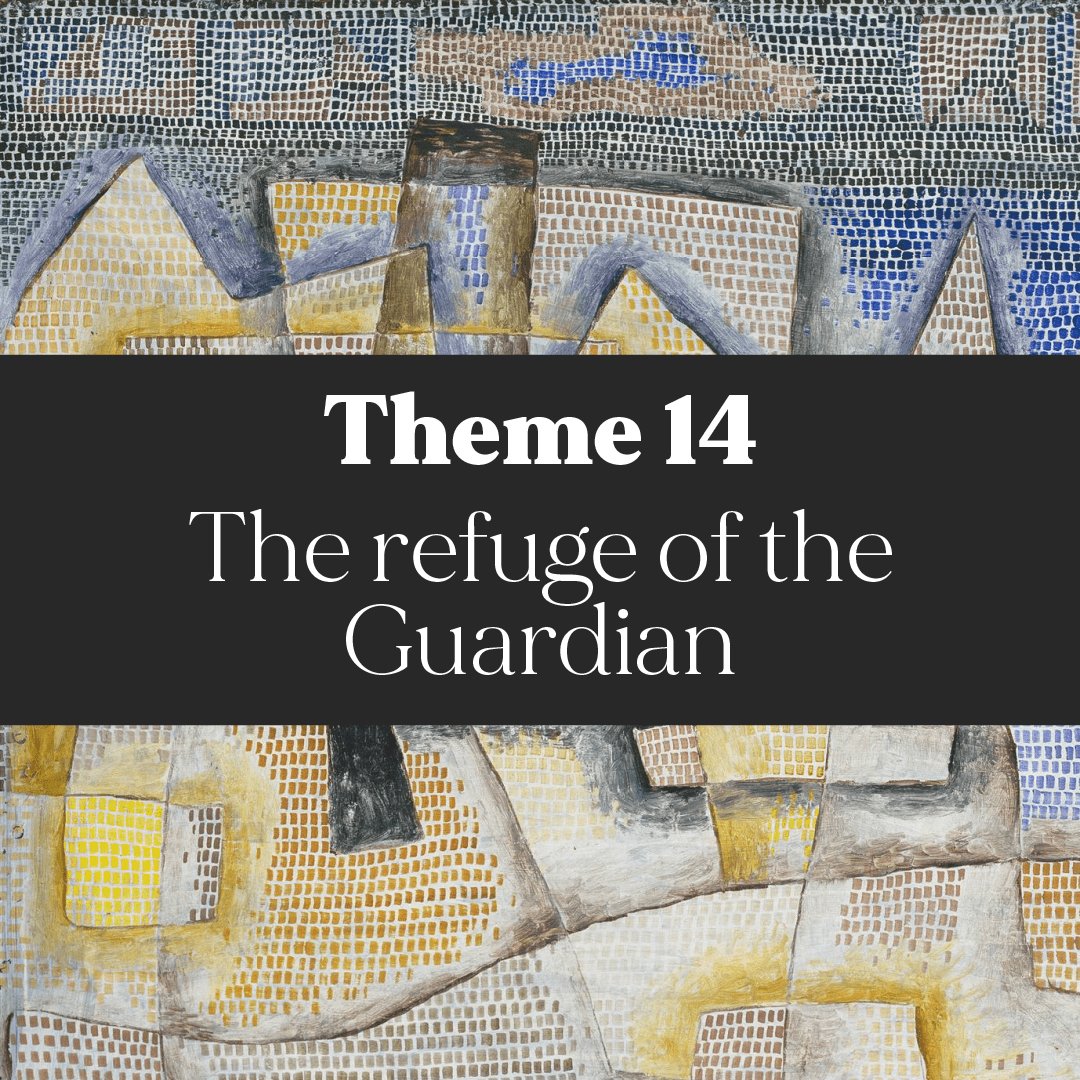
Background painting by Paul Klee: Rocky Coast (1 January 1931). Source: Wikimedia Commons
Which of the blessings am I to recount, which in her unfailing solicitude she showered upon me, in the most critical and agitated hours of my life? To me, standing in so dire a need of the vitalizing grace of God, she was the living symbol of many an attribute I had learned to admire in ‘Abdu’l‑Bahá. She was to me a continual reminder of His inspiring personality, of His calm resignation, of His munificence and magnanimity. To me she was an incarnation of His winsome graciousness, of His all-encompassing tenderness and love.

Background painting by Paul Klee: Translucencies, Orange-Blue (1915). Source: Wikimedia Commons.
It would take me too long to make even a brief allusion to those incidents of her life, each of which eloquently proclaims her as a daughter, worthy to inherit that priceless heritage bequeathed to her by Bahá’u’lláh. A purity of life that reflected itself in even the minutest details of her daily occupations and activities; a tenderness of heart that obliterated every distinction of creed, class and color; a resignation and serenity that evoked to the mind the calm and heroic fortitude of the Báb; a natural fondness of flowers and children that was so characteristic of Bahá’u’lláh; an unaffected simplicity of manners; an extreme sociability which made her accessible to all; a generosity, a love, at once disinterested and indiscriminating, that reflected so clearly the attributes of ‘Abdu’l‑Bahá’s character; a sweetness of temper; a cheerfulness that no amount of sorrow could becloud; a quiet and unassuming disposition that served to enhance a thousandfold the prestige of her exalted rank; a forgiving nature that instantly disarmed the most unyielding enemy—these rank among the outstanding attributes of a saintly life which history will acknowledge as having been endowed with a celestial potency that few of the heroes of the past possessed.
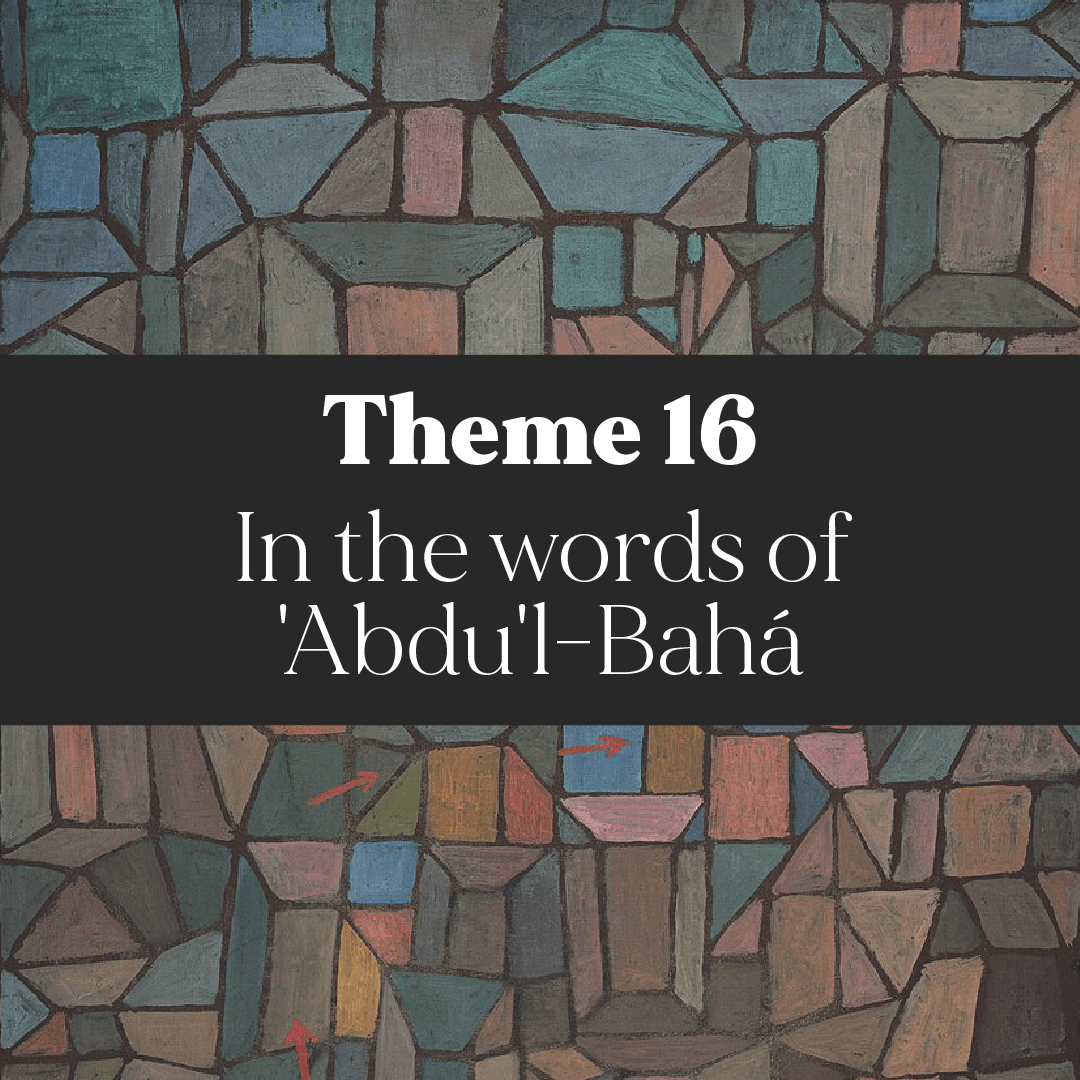
Background painting by Paul Klee: The Way to the Citadel (1929). Source: Wikimedia Commons.
No wonder that in Tablets, which stand as eternal testimonies to the beauty of her character, Bahá’u’lláh and ‘Abdu’l‑Bahá have paid touching tributes to those things that testify to her exalted position among the members of their Family, that proclaim her as an example to their followers, and as an object worthy of the admiration of all mankind.
I need only, at this juncture, quote the following passage from a Tablet addressed by ‘Abdu’l‑Bahá to the Holy Mother, the tone of which reveals unmistakably the character of those ties that bound Him to so precious, so devoted a sister:
“To my honored and distinguished sister do thou convey the expression of my heartfelt, my intense longing. Day and night she liveth in my remembrance. I dare make no mention of the feelings which separation from her has aroused in my heart, for whatever I should attempt to express in writing will assuredly be effaced by the tears which such sentiments must bring to my eyes.”

Background painting by Paul Klee: With the Rainbow (1917). Source: Wikimedia Commons.
Dearly-beloved Greatest Holy Leaf! Through the mist of tears that fill my eyes I can clearly see, as I pen these lines, thy noble figure before me, and can recognize the serenity of thy kindly face. I can still gaze, though the shadow of the grave separate us, into thy blue, love-deep eyes, and can feel, in its calm intensity, the immense love thou didst bear for the Cause of thine Almighty Father, the attachment that bound thee to the most lowly and insignificant among its followers, the warm affection thou didst cherish for me in thine heart. The memory of the ineffable beauty of thy smile shall ever continue to cheer and hearten me in the thorny path I am destined to pursue. The remembrance of the touch of thine hand shall spur me on to follow steadfastly in thy way. The sweet magic of thy voice shall remind me, when the hour of adversity is at its darkest, to hold fast to the rope thou didst seize so firmly all the days of thy life.

Background painting by Paul Klee: The Beautiful Gardener (1939). Source: Wikimedia Commons.
Bear thou this my message to ‘Abdu’l‑Bahá, thine exalted and divinely-appointed Brother: If the Cause for which Bahá’u’lláh toiled and labored, for which Thou didst suffer years of agonizing sorrow, for the sake of which streams of sacred blood have flowed, should, in the days to come, encounter storms more severe than those it has already weathered, do Thou continue to overshadow, with Thine all-encompassing care and wisdom, Thy frail, Thy unworthy appointed child.
Intercede, O noble and well-favoured scion of a heavenly Father, for me no less than for the toiling masses of Thy ardent lovers, who have sworn undying allegiance to Thy memory, whose souls have been nourished by the energies of Thy love, whose conduct has been moulded by the inspiring example of Thy life, and whose imaginations are fired by the imperishable evidences of Thy lively faith, Thy unshakable constancy, Thy invincible heroism, Thy great renunciation.
Whatever betide us, however distressing the vicissitudes which the nascent Faith of God may yet experience, we pledge ourselves, before the mercy-seat of thy glorious Father, to hand on, unimpaired and undivided, to generations yet unborn, the glory of that tradition of which thou hast been its most brilliant exemplar.
In the innermost recesses of our hearts, O thou exalted Leaf of the Abhá Paradise, we have reared for thee a shining mansion that the hand of time can never undermine, a shrine which shall frame eternally the matchless beauty of thy countenance, an altar whereon the fire of thy consuming love shall burn forever.
Shoghi.
Haifa, Palestine.
July 17, 1932.
SOURCES FOR PART XIII
25 October 1929: “Deepening shadows”
The Priceless Pearl, Rúḥíyyih Rabbání, Bahá’í Publishing Trust, London, 1969, pages 144-146.
Bahá’í Administration, Shoghi Effendi, 25 October 1929.
21 March 1932: “Hovering on the edge of the Great Beyond”
The Priceless Pearl, Rúḥíyyih Rabbání, Bahá’í Publishing Trust, London, 1969, pages 144-146.
Bahá’í Administration, Shoghi Effendi, 25 October 1929.
The World Order of Bahá’u’lláh, Shoghi Effendi, 21 March 1932: The Golden Age of the Cause of Bahá’u’lláh: Our Beloved Temple.
June – July 1932: The last days of the Greatest Holy Leaf
Prophet’s Daughter: The Life and Legacy of Bahíyyih Khánum, Outstanding Heroine of the Bahá’í Faith. Janet A. Khan, Bahá’í Publishing Trust, Wilmette, 2005, page 211
Bahíyyih Khánum, Marjorie Morten, published in The Bahá’í World, Volume 5 (1932-1934), pages 181-185.
The Greatest Holy Leaf at the close of her life
Prophet’s Daughter: The Life and Legacy of Bahíyyih Khánum, Outstanding Heroine of the Bahá’í Faith. Janet A. Khan, Bahá’í Publishing Trust, Wilmette, 2005, page 211
15 July 1932: The passing of the Greatest Holy Leaf
The Priceless Pearl, Rúḥíyyih Rabbání, Bahá’í Publishing Trust, London, 1969, pages 144-146.
Prophet’s Daughter: The Life and Legacy of Bahíyyih Khánum, Outstanding Heroine of the Bahá’í Faith, Janet A. Khan, Bahá’í Publishing Trust, Wilmette, 2005, page 212.
15 July 1932: The printed announcement
The Greatest Holy Leaf: A Reminiscence, ‘Alí Nakhjávání, published in The Bahá’í World, Volume 18 (1979-1983), pages 59-67.
15 July 1932 in Interlaken: The Guardian learns of the passing of the Greatest Holy Leaf
The Priceless Pearl, Rúḥíyyih Rabbání, Bahá’í Publishing Trust, London, 1969, pages 144-146.
Prophet’s Daughter: The Life and Legacy of Bahíyyih Khánum, Outstanding Heroine of the Bahá’í Faith. Janet A. Khan, Bahá’í Publishing Trust, Wilmette, 2005.
Shoghi Effendi’s double tragedy
Violetta Zein, The Guardian: The illustrated chronology of the life and work of Shoghi Effendi Part X: The passing of the Greatest Holy Leaf and The Dispensation of Bahá’u’lláh (1932 – 1936)
The Priceless Pearl, Rúḥíyyih Rabbání, Bahá’í Publishing Trust, London, 1969, pages 147-148.
Maxwells of Montreal, The: Middle Years 1923-1937 Late Years 1937-1952. Violette Nakhjavani, George Ronald, Oxford (2011), Kindle Edition, Location 5440.
Prophet’s Daughter: The Life and Legacy of Bahíyyih Khánum, Outstanding Heroine of the Bahá’í Faith, Janet A. Khan, Bahá’í Publishing Trust, Wilmette, 2005, page 212.
“I was prevented from being with her”
Violetta Zein, The Guardian: The illustrated chronology of the life and work of Shoghi Effendi Part X: The passing of the Greatest Holy Leaf and The Dispensation of Bahá’u’lláh (1932 – 1936)
The Priceless Pearl, Rúḥíyyih Rabbání, Bahá’í Publishing Trust, London, 1969, pages 147-148.
Maxwells of Montreal, The: Middle Years 1923-1937 Late Years 1937-1952. Violette Nakhjavani, George Ronald, Oxford (2011), Kindle Edition, Location 5440.
Prophet’s Daughter: The Life and Legacy of Bahíyyih Khánum, Outstanding Heroine of the Bahá’í Faith, Janet A. Khan, Bahá’í Publishing Trust, Wilmette, 2005, page 212.
15 July 1932: Bahíyyih Khánum’s services to the Faith
Bahíyyih Khánum: The Greatest Holy Leaf by Bahá’u’lláh, Abdu’l-Bahá, Shoghi Effendi, and Bahíyyih Khánum, compiled by Research Department of the Universal House of Justice Haifa: Bahá’í World Centre Publications (1982): 15 July 1932, to the National Spiritual Assembly of the Bahá’ís of the British Isles.
15 July 1932: The Guardian’s first cable announcing the passing of the Greatest Holy Leaf
The Priceless Pearl, Rúḥíyyih Rabbání, Bahá’í Publishing Trust, London, 1969, pages 144-146.
Prophet’s Daughter: The Life and Legacy of Bahíyyih Khánum, Outstanding Heroine of the Bahá’í Faith. Janet A. Khan, Bahá’í Publishing Trust, Wilmette, 2005.
The Guardian’s cable to Persia
Leaves of the Twin Divine Trees, Baharieh Rouhani Ma’ani, George Ronald, Oxford, 2013, page 209
15 July 1932: The Guardian’s letter to Persian Bahá’ís
Prophet’s Daughter: The Life and Legacy of Bahíyyih Khánum, Outstanding Heroine of the Bahá’í Faith, Janet A. Khan, Bahá’í Publishing Trust, Wilmette, 2005, pages 223-224. And 223-226.
Bahíyyih Khánum: The Greatest Holy Leaf by Bahá’u’lláh, Abdu’l-Bahá, Shoghi Effendi, and Bahíyyih Khánum, compiled by Research Department of the Universal House of Justice Haifa: Bahá’í World Centre Publications (1982):
Letter from Shoghi Effendi dated 15 July 1932, to the Bahá’ís of the East. (Translated from the Persian).
Immediately after 17 July 1932: The Guardian’s plans for the Greatest Holy Leaf’s monument
The Priceless Pearl, Rúḥíyyih Rabbání, Bahá’í Publishing Trust, London, 1969, pages 144-146.
Prophet’s Daughter: The Life and Legacy of Bahíyyih Khánum, Outstanding Heroine of the Bahá’í Faith. Janet A. Khan, Bahá’í Publishing Trust, Wilmette, 2005.
15 July 1932: The funeral of the Greatest Holy Leaf
The Priceless Pearl, Rúḥíyyih Rabbání, Bahá’í Publishing Trust, London, 1969, pages 144-146.
Prophet’s Daughter: The Life and Legacy of Bahíyyih Khánum, Outstanding Heroine of the Bahá’í Faith, Janet A. Khan, Bahá’í Publishing Trust, Wilmette, 2005, page 216.
Prophet’s Daughter: The Life and Legacy of Bahíyyih Khánum, Outstanding Heroine of the Bahá’í Faith, Janet A. Khan, Bahá’í Publishing Trust, Wilmette, 2005, pages 215-216.
21 July 1932: An obituary for the Greatest Holy Leaf is published in Wyoming
Source: Newspapers.com.
The people of ‘Akká and Haifa insist on paying their last respects to the Greatest Holy Leaf
Prophet’s Daughter: The Life and Legacy of Bahíyyih Khánum, Outstanding Heroine of the Bahá’í Faith, Janet A. Khan, Bahá’í Publishing Trust, Wilmette, 2005, pages 215-216.
25 August 1932: The fortieth-day memorial feast for the Greatest Holy Leaf
Prophet’s Daughter: The Life and Legacy of Bahíyyih Khánum, Outstanding Heroine of the Bahá’í Faith, Janet A. Khan, Bahá’í Publishing Trust, Wilmette, 2005, page 216-217.
The Guardian’s presence in spirit at the fortieth-day memorial feast
Prophet’s Daughter: The Life and Legacy of Bahíyyih Khánum, Outstanding Heroine of the Bahá’í Faith, Janet A. Khan, Bahá’í Publishing Trust, Wilmette, 2005, page 216-217.
This Decisive Hour: 15 July 1932 cable from Shoghi Effendi titled “Immortal Spirit.”
Prophet’s Daughter: The Life and Legacy of Bahíyyih Khánum, Outstanding Heroine of the Bahá’í Faith, Janet A. Khan, Bahá’í Publishing Trust, Wilmette, 2005, pages 217-218.
This Decisive Hour: 15 July 1932 cable from Shoghi Effendi titled “Immortal Spirit.”
Prophet’s Daughter: The Life and Legacy of Bahíyyih Khánum, Outstanding Heroine of the Bahá’í Faith, Janet A. Khan, Bahá’í Publishing Trust, Wilmette, 2005, pages 217-218.
15 July 1932 – 15 April 1933: Nine of months of mourning for the Greatest Holy Leaf
This Decisive Hour: 15 July 1932 cable from Shoghi Effendi titled “Immortal Spirit.”
Prophet’s Daughter: The Life and Legacy of Bahíyyih Khánum, Outstanding Heroine of the Bahá’í Faith, Janet A. Khan, Bahá’í Publishing Trust, Wilmette, 2005, pages 217-218.
Prophet’s Daughter: The Life and Legacy of Bahíyyih Khánum, Outstanding Heroine of the Bahá’í Faith, Janet A. Khan, Bahá’í Publishing Trust, Wilmette, 2005, page 223.
Prophet’s Daughter: The Life and Legacy of Bahíyyih Khánum, Outstanding Heroine of the Bahá’í Faith, Janet A. Khan, Bahá’í Publishing Trust, Wilmette, 2005, pages 221-223.
Keith Ransom-Kehler speaks about the Greatest Holy Leaf in Persia
Prophet’s Daughter: The Life and Legacy of Bahíyyih Khánum, Outstanding Heroine of the Bahá’í Faith, Janet A. Khan, Bahá’í Publishing Trust, Wilmette, 2005, pages 221-223.
Bahíyyih Khánum: The Greatest Holy Leaf by Bahá’u’lláh, Abdu’l-Bahá, Shoghi Effendi, and Bahíyyih Khánum, compiled by Research Department of the Universal House of Justice Haifa: Bahá’í World Centre Publications (1982): Shoghi Effendi letter dated 1 September 1932, to the National Spiritual Assembly of the Bahá’ís of the United States and Canada
The effect of Shoghi Effendi’s letters on the Bahá’í world
Prophet’s Daughter: The Life and Legacy of Bahíyyih Khánum, Outstanding Heroine of the Bahá’í Faith, Janet A. Khan, Bahá’í Publishing Trust, Wilmette, 2005, page 225-226.
23 August 1932: The Guardian’s letter to the Bahá’ís of Yonkers, New York
Prophet’s Daughter: The Life and Legacy of Bahíyyih Khánum, Outstanding Heroine of the Bahá’í Faith, Janet A. Khan, Bahá’í Publishing Trust, Wilmette, 2005, page 225-226.
Bahíyyih Khánum: The Greatest Holy Leaf by Bahá’u’lláh, Abdu’l-Bahá, Shoghi Effendi, and Bahíyyih Khánum, compiled by Research Department of the Universal House of Justice Haifa: Bahá’í World Centre Publications (1982):
23 August 1932, to the Spiritual Assembly of the Bahá’ís of Yonkers, N.Y.
30 August 1932: The Guardian’s letter to the Bahá’ís of Racine, Wisconsin
Prophet’s Daughter: The Life and Legacy of Bahíyyih Khánum, Outstanding Heroine of the Bahá’í Faith, Janet A. Khan, Bahá’í Publishing Trust, Wilmette, 2005, page 225-226.
Bahíyyih Khánum: The Greatest Holy Leaf by Bahá’u’lláh, Abdu’l-Bahá, Shoghi Effendi, and Bahíyyih Khánum, compiled by Research Department of the Universal House of Justice Haifa: Bahá’í World Centre Publications (1982):
Letter from Shoghi Effendi dated 30 August 1932, to the Spiritual Assembly of the Bahá’ís of Racine, Wisconsin
1 September 1932: The Guardian’s letter to the Bahá’í of Washington, D.C.
Prophet’s Daughter: The Life and Legacy of Bahíyyih Khánum, Outstanding Heroine of the Bahá’í Faith, Janet A. Khan, Bahá’í Publishing Trust, Wilmette, 2005, pages 223-224. And 223-226.
Bahíyyih Khánum: The Greatest Holy Leaf by Bahá’u’lláh, Abdu’l-Bahá, Shoghi Effendi, and Bahíyyih Khánum, compiled by Research Department of the Universal House of Justice Haifa: Bahá’í World Centre Publications (1982):
Letter from Shoghi Effendi dated 1 September 1932, to the Bahá’ís of Washington, D.C.
10 September 1932: The Guardian responds to the Bahá’ís of Glendale, California
Prophet’s Daughter: The Life and Legacy of Bahíyyih Khánum, Outstanding Heroine of the Bahá’í Faith, Janet A. Khan, Bahá’í Publishing Trust, Wilmette, 2005, pages 223-224. And 223-226.
Bahíyyih Khánum: The Greatest Holy Leaf by Bahá’u’lláh, Abdu’l-Bahá, Shoghi Effendi, and Bahíyyih Khánum, compiled by Research Department of the Universal House of Justice Haifa: Bahá’í World Centre Publications (1982):
Letter from Shoghi Effendi dated 10 September 1932, to the Bahá’ís of Glendale, California.
11 October 1932: The Guardian’s letter to the Bahá’ís of Teaneck, New Jersey
Prophet’s Daughter: The Life and Legacy of Bahíyyih Khánum, Outstanding Heroine of the Bahá’í Faith, Janet A. Khan, Bahá’í Publishing Trust, Wilmette, 2005, pages 224-226. And 223-226.
Bahíyyih Khánum: The Greatest Holy Leaf by Bahá’u’lláh, Abdu’l-Bahá, Shoghi Effendi, and Bahíyyih Khánum, compiled by Research Department of the Universal House of Justice Haifa: Bahá’í World Centre Publications (1982):
Letter from Shoghi Effendi dated 11 October 1932, to the Spiritual Assembly of the Bahá’ís of Teaneck, New Jersey
13 December 1932: The Guardian’s response to the Persian Bahá’ís
Prophet’s Daughter: The Life and Legacy of Bahíyyih Khánum, Outstanding Heroine of the Bahá’í Faith, Janet A. Khan, Bahá’í Publishing Trust, Wilmette, 2005, pages 223-224. And 223-226.
Bahíyyih Khánum: The Greatest Holy Leaf by Bahá’u’lláh, Abdu’l-Bahá, Shoghi Effendi, and Bahíyyih Khánum, compiled by Research Department of the Universal House of Justice Haifa: Bahá’í World Centre Publications (1982):
Letter from Shoghi Effendi dated 13 December 1932, to the Bahá’ís of Iran. (Translated from the Persian).
Prophet’s Daughter: The Life and Legacy of Bahíyyih Khánum, Outstanding Heroine of the Bahá’í Faith, Janet A. Khan, Bahá’í Publishing Trust, Wilmette, 2005, pages 220-221.
13 December 1932: The Guardian’s request to the National Spiritual Assembly of Persia
Bahíyyih Khánum: The Greatest Holy Leaf by Bahá’u’lláh, Abdu’l-Bahá, Shoghi Effendi, and Bahíyyih Khánum, compiled by Research Department of the Universal House of Justice Haifa: Bahá’í World Centre Publications (1982): Letter from Shoghi Effendi dated 13 December 1932, to the Bahá’ís of Iran. (Translated from the Persian).
14 January 1933: The Guardian’s tribute to the Greatest Holy Leaf
Bahá’í News, Issue 74 (May1933).
The Bahá’í World Volume 5, pages 169-173.
1872 – 1932: 60 years of friendship between the Greatest Holy Leaf and Munírih Khánum
Leaves of the Twin Divine Trees, Baharieh Rouhani Ma’ani, George Ronald, Oxford, 2013, pages 351-353.
1933: Opening poem to Munírih Khánum’s Letter of Lament
Munírih Khanum: Memoirs and Letters: Letter of Lament (1933), Munírih Khanum translated by Sammireh Anwar Smith Los Angeles: Kalimat Press, 1986, pages 69-70.
1933: Munírih Khánum’s letter of lament for the Greatest Holy Leaf
Munírih Khanum: Memoirs and Letters: Letter of Lament (1933), Munírih Khanum translated by Sammireh Anwar Smith Los Angeles: Kalimat Press, 1986, pages 69-70.
Why the location of the Greatest Holy Leaf’s monument is so significant
The Greatest Holy Leaf’s Unparalleled Role in Religious History and the Significance of the Arc, the Site of Her Resting Place, Baharieh Rouhani Ma’ani, published in Lights of Irfan, 15, pages 199-228, Wilmette: Haj Mehdi Armand Colloquium, 2014, pages 199-200, 220,
The significance of the spot for the Greatest Holy Leaf’s resting place
Leaves of the Twin Divine Trees, Baharieh Rouhani Ma’ani, George Ronald, Oxford, 2013, pages 209-210.
August 1933: The Greatest Holy Leaf’s monument
Leaves of the Twin Divine Trees, Baharieh Rouhani Ma’ani, George Ronald, Oxford, 2013, pages 209-210.
The Priceless Pearl, Rúḥíyyih Rabbání, Bahá’í Publishing Trust, London, 1969, pages 146-147.
Leaves of the Twin Divine Trees. Baharieh Rouhani Ma’ani, George Ronald, Oxford, 2013, Kindle Edition, Chapter 7: Bahá’íyyih Khánum, the Most Outstanding Heroine of the Bahá’í Dispensation.
Bahá’í News, Issue 76 (August 1933).
Wikipedia: Carrara marble.
Zikrullah Khadem, The Itinerant Hand of the Cause of God. Javidukht Khadem, Bahá’í Publishing Trust, Wilmette, Ill. 1990, pages 292-293.
The Guardian unveils the Greatest Holy Leaf’s station to Bahá’ís
Prophet’s Daughter: The Life and Legacy of Bahíyyih Khánum, Outstanding Heroine of the Bahá’í Faith, Janet A. Khan, Bahá’í Publishing Trust, Wilmette, 2005, pages 218-219.
Shoghi Effendi’s remembrance of Bahíyyih Khánum
The Priceless Pearl, Rúḥíyyih Rabbání, Bahá’í Publishing Trust, London, 1969, pages 147-148.
Bahá’í Administration, 17 July 1932 letter from Shoghi Effendi regarding the passing of Bahíyyih Khánum to the Bahá’ís of the West.
17 July 1932 eulogy to the Greatest Holy Leaf in Shoghi Effendi’s own handwriting.
Leaves of the Twin Divine Trees. Baharieh Rouhani Ma’ani, George Ronald, Oxford, 2013, Kindle Edition, Chapter 7: Bahá’íyyih Khánum, the Most Outstanding Heroine of the Bahá’í Dispensation.
![]()
 25 October 1929: “Deepening shadows”
25 October 1929: “Deepening shadows”
